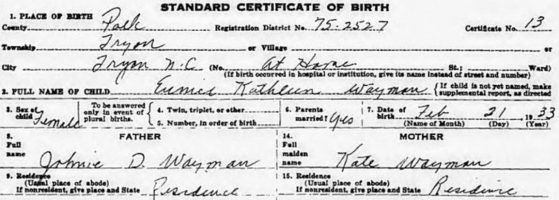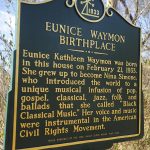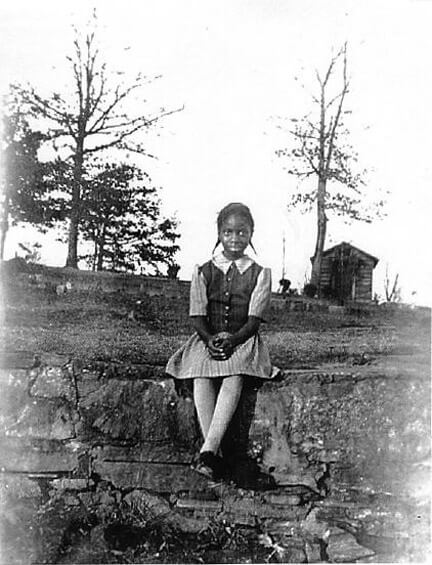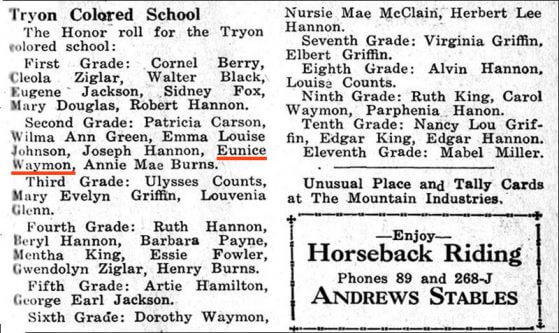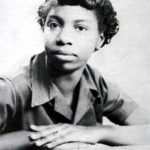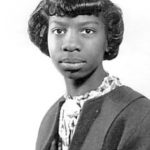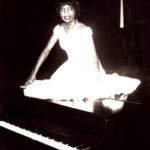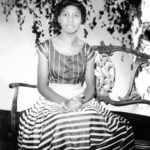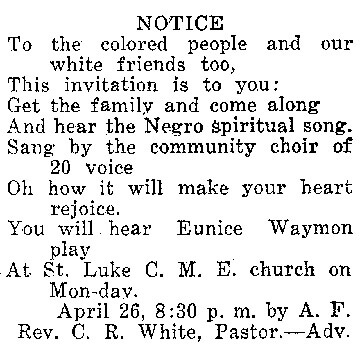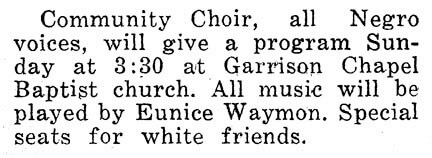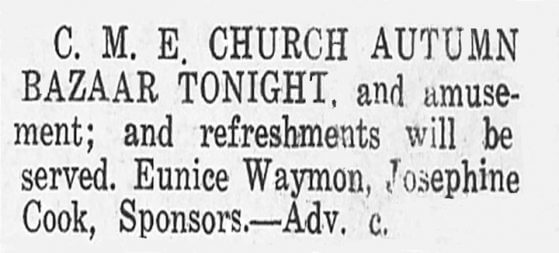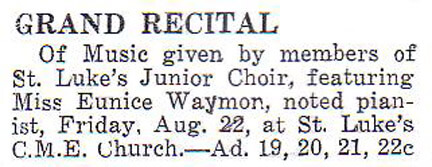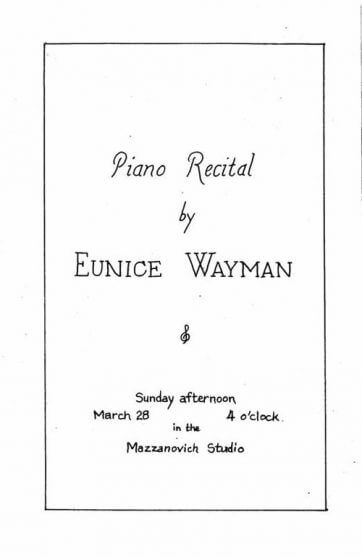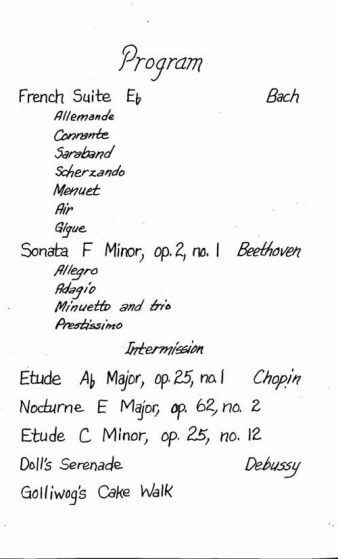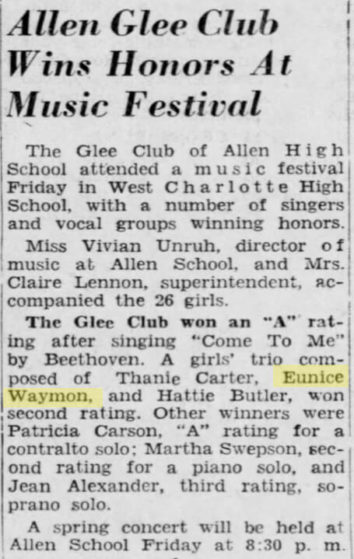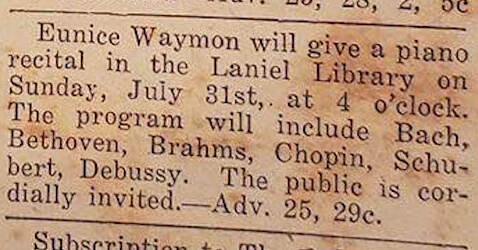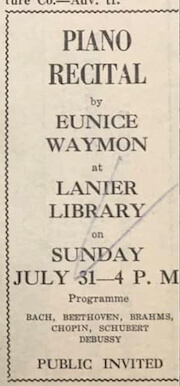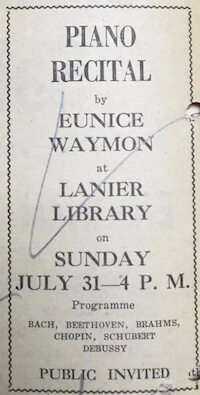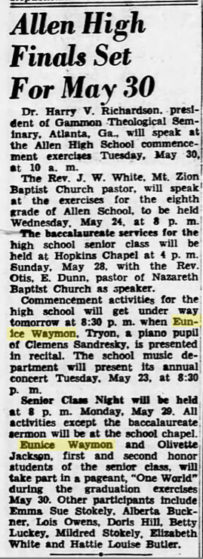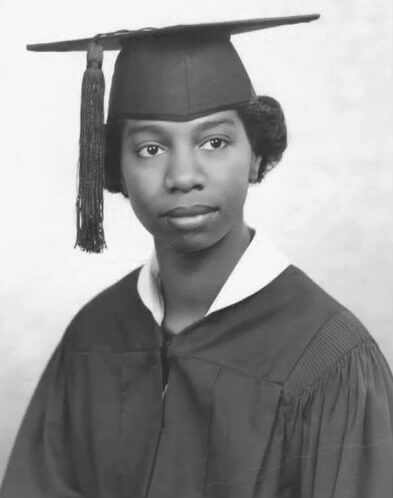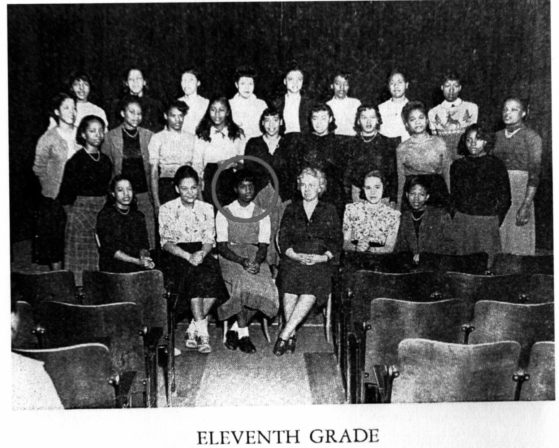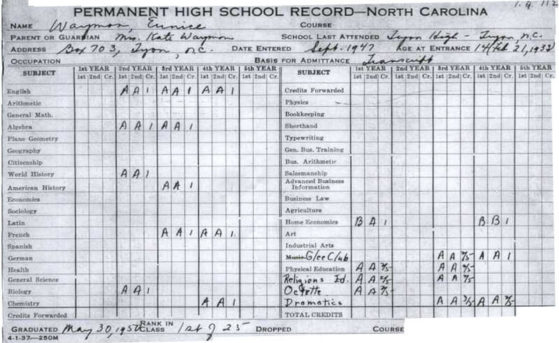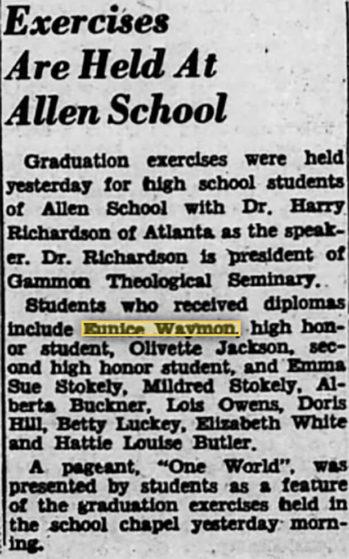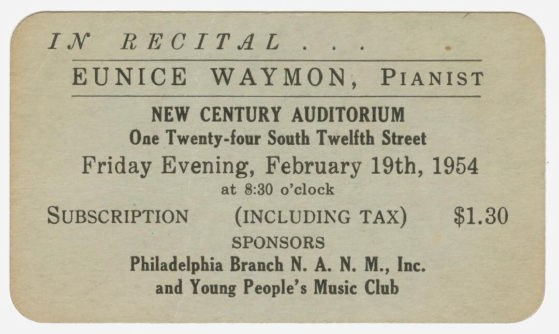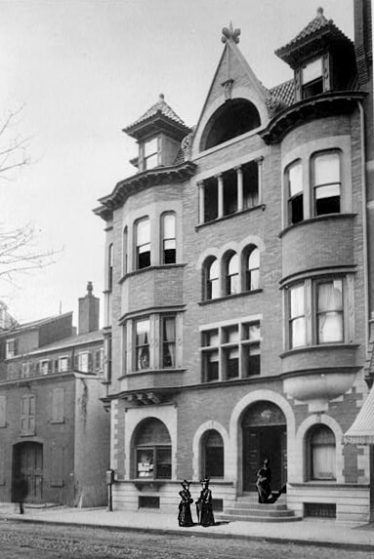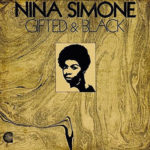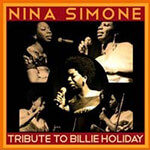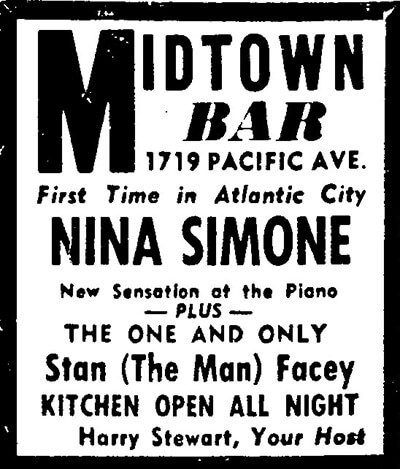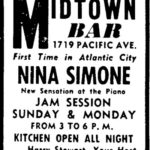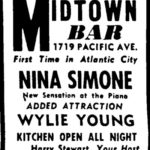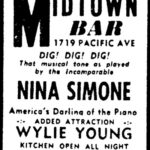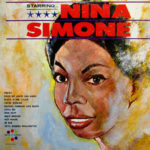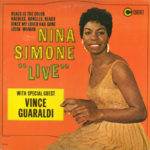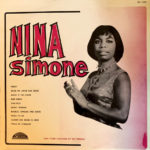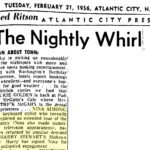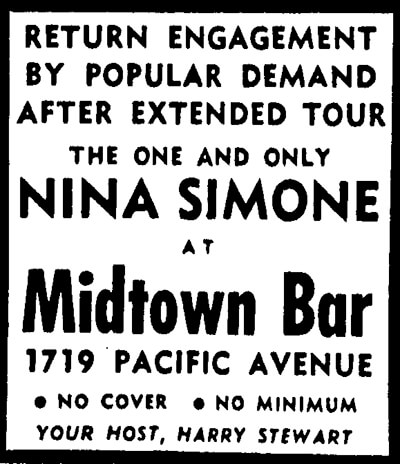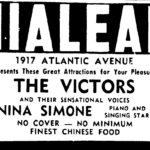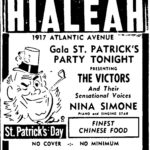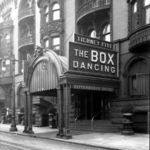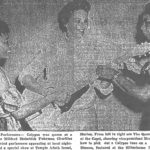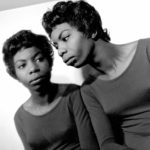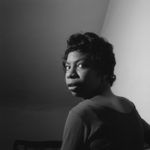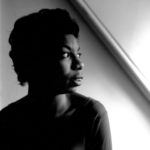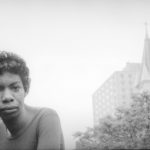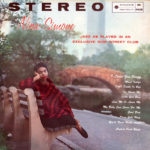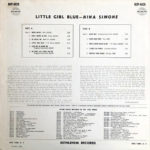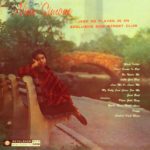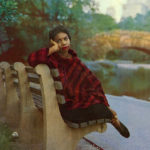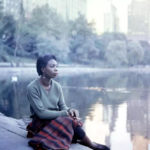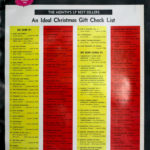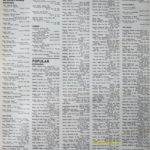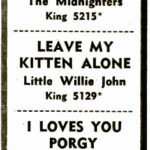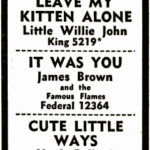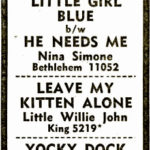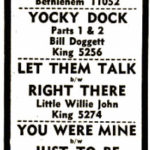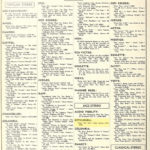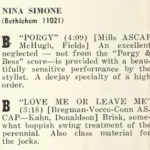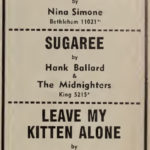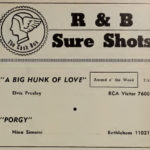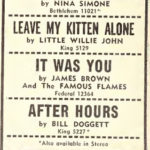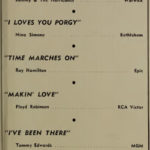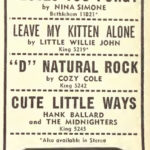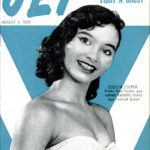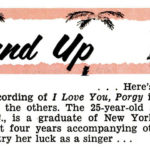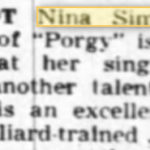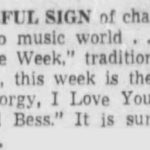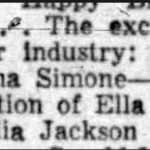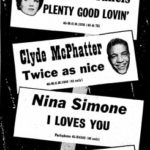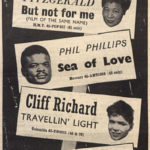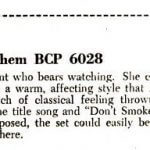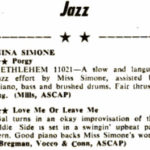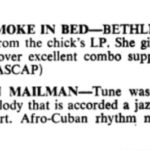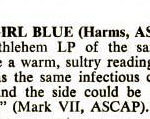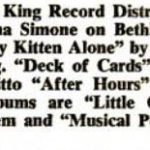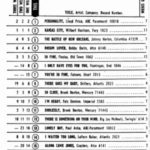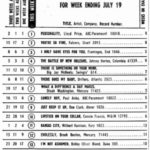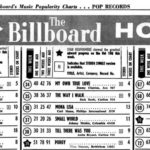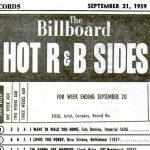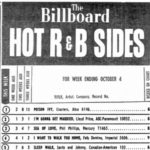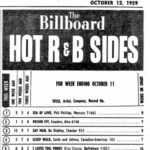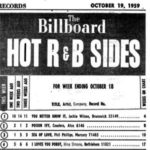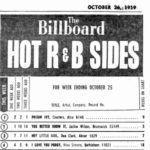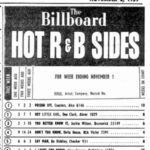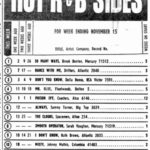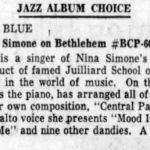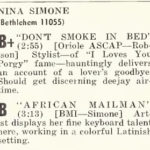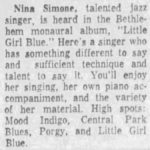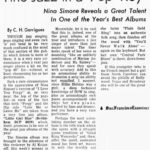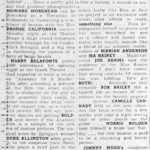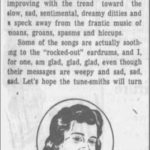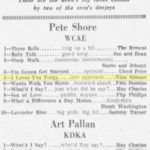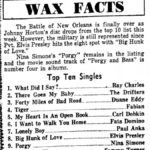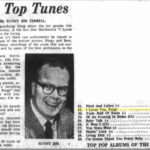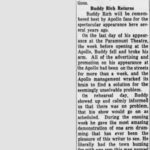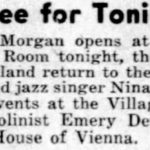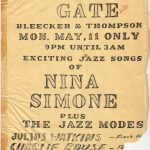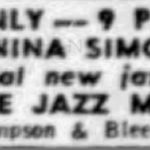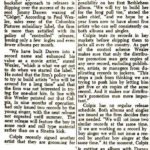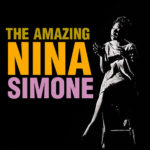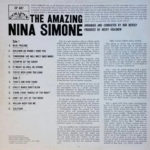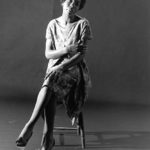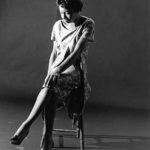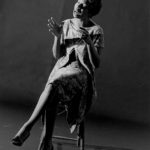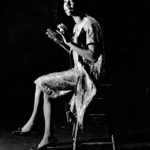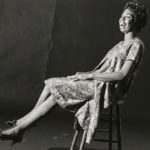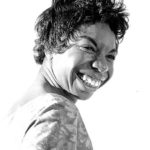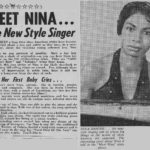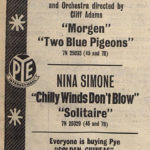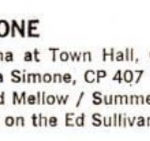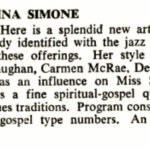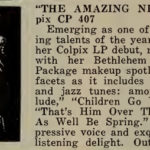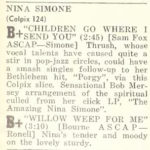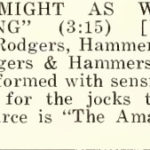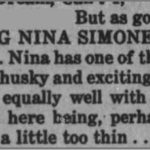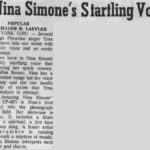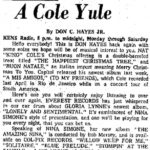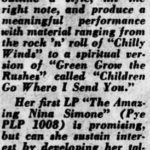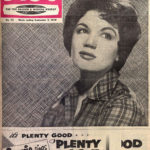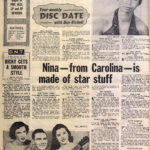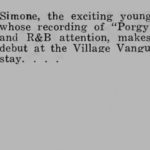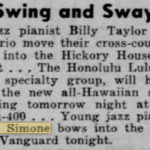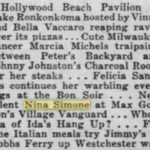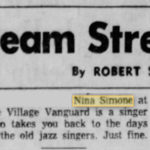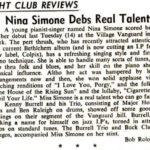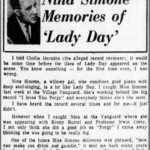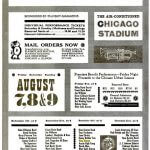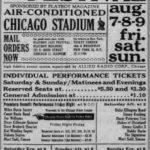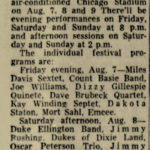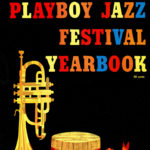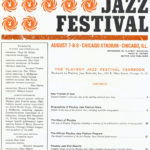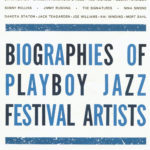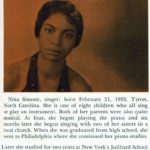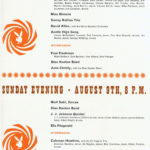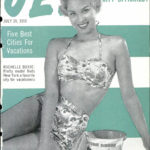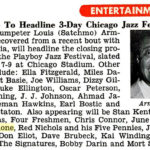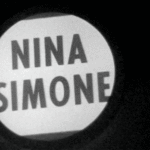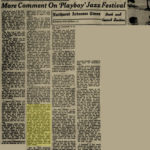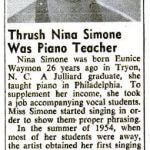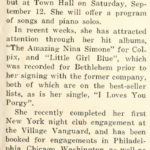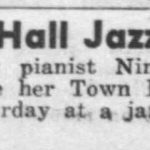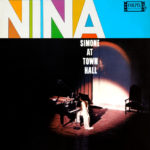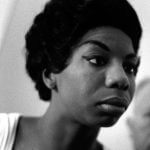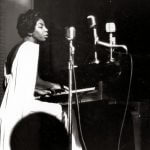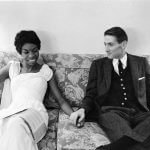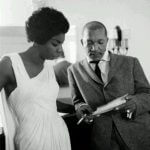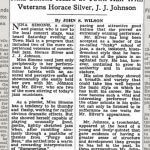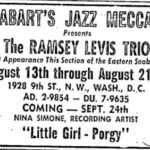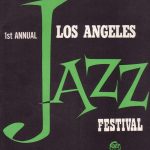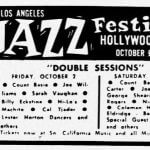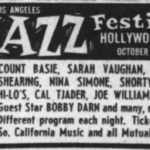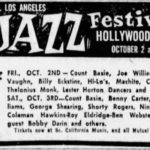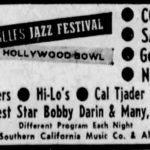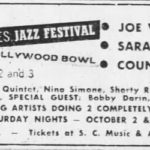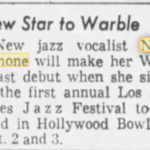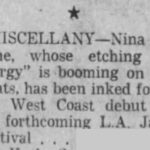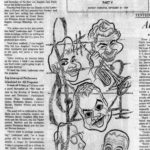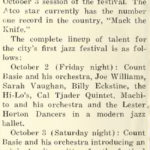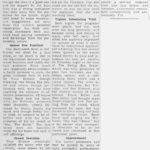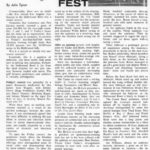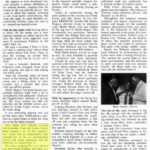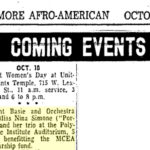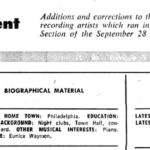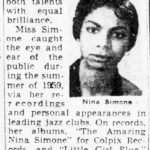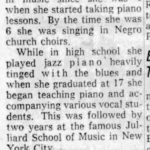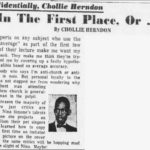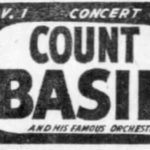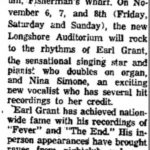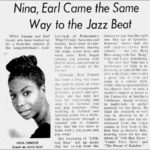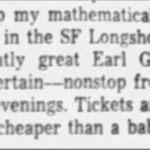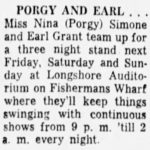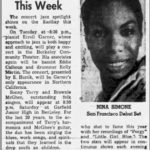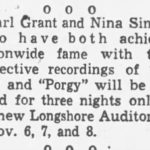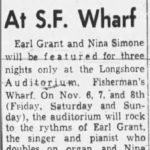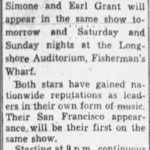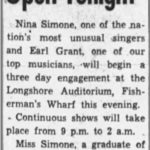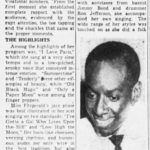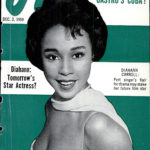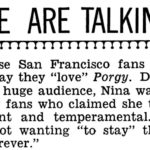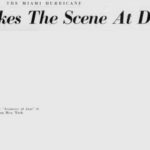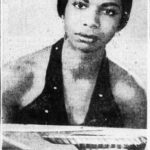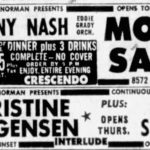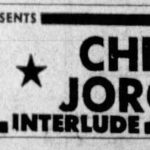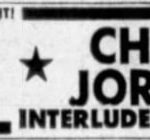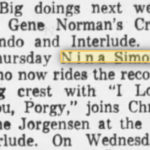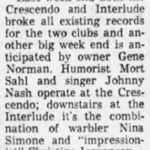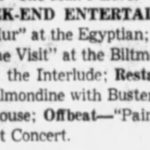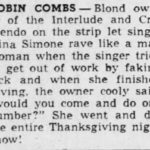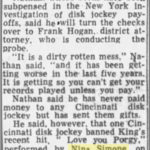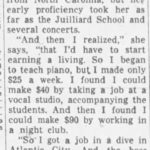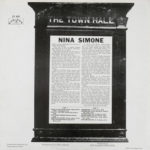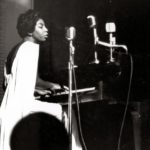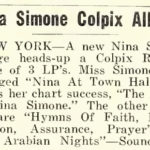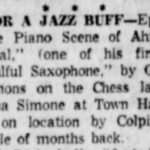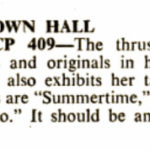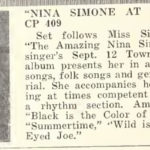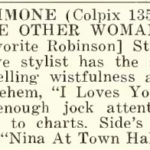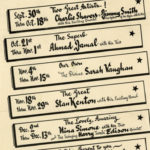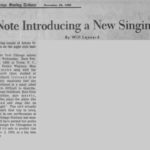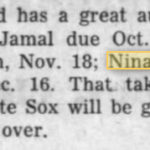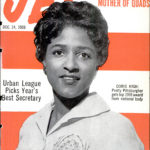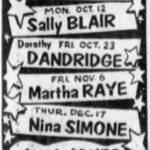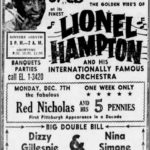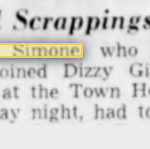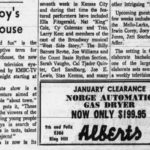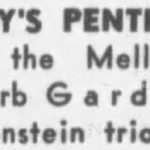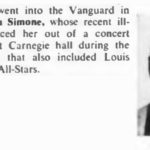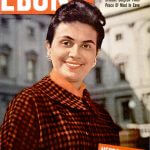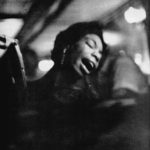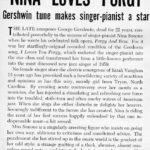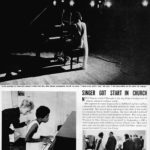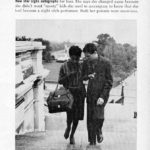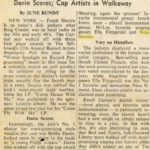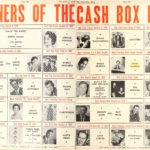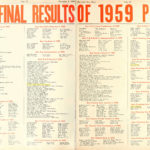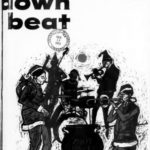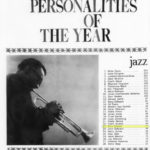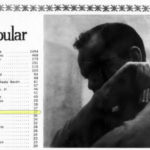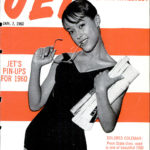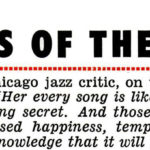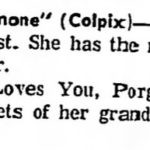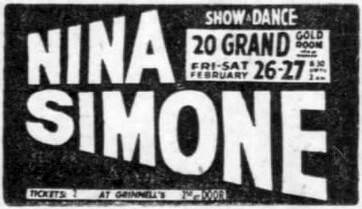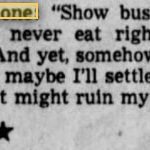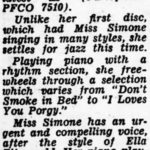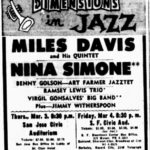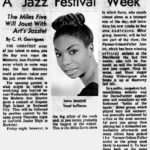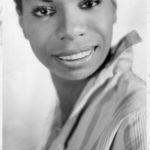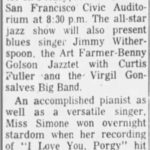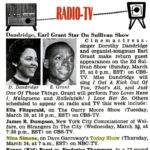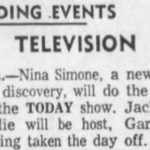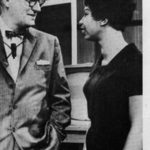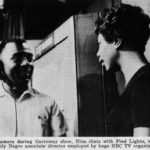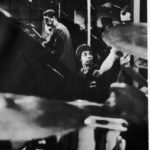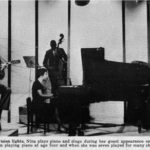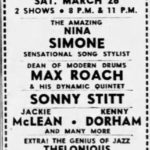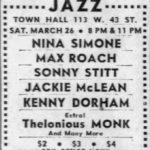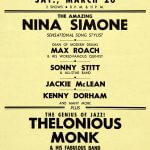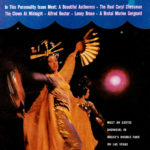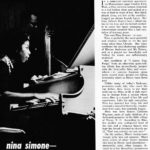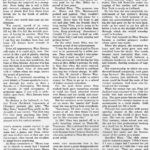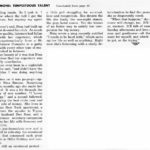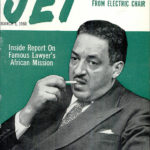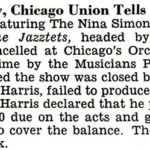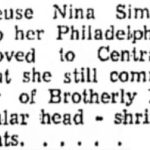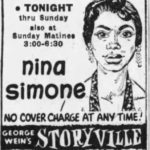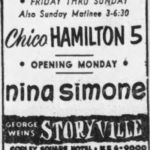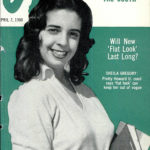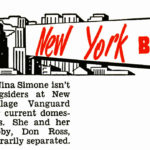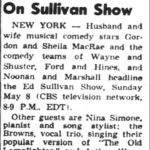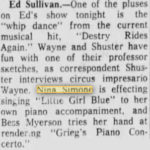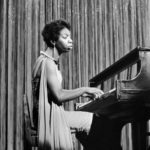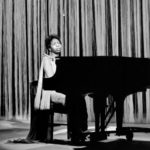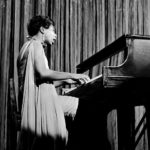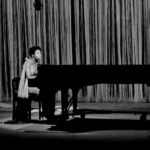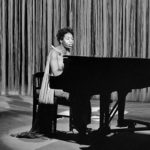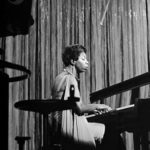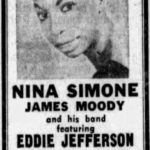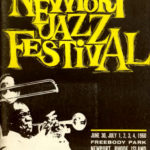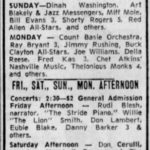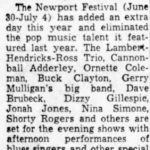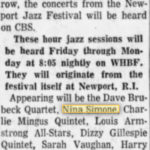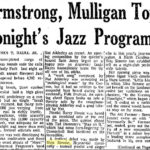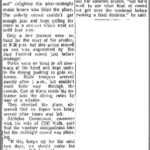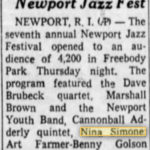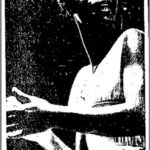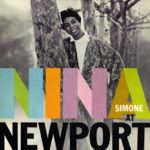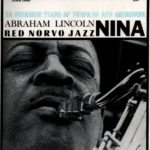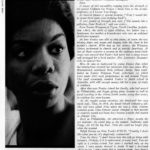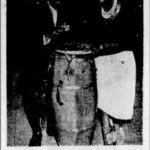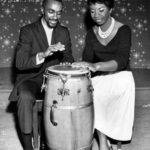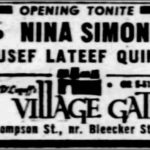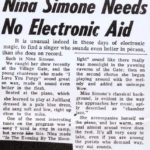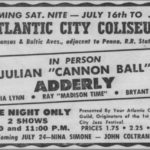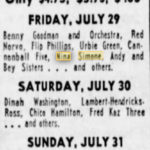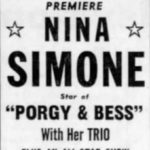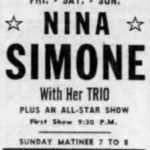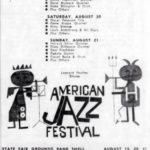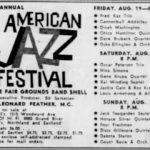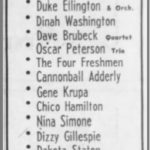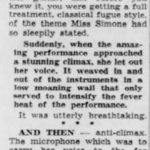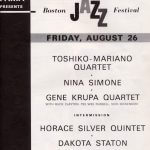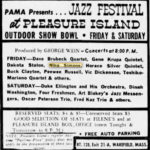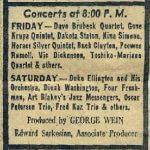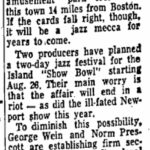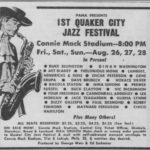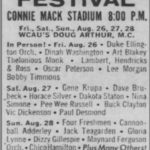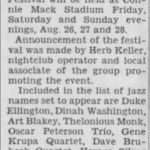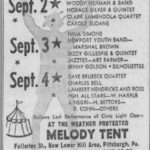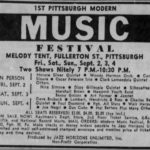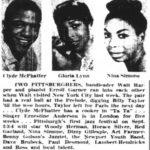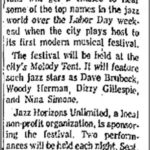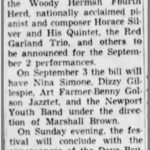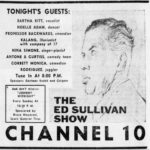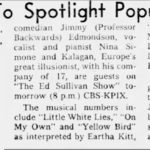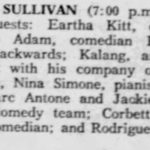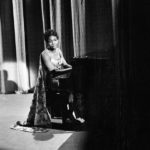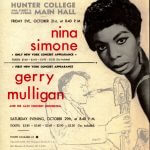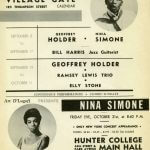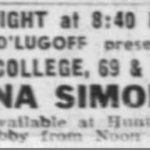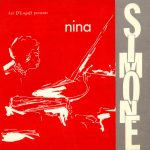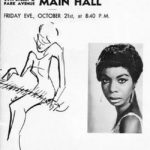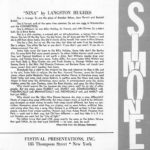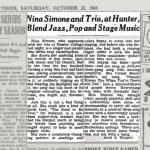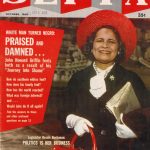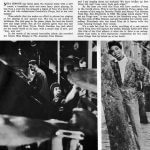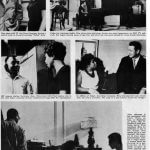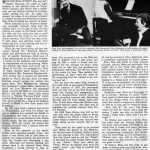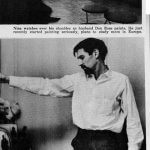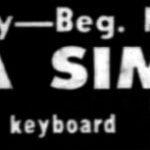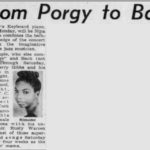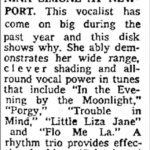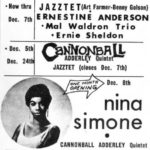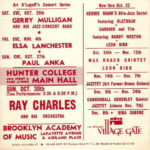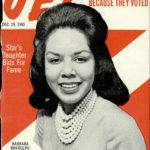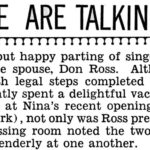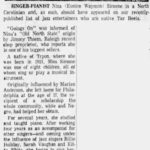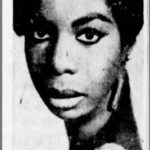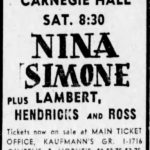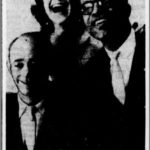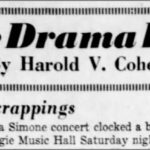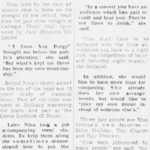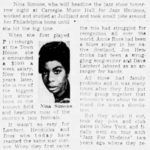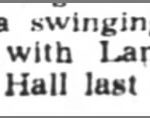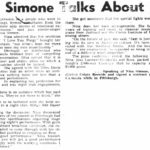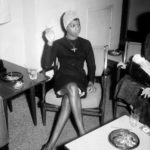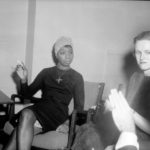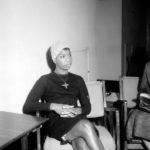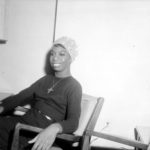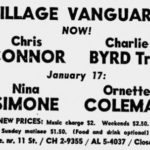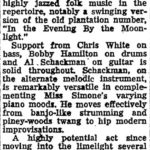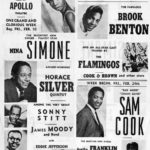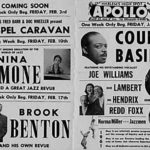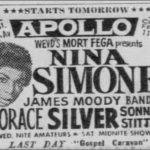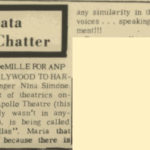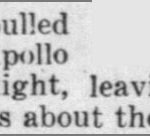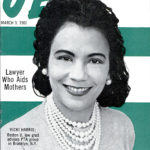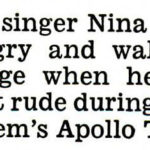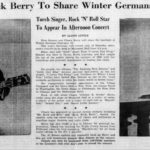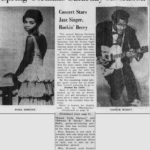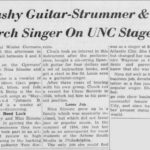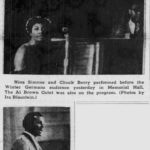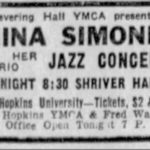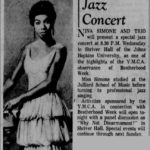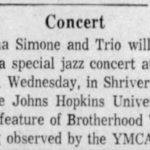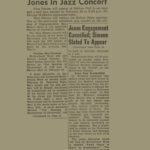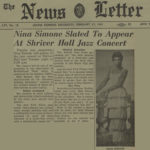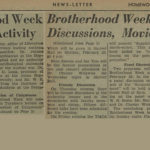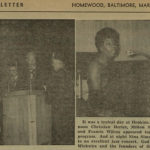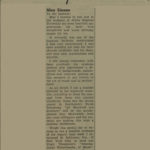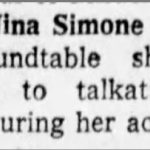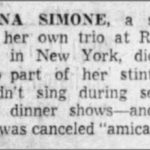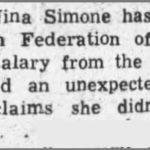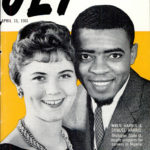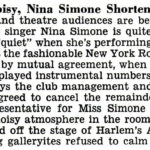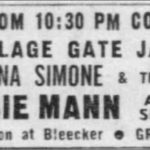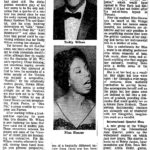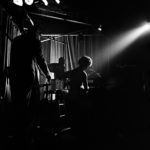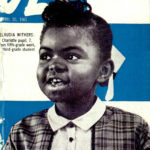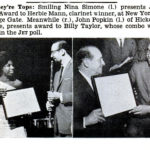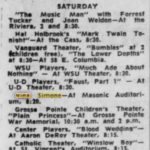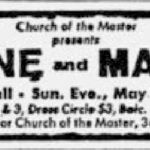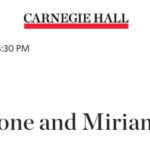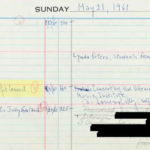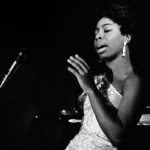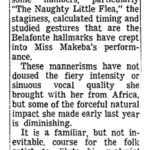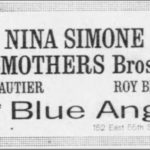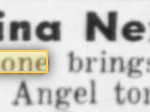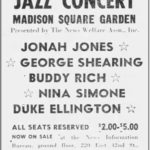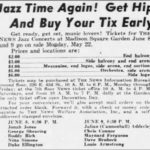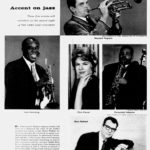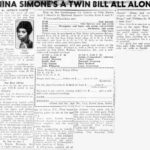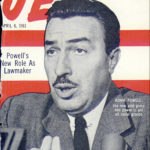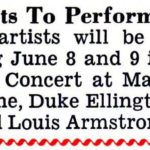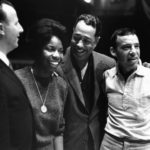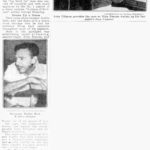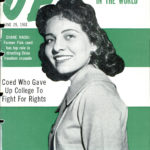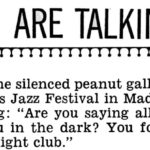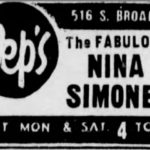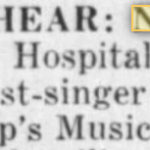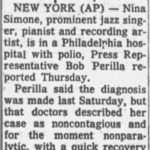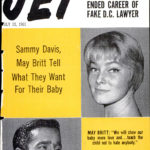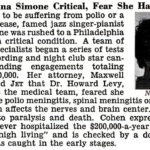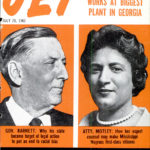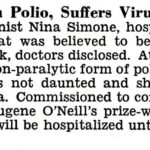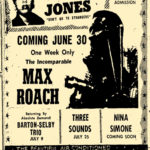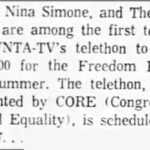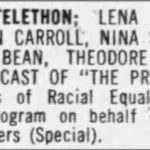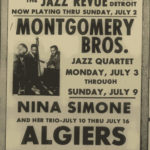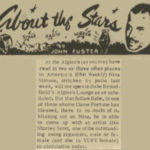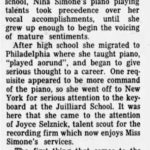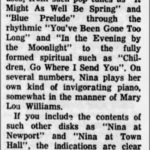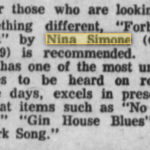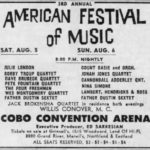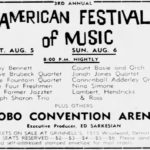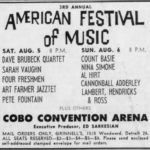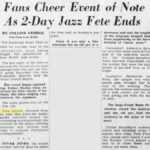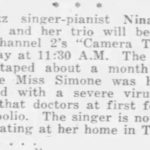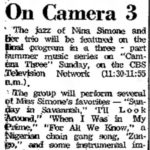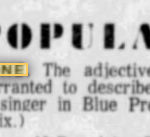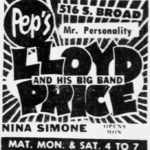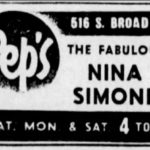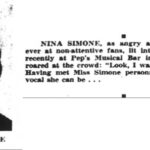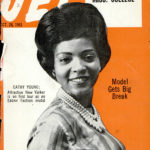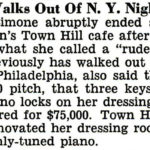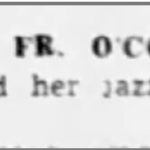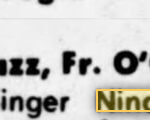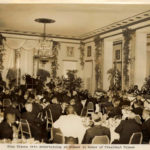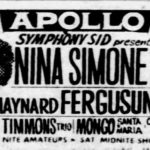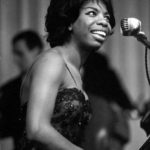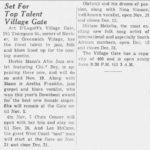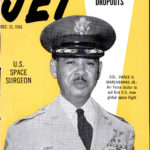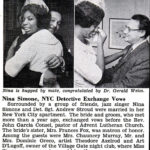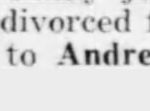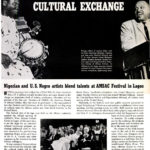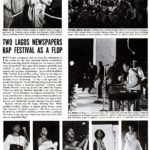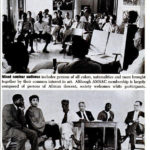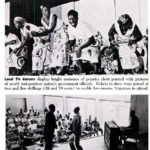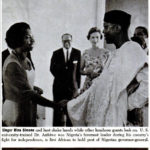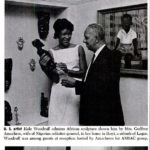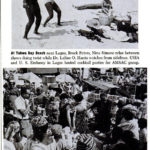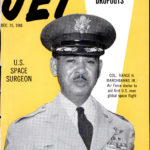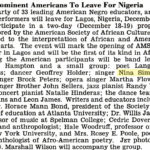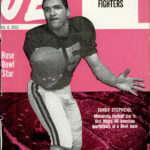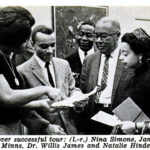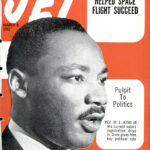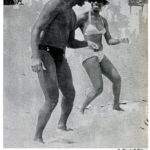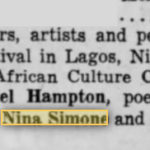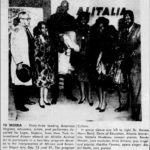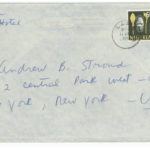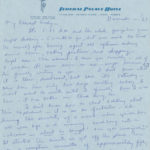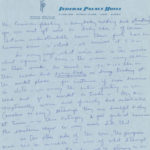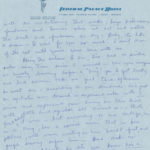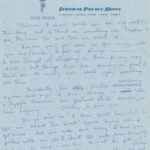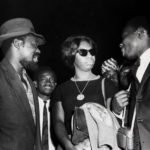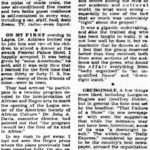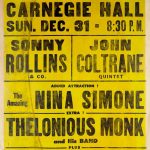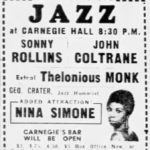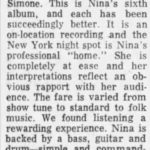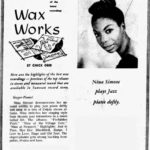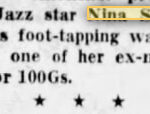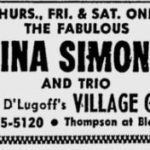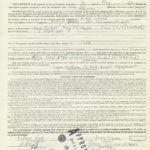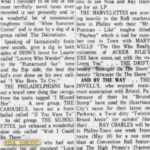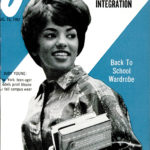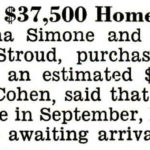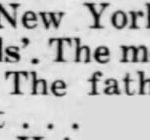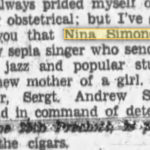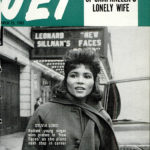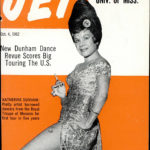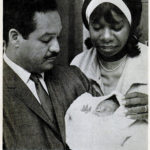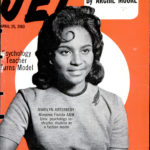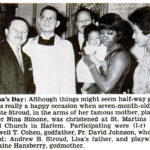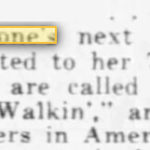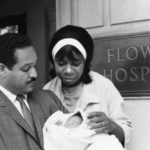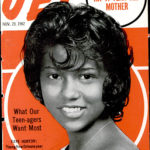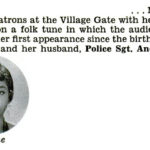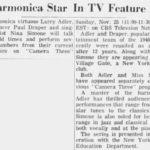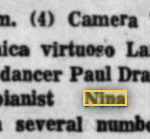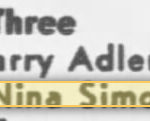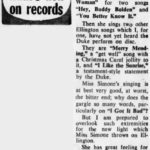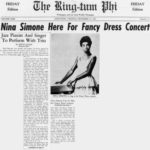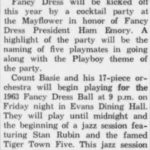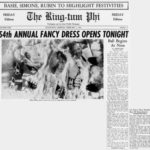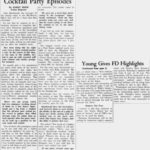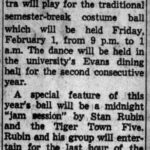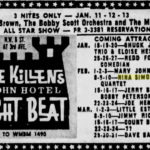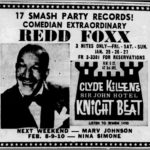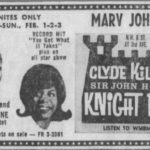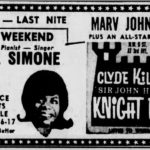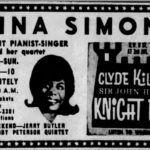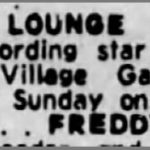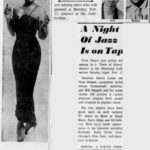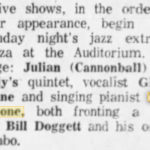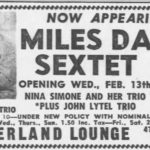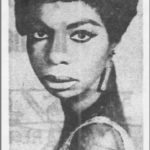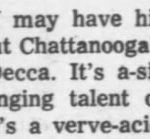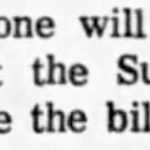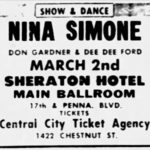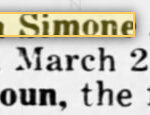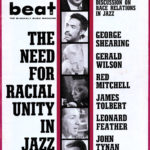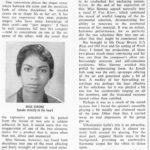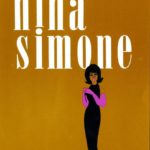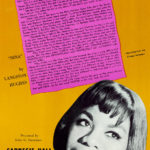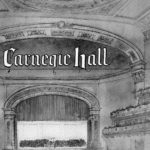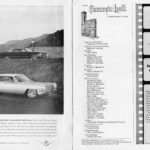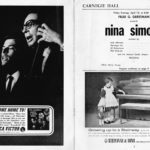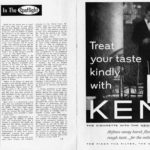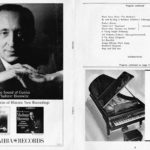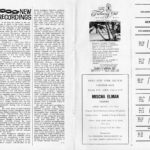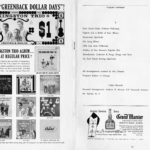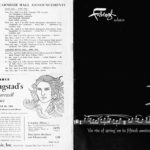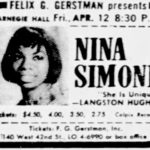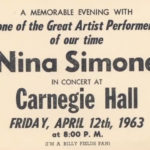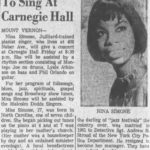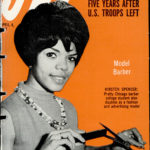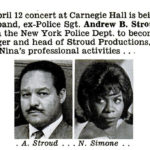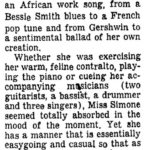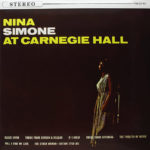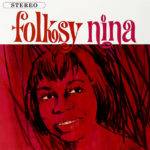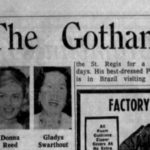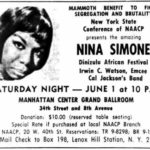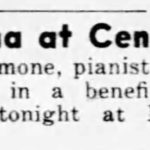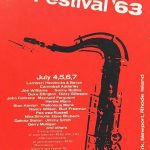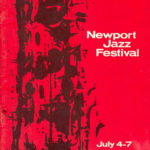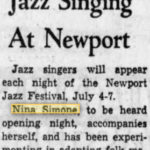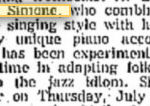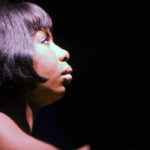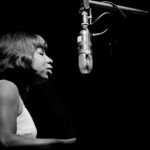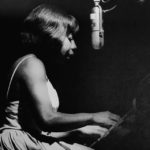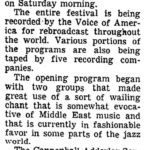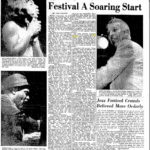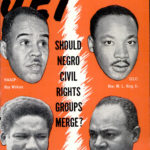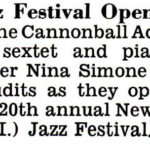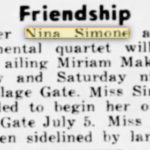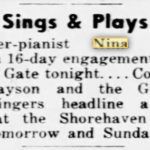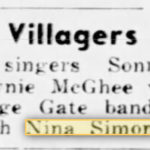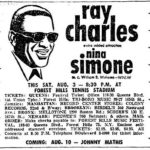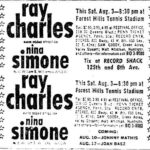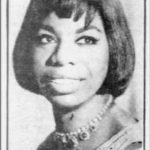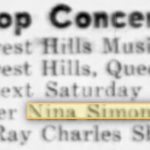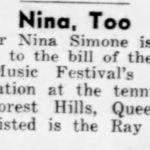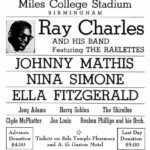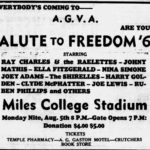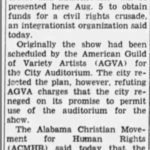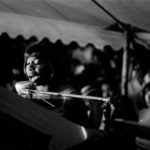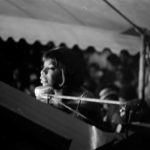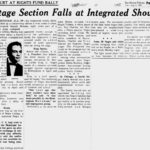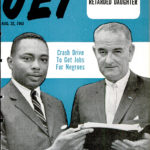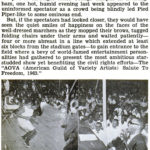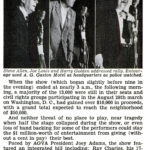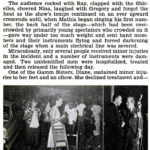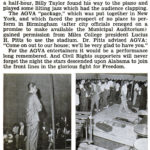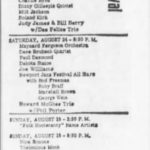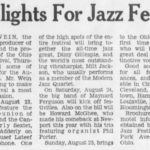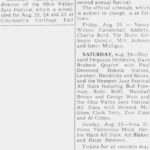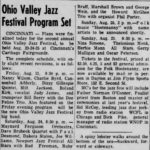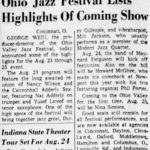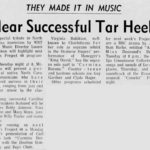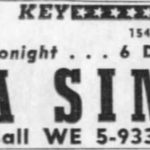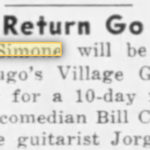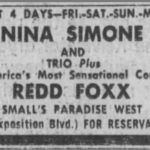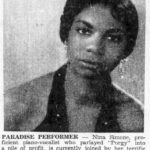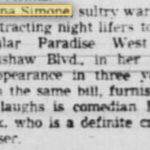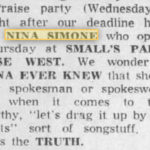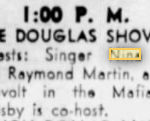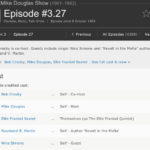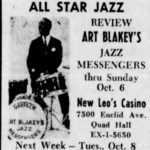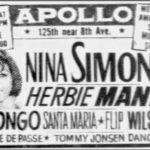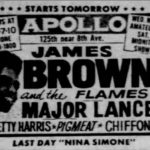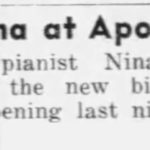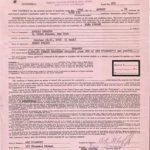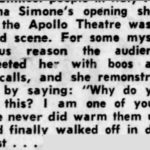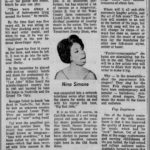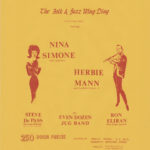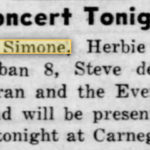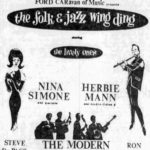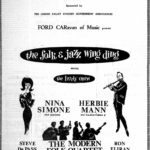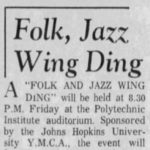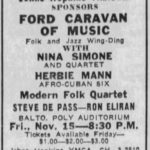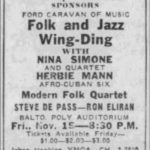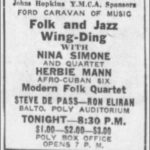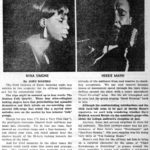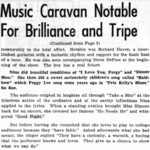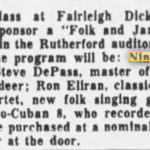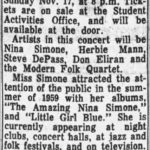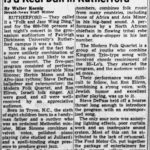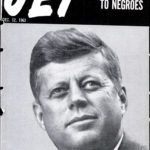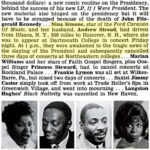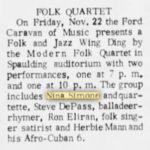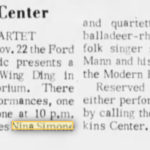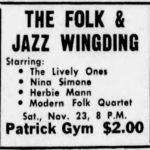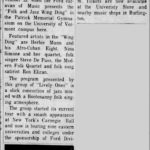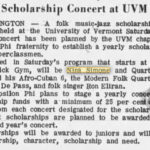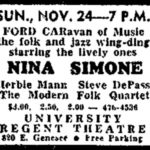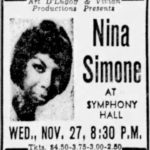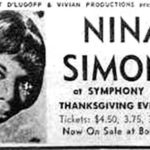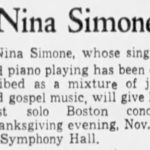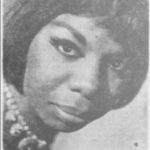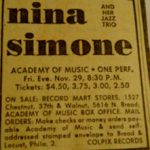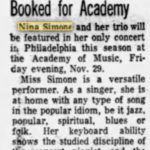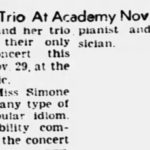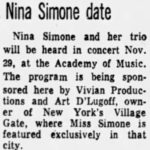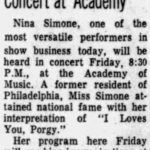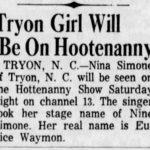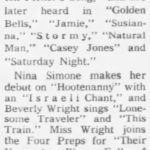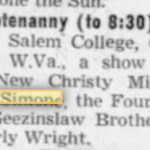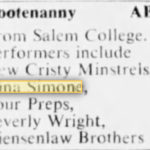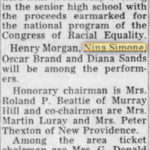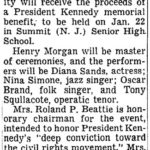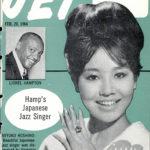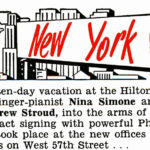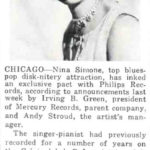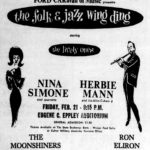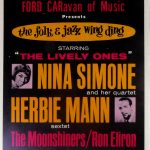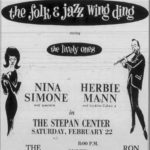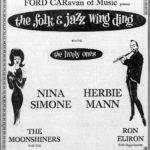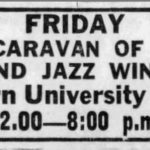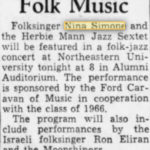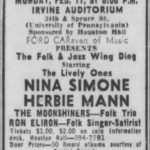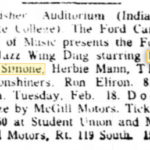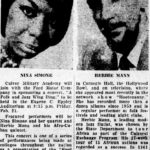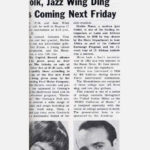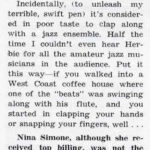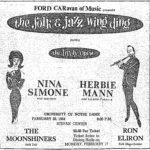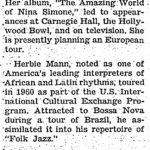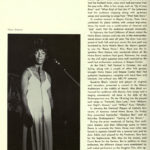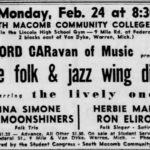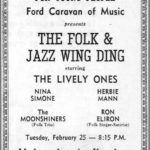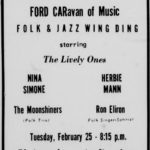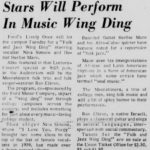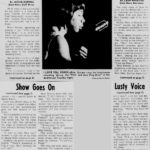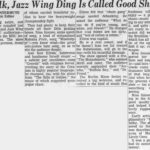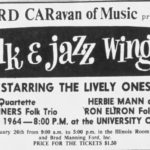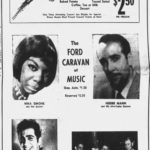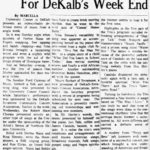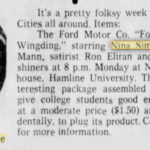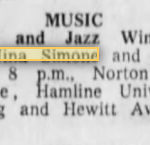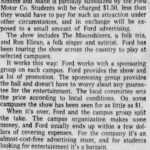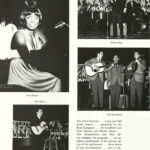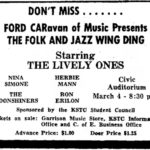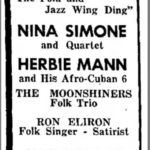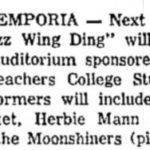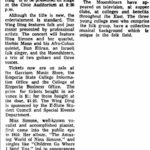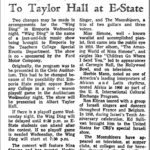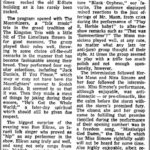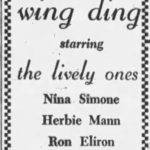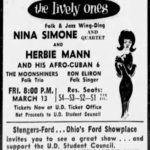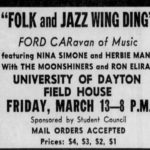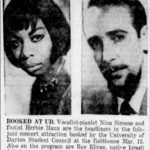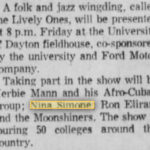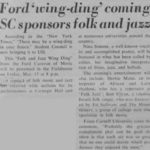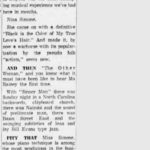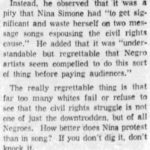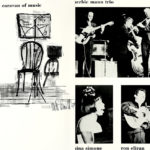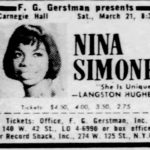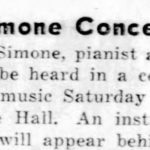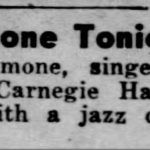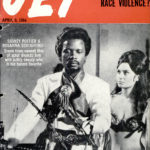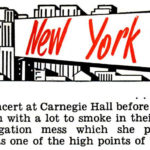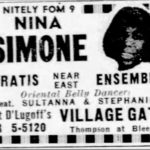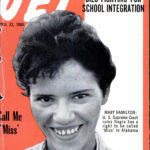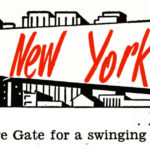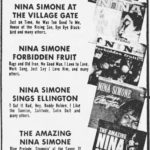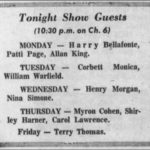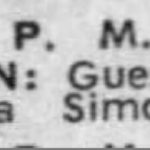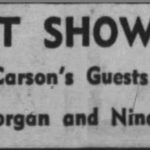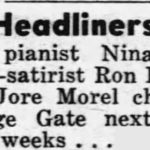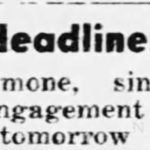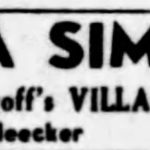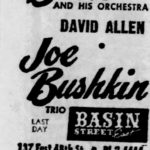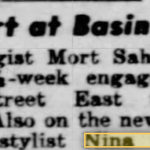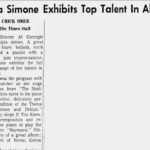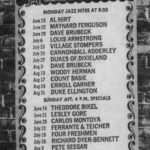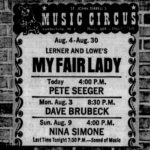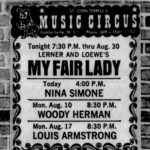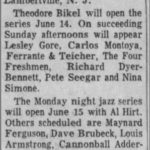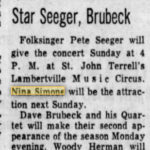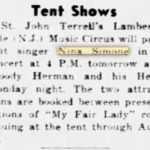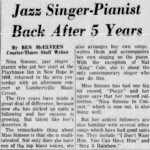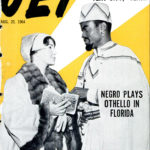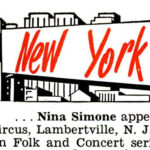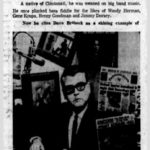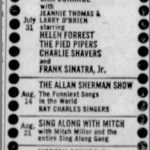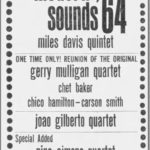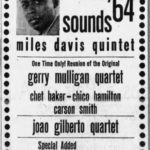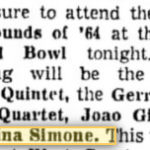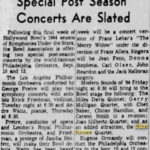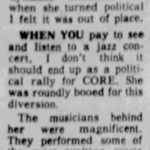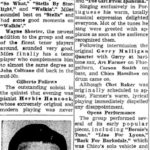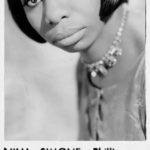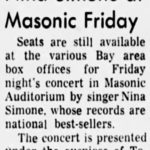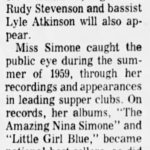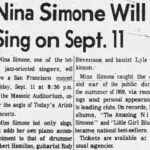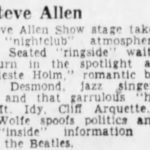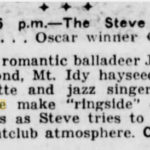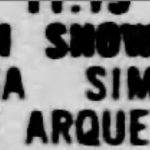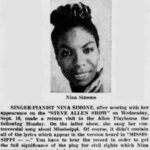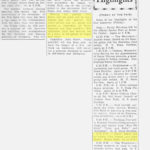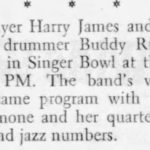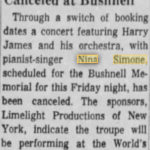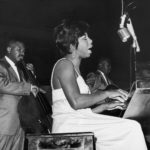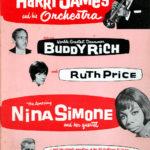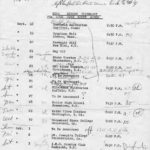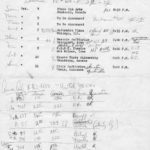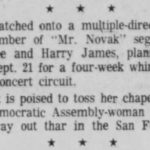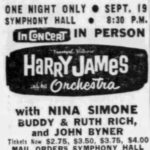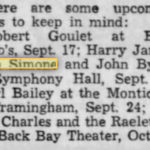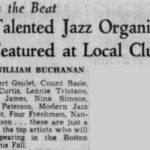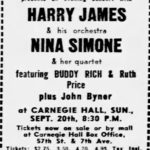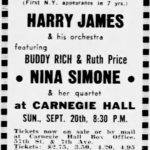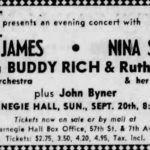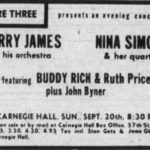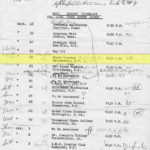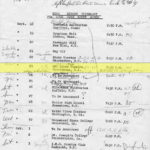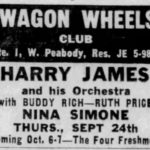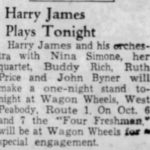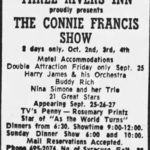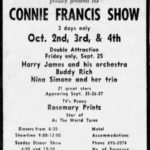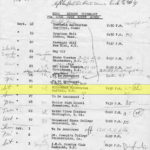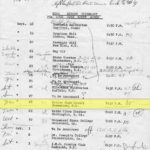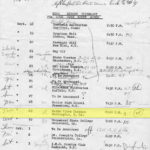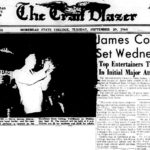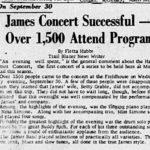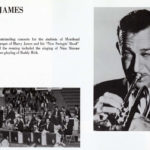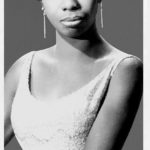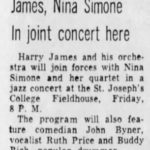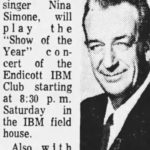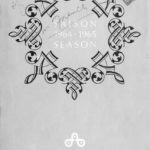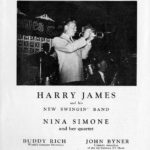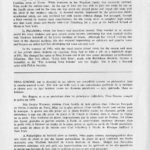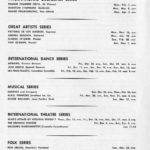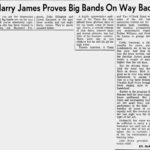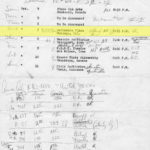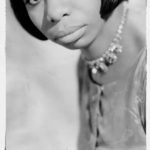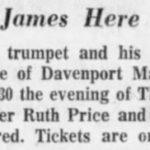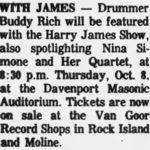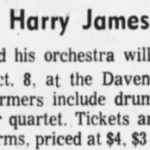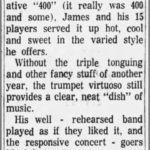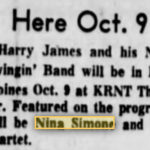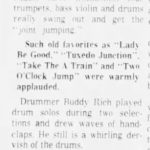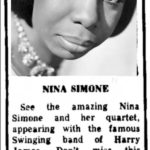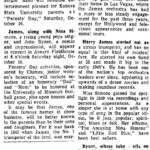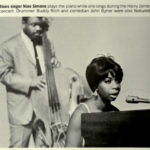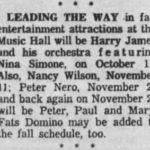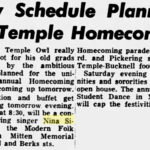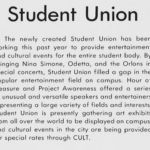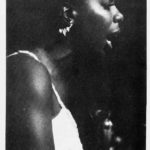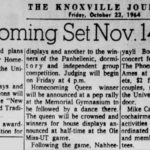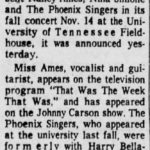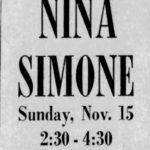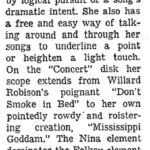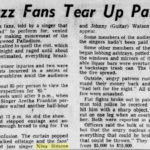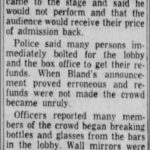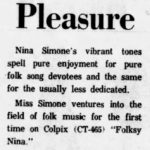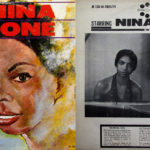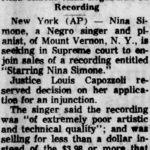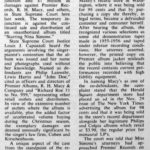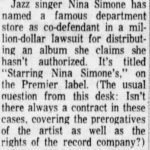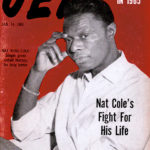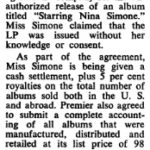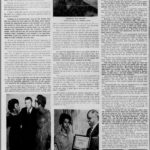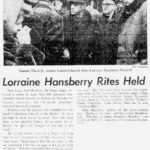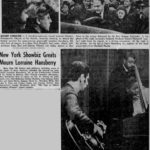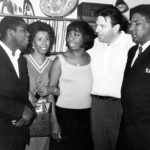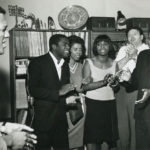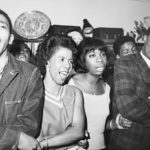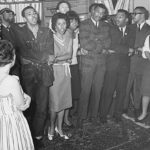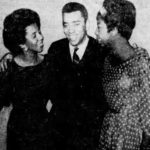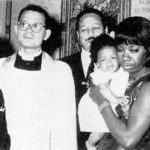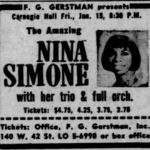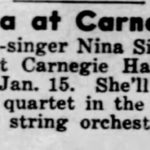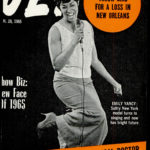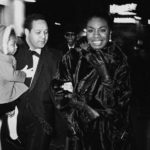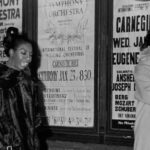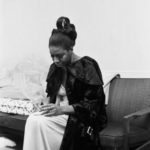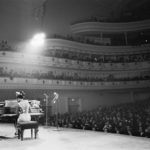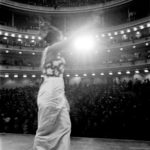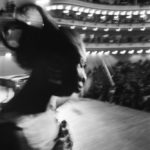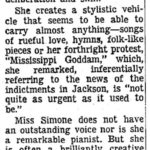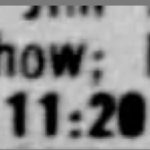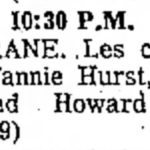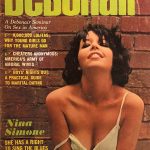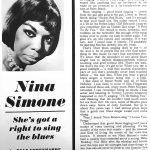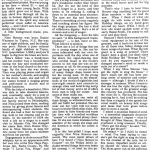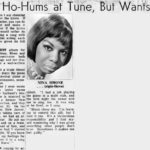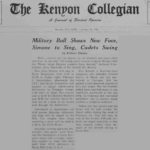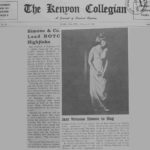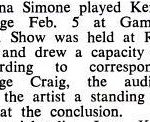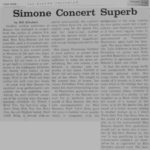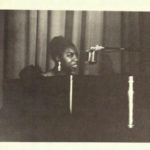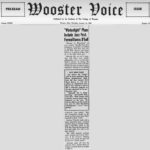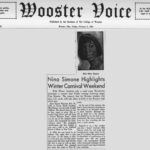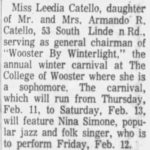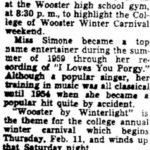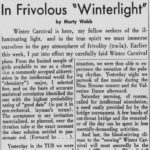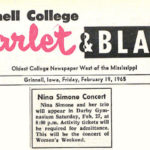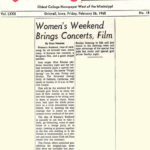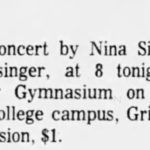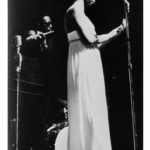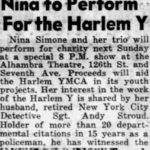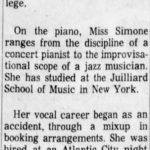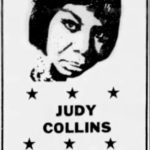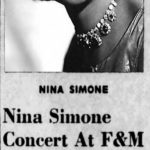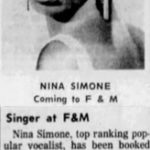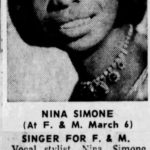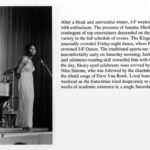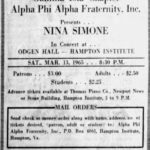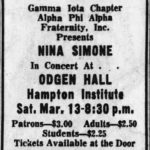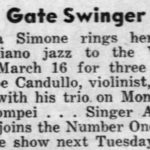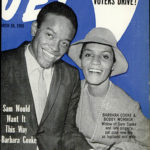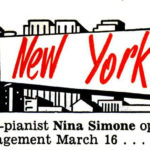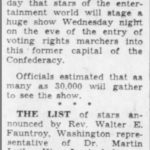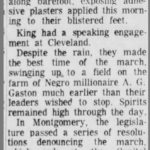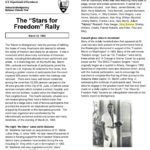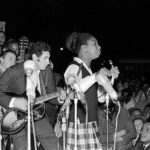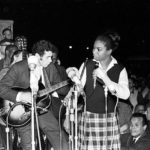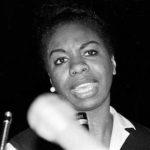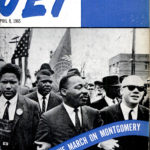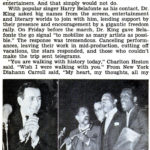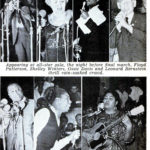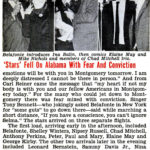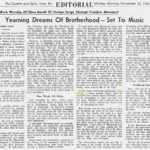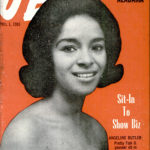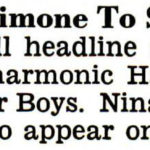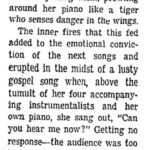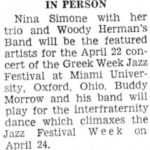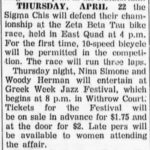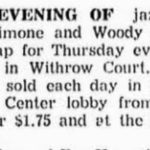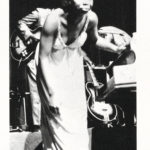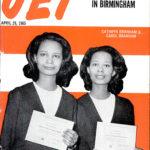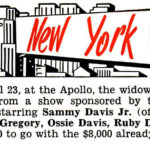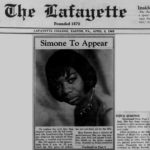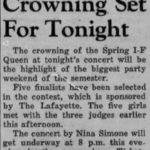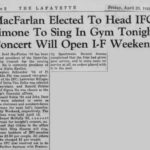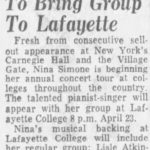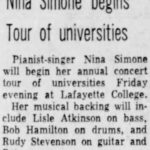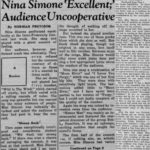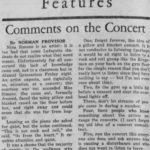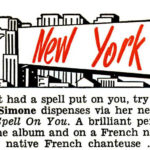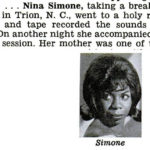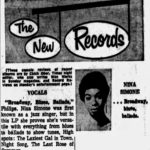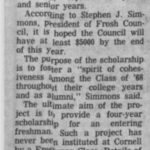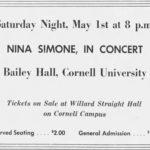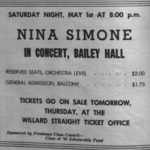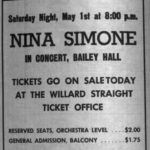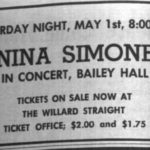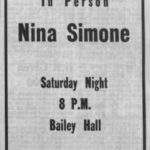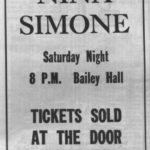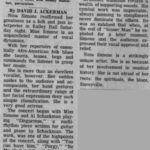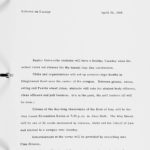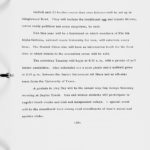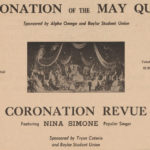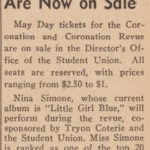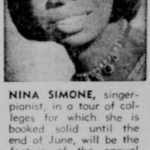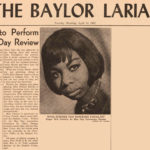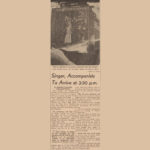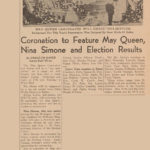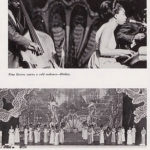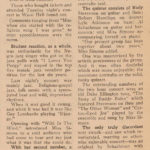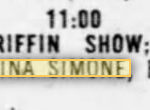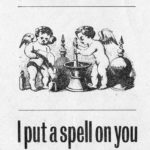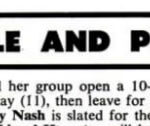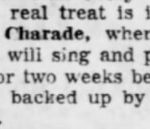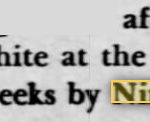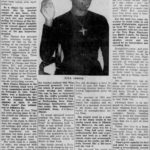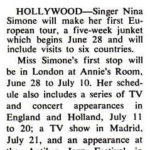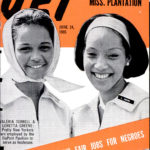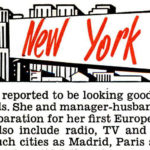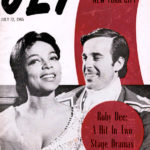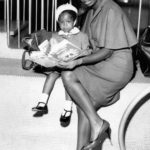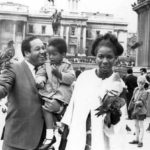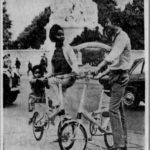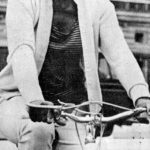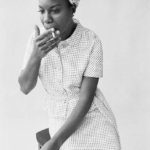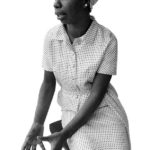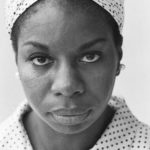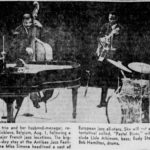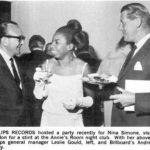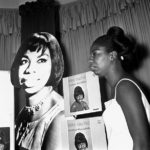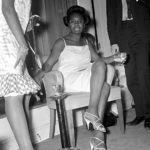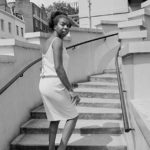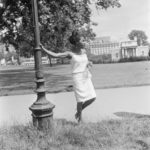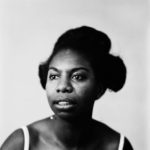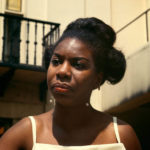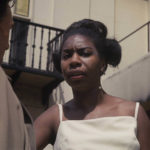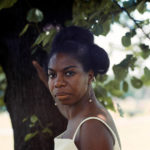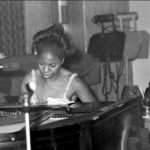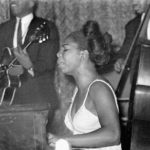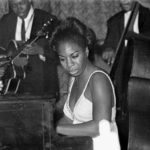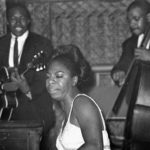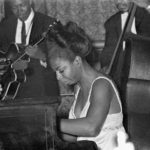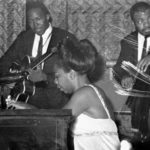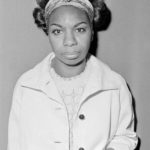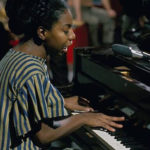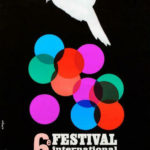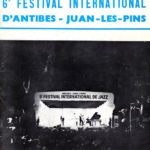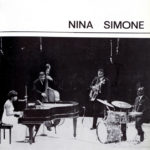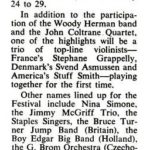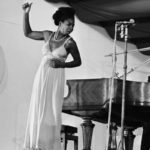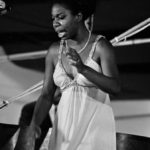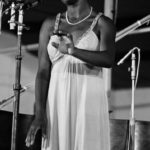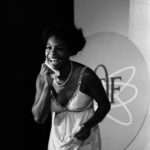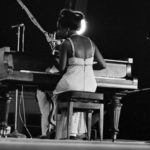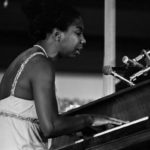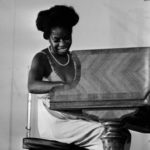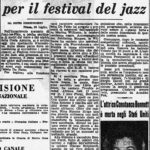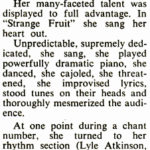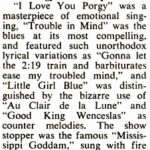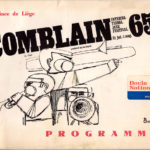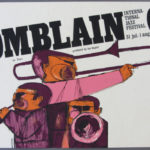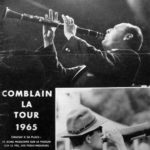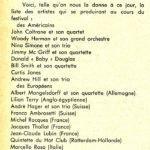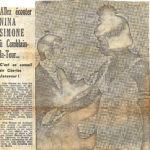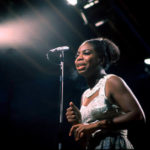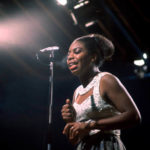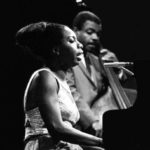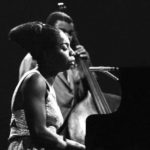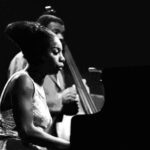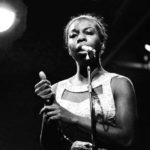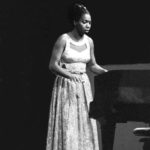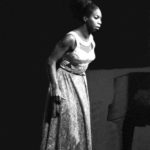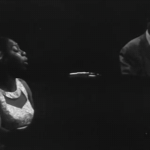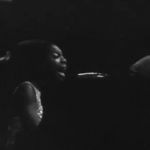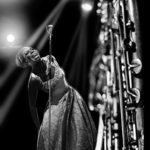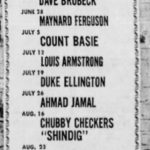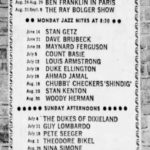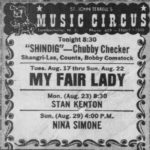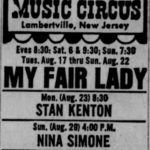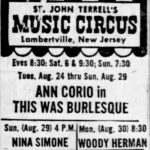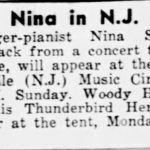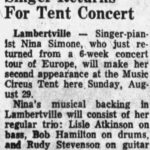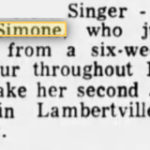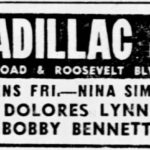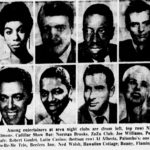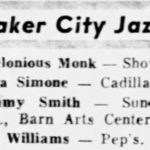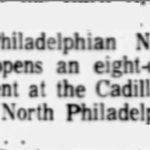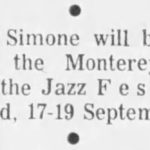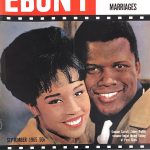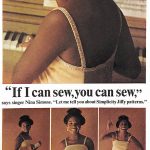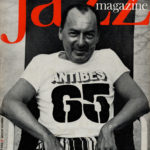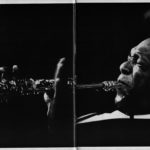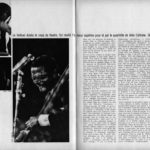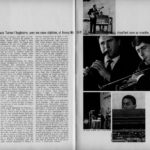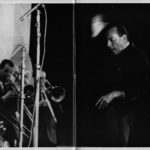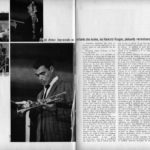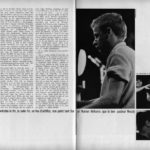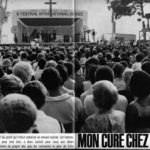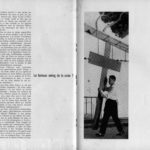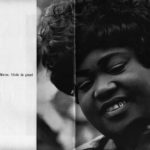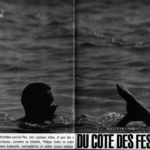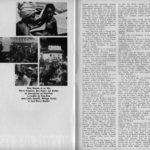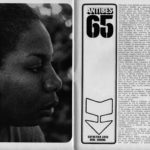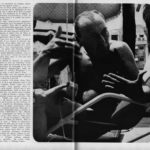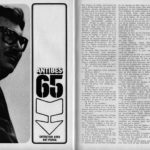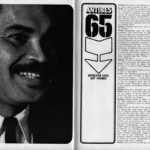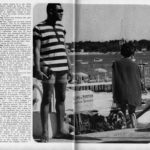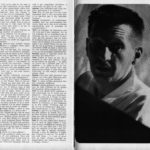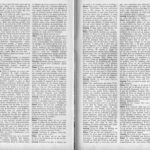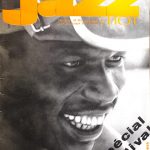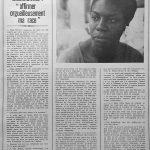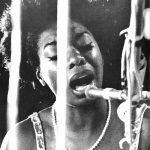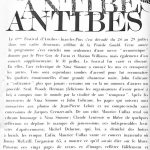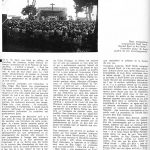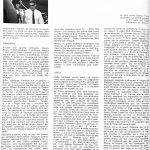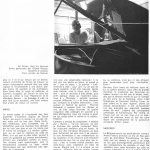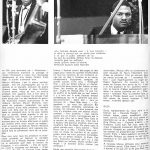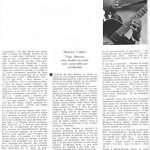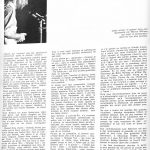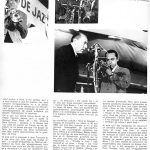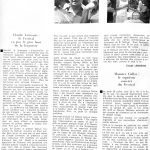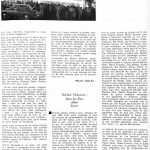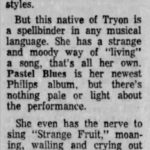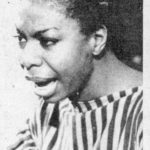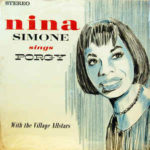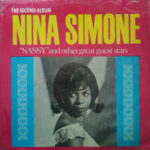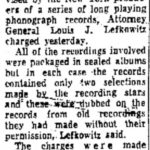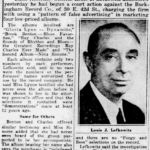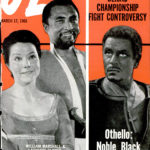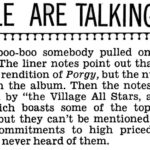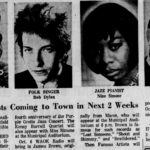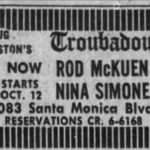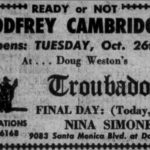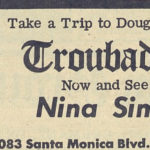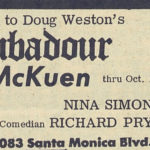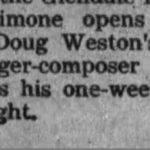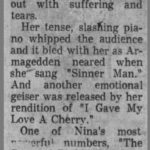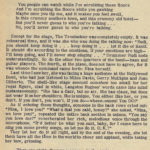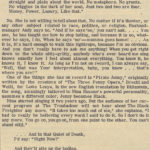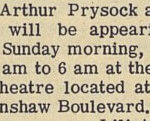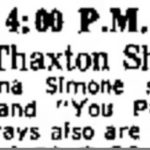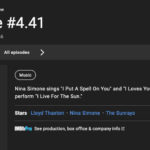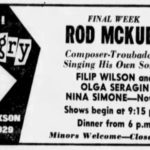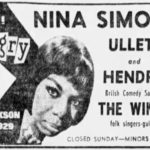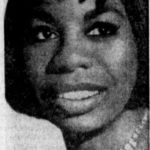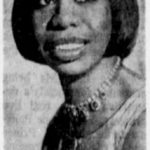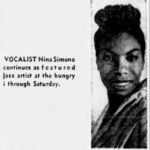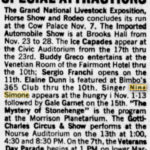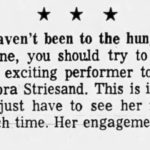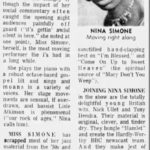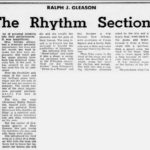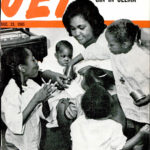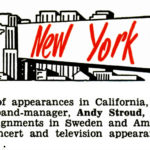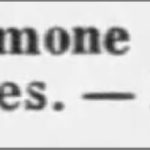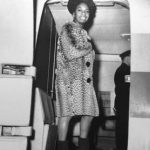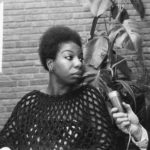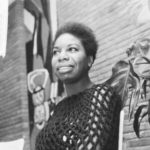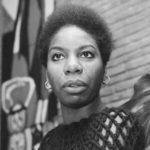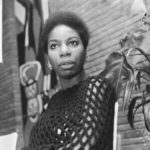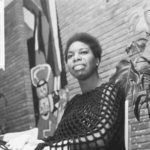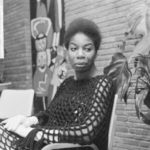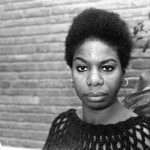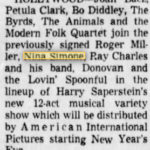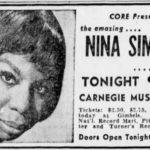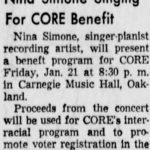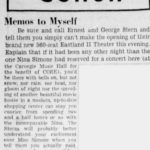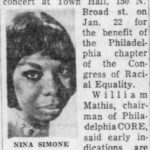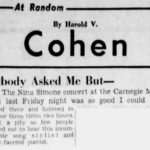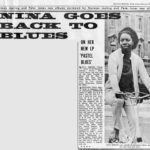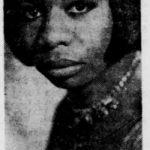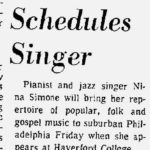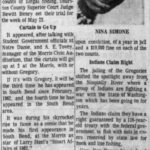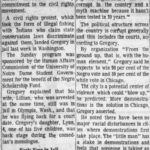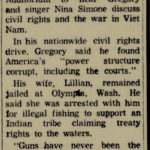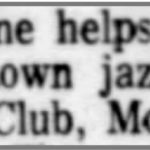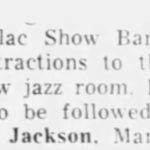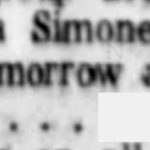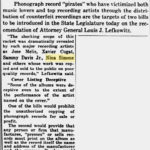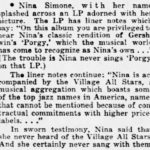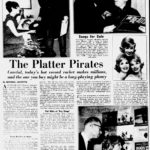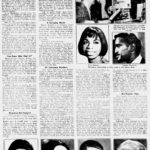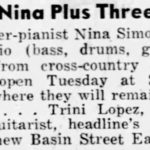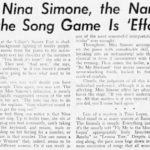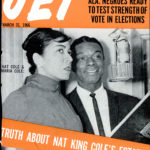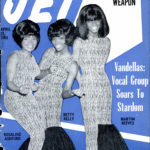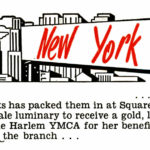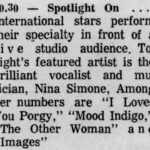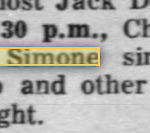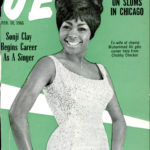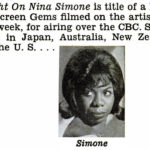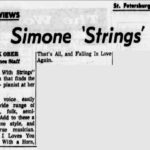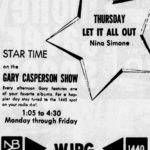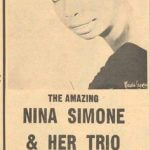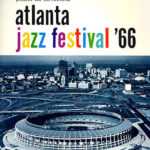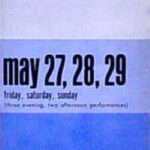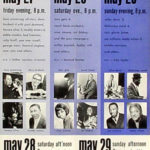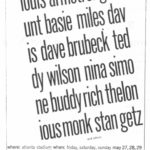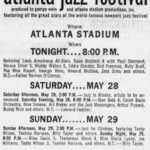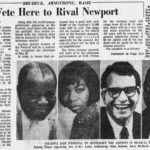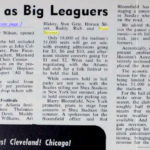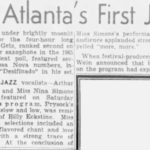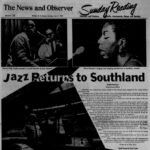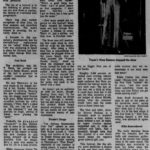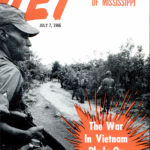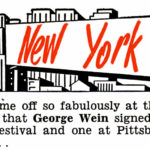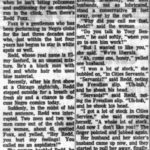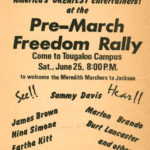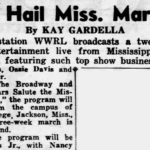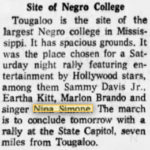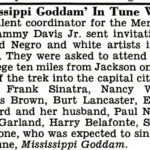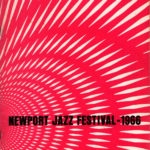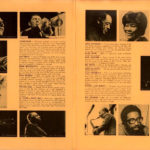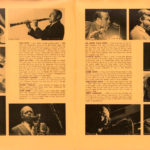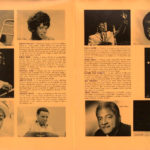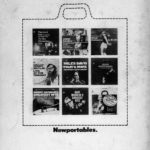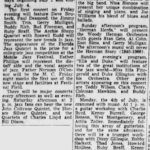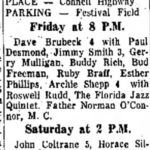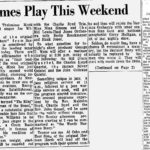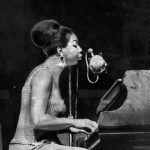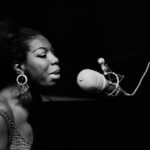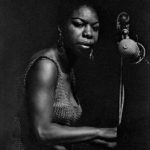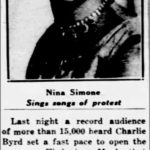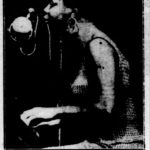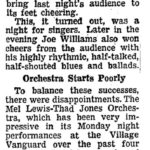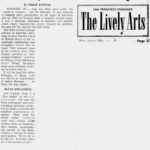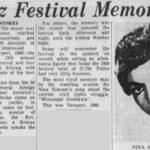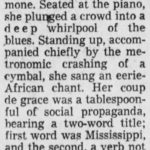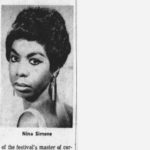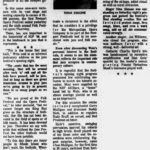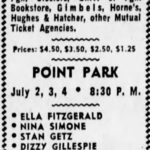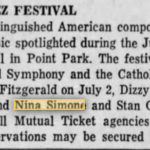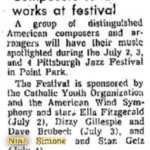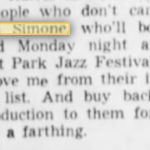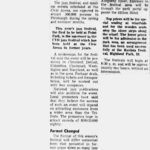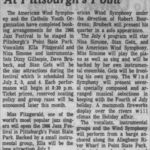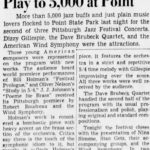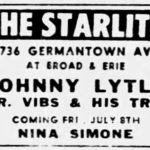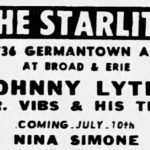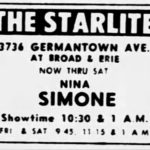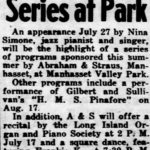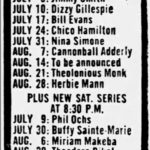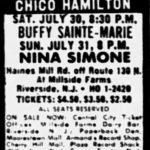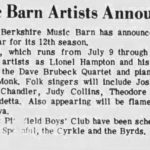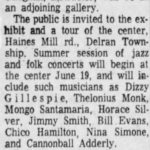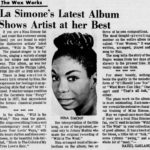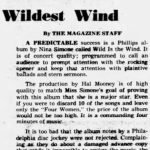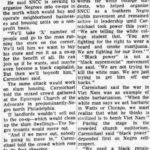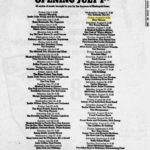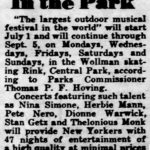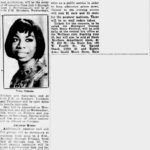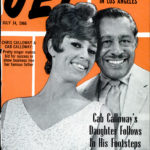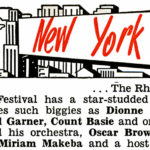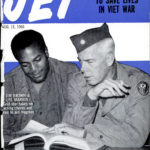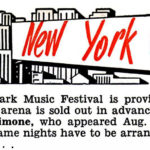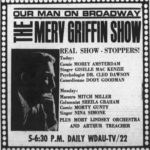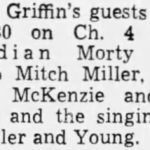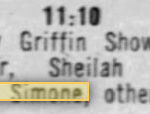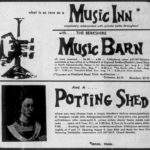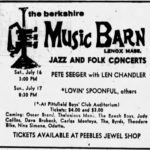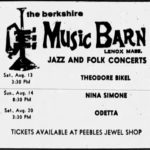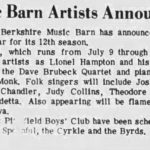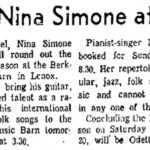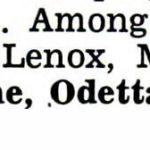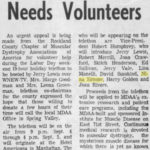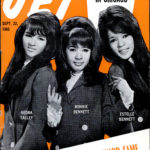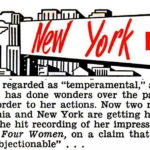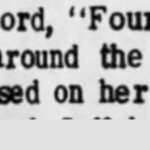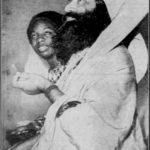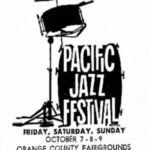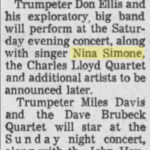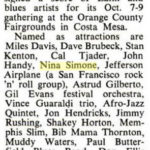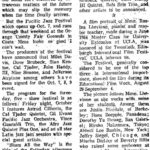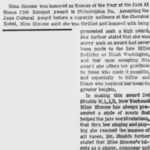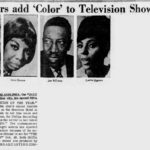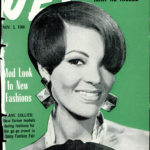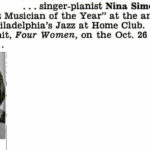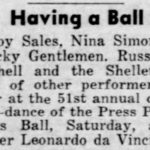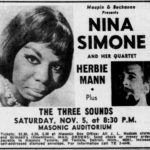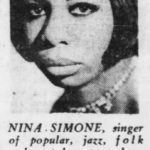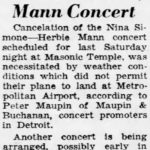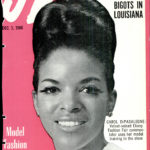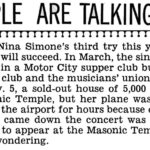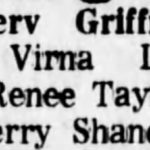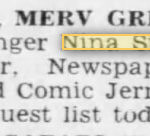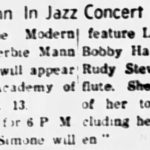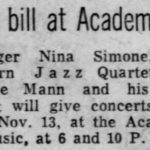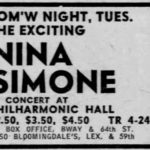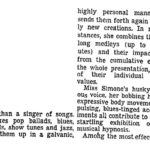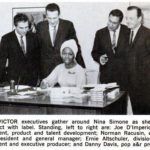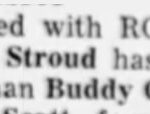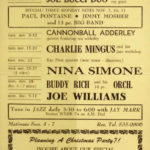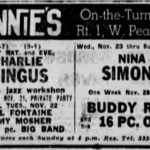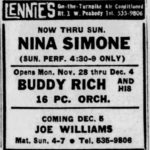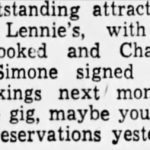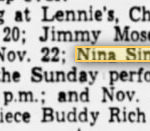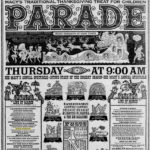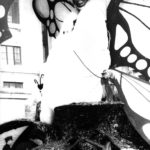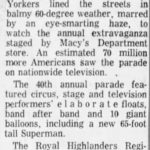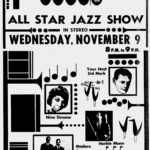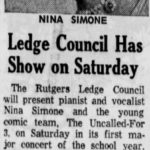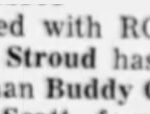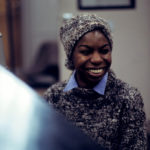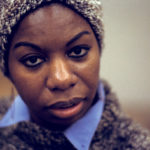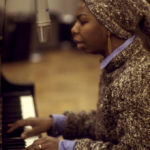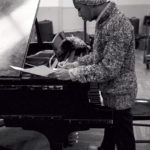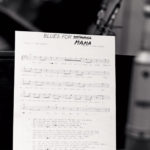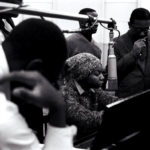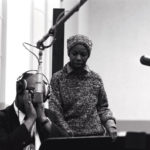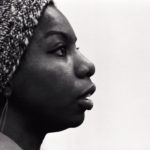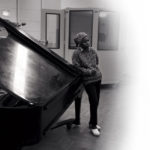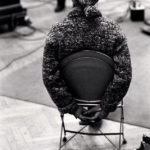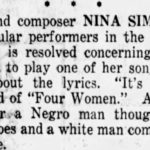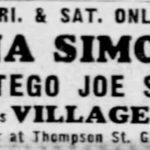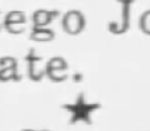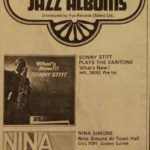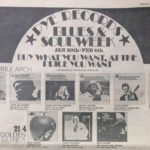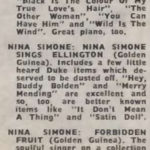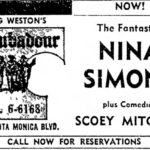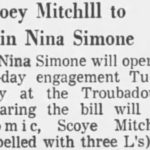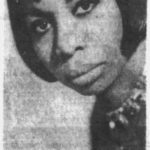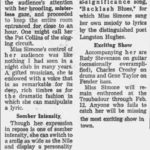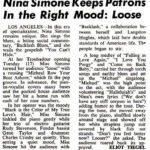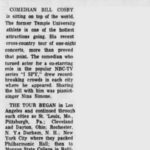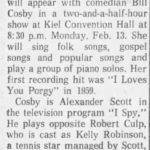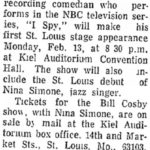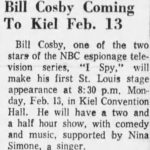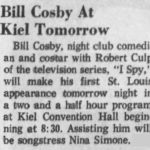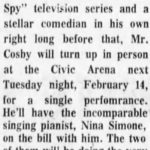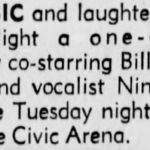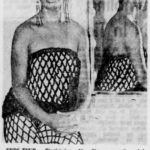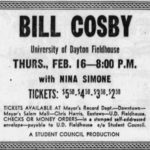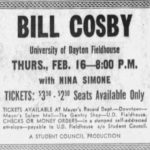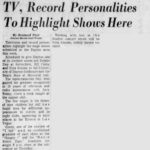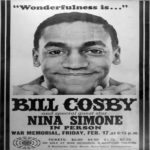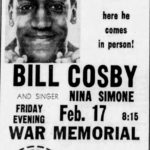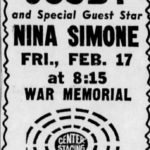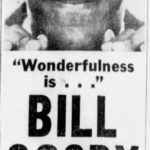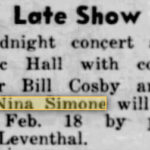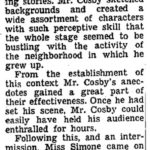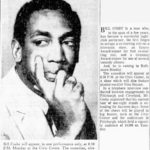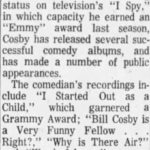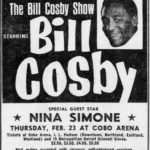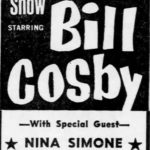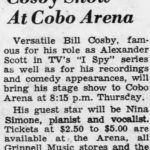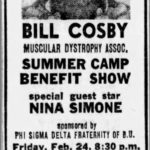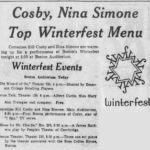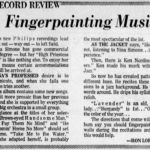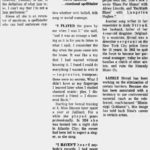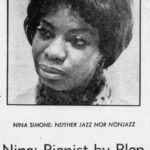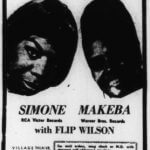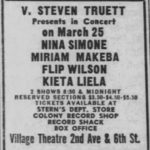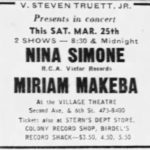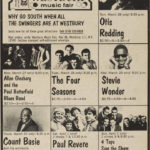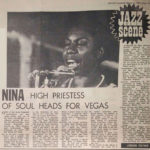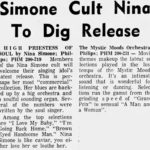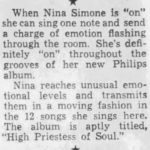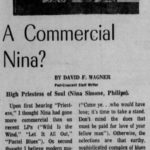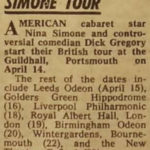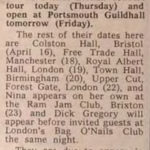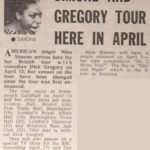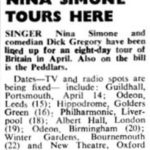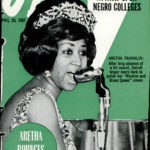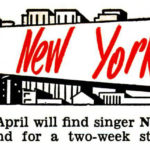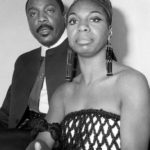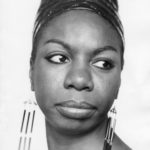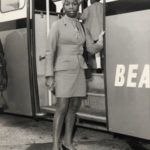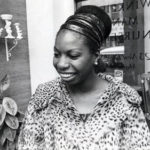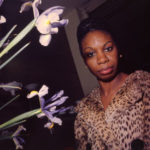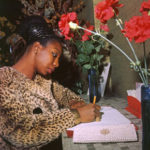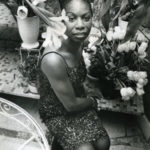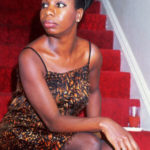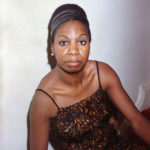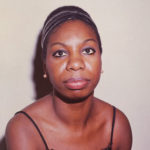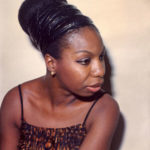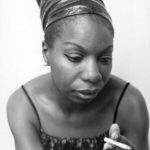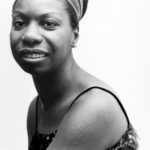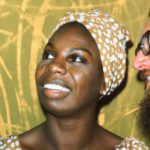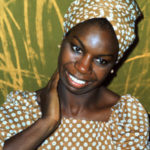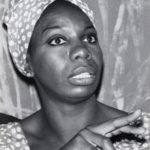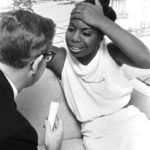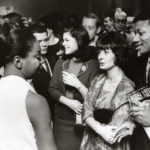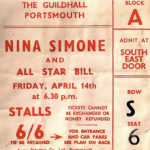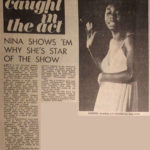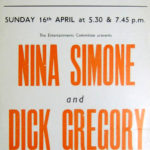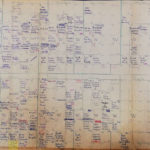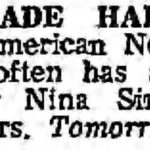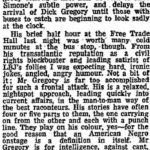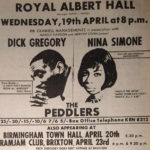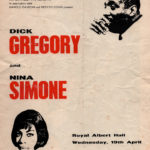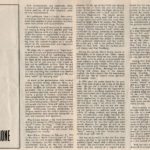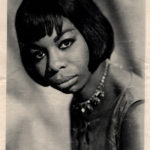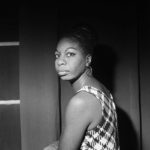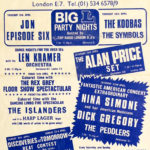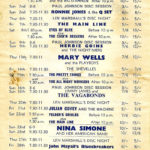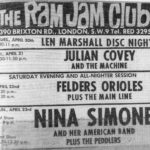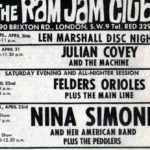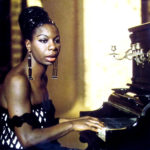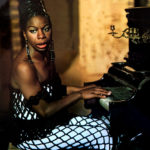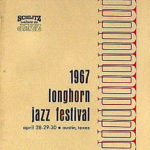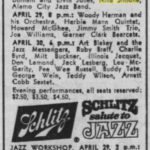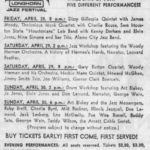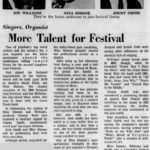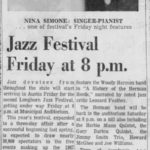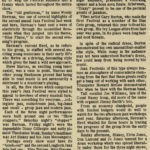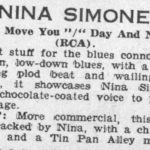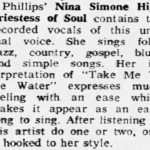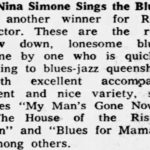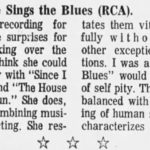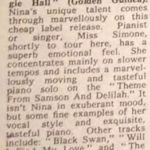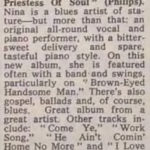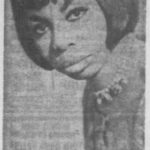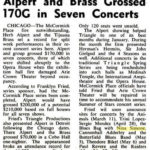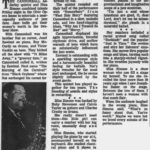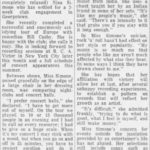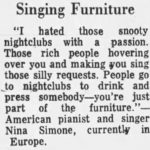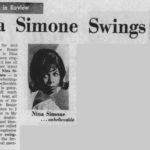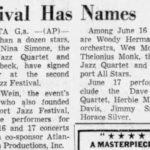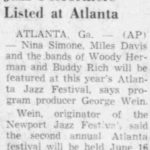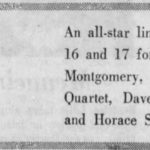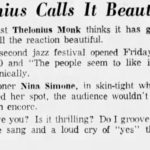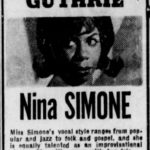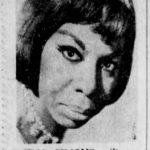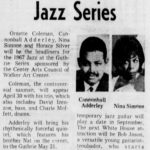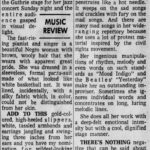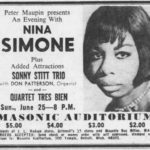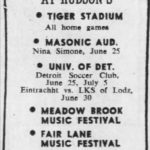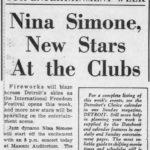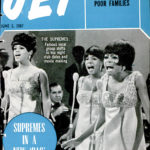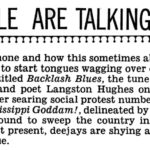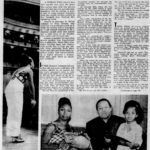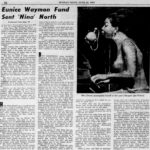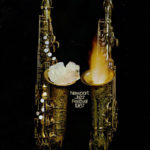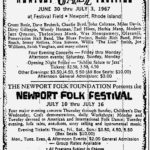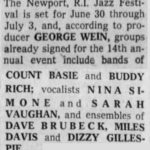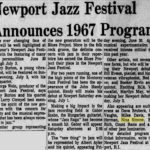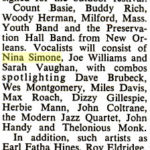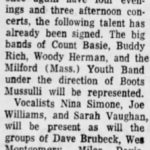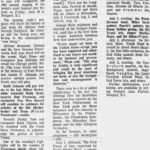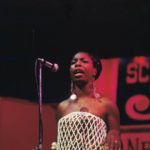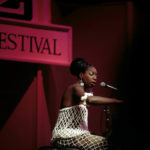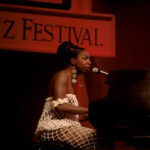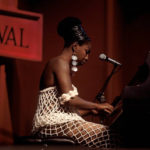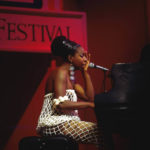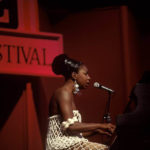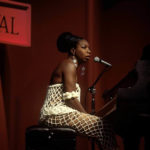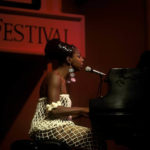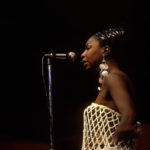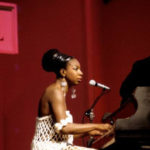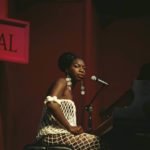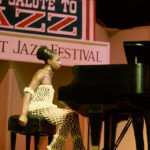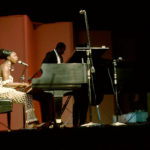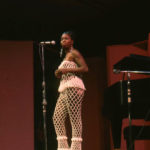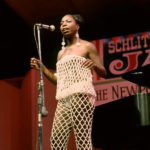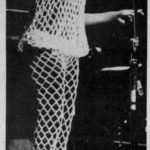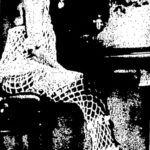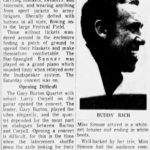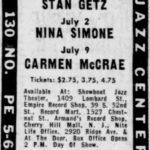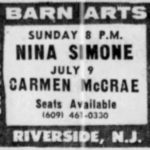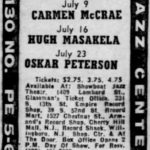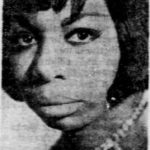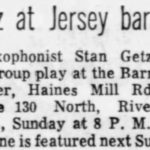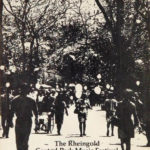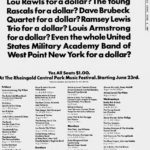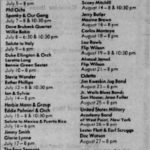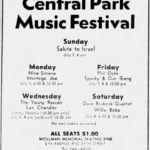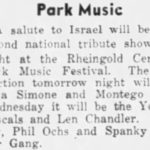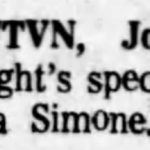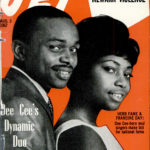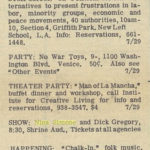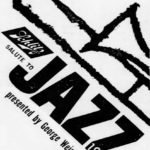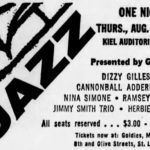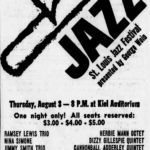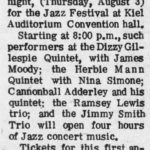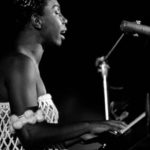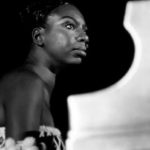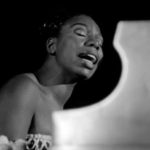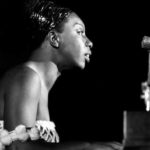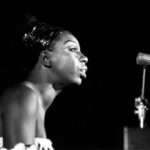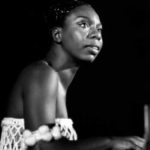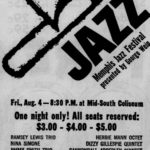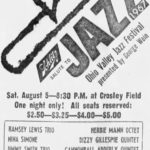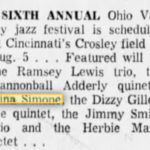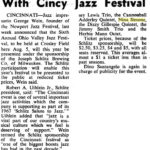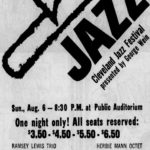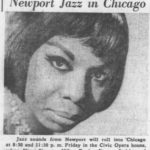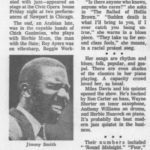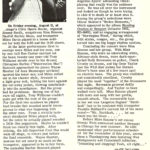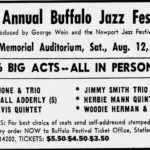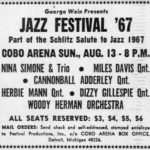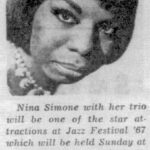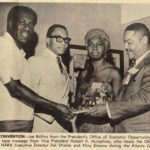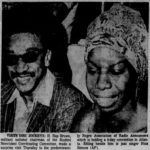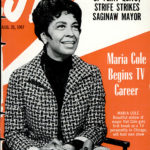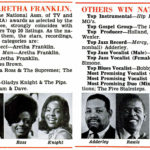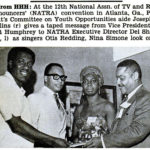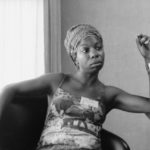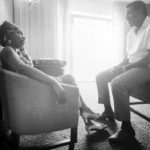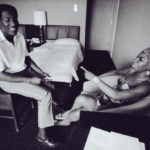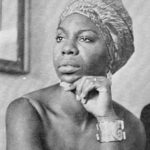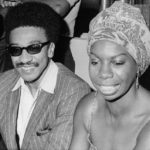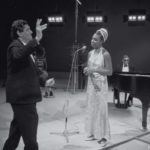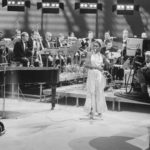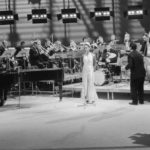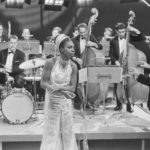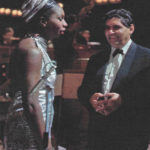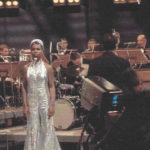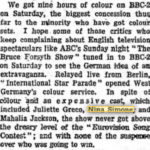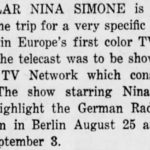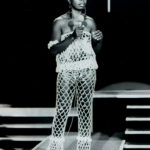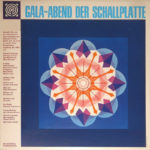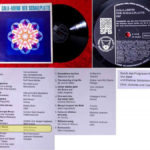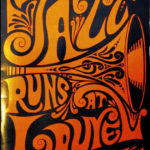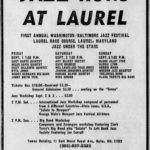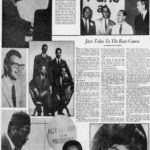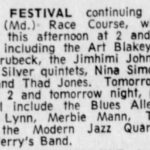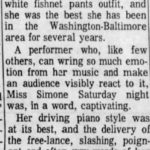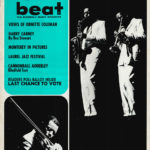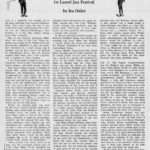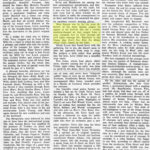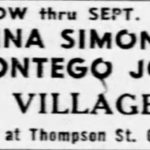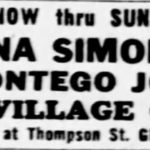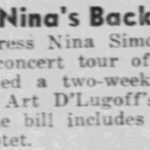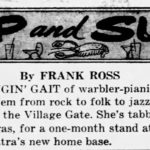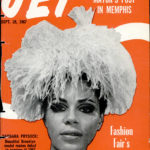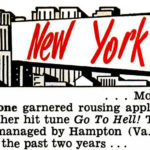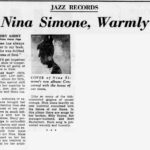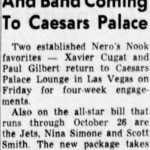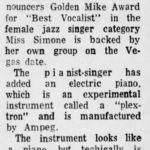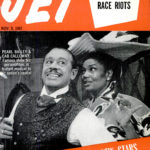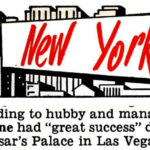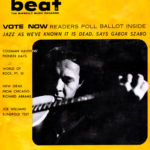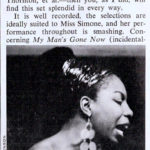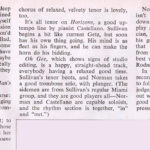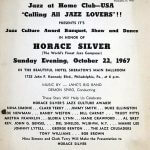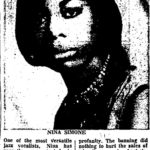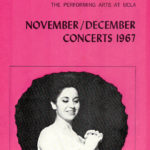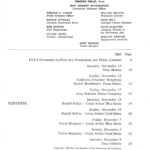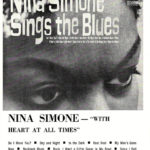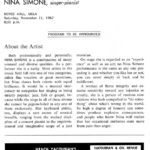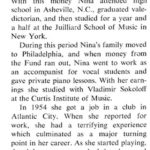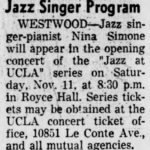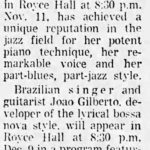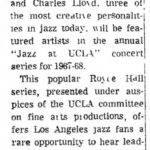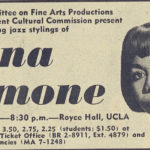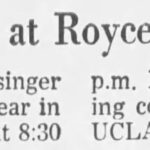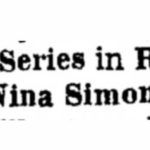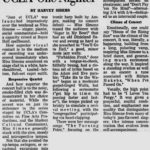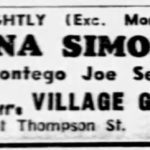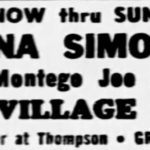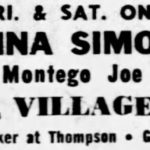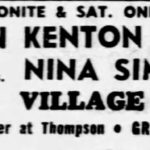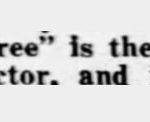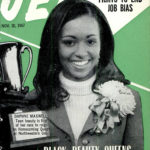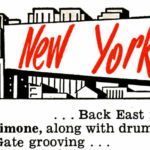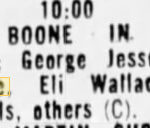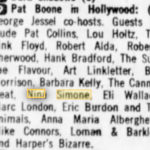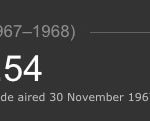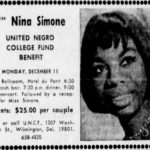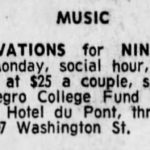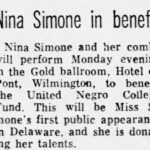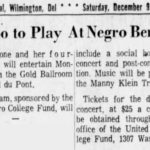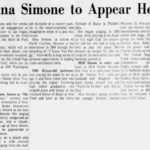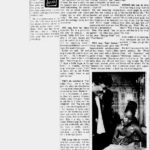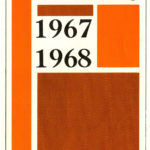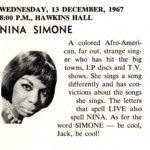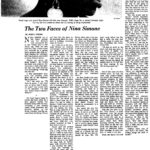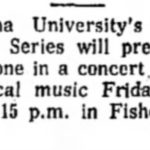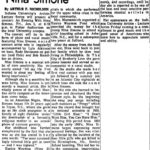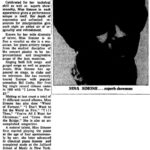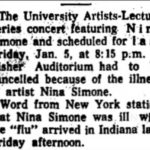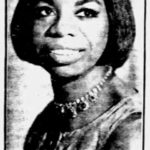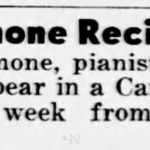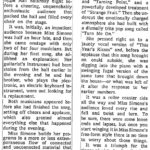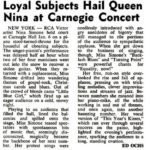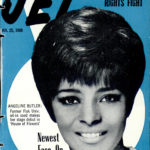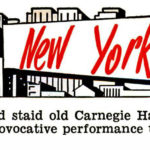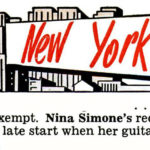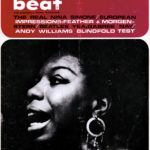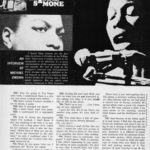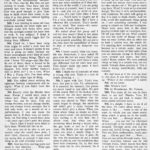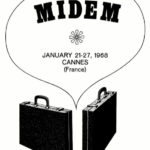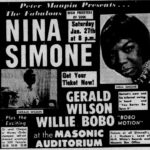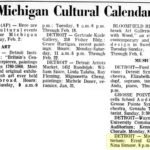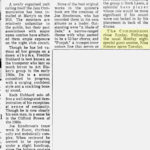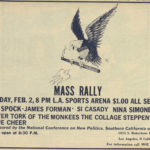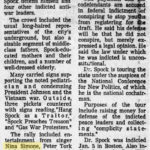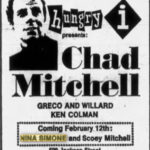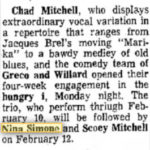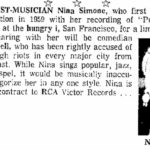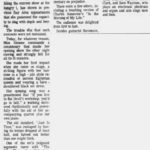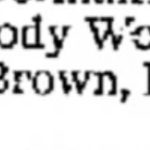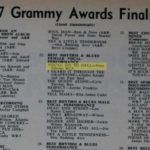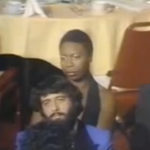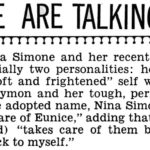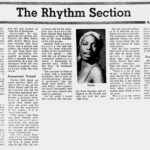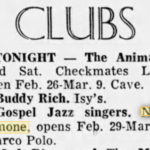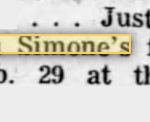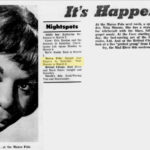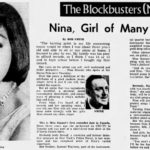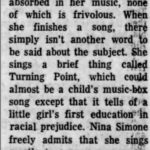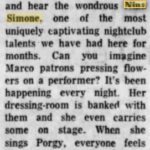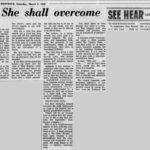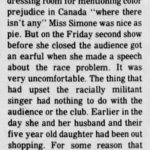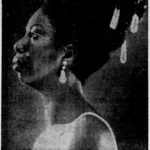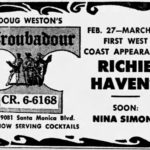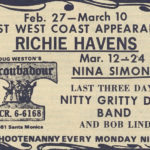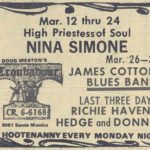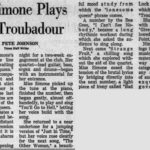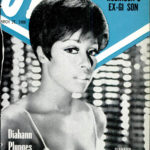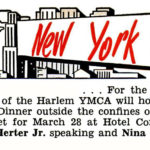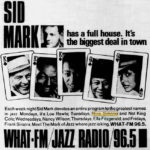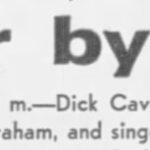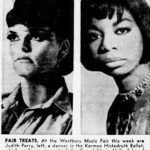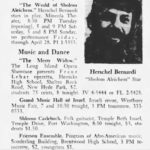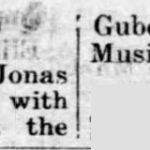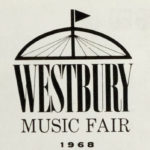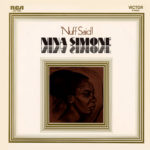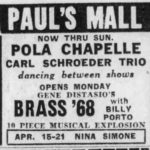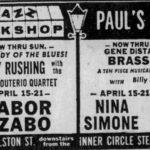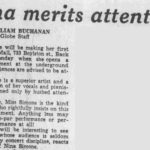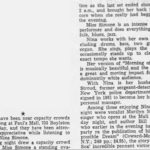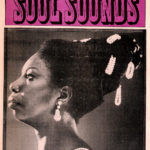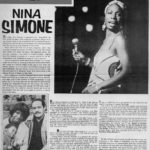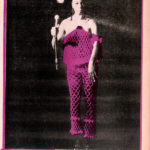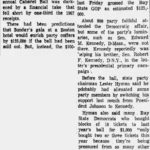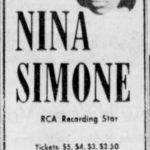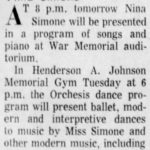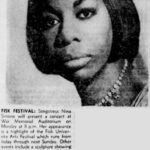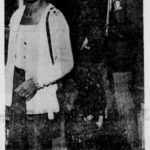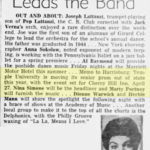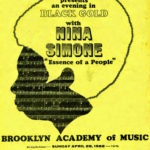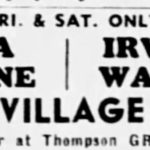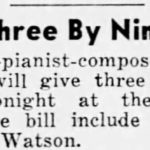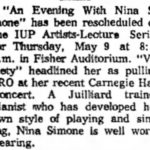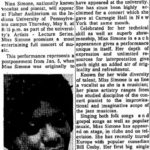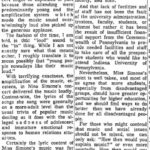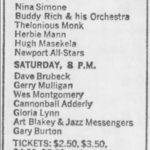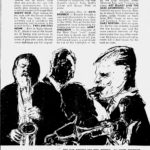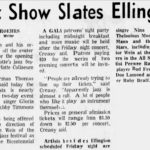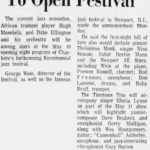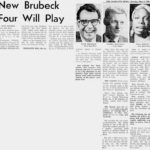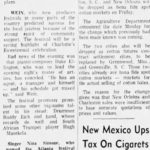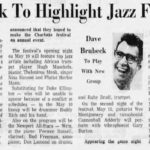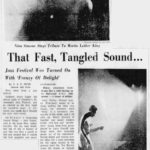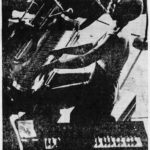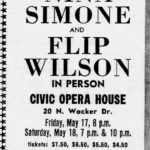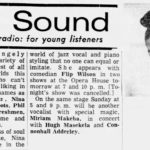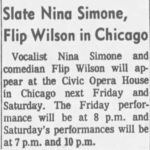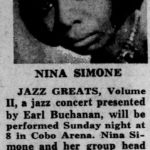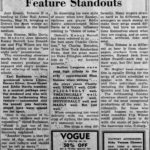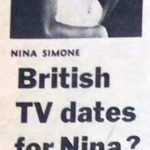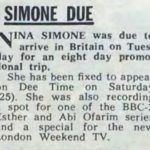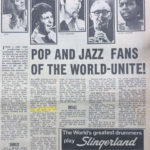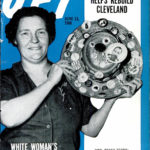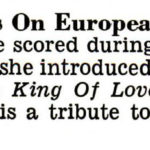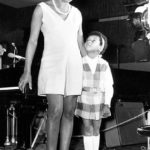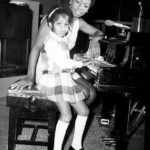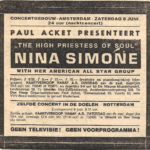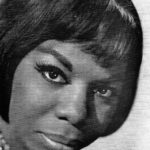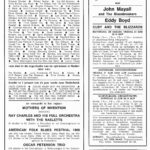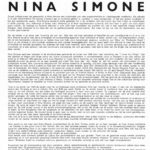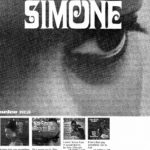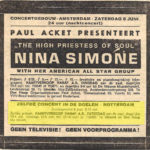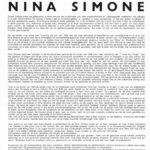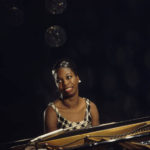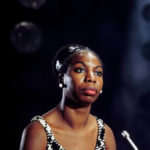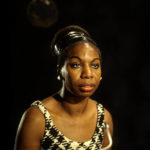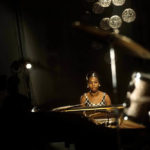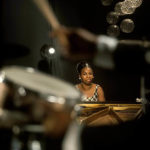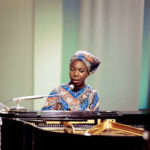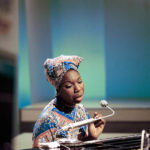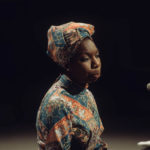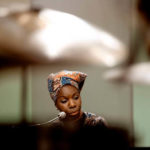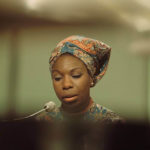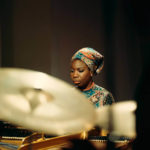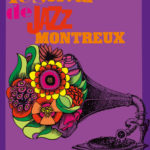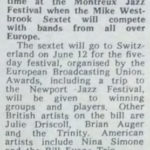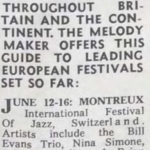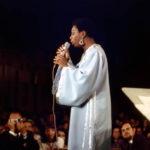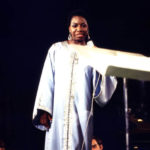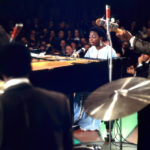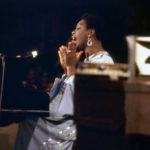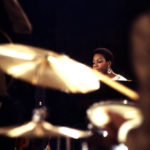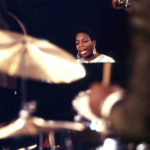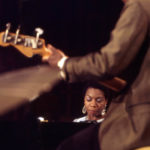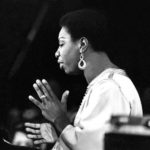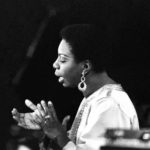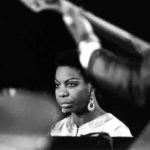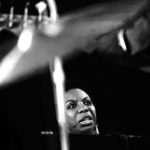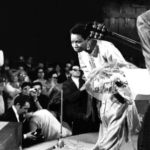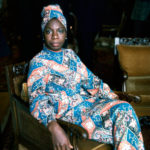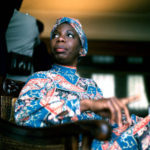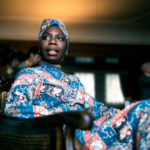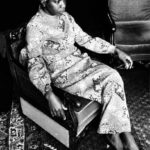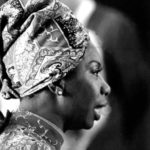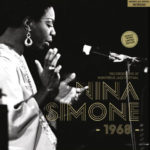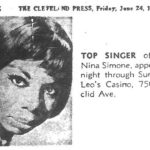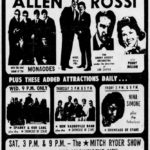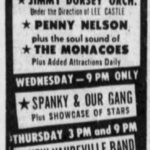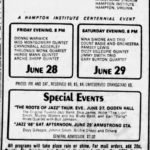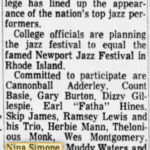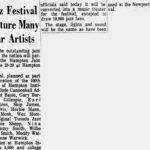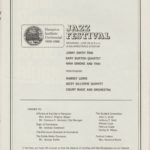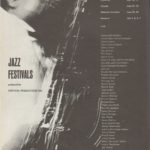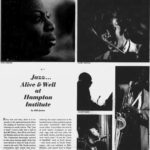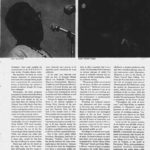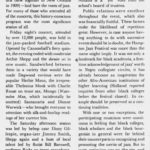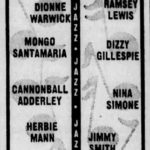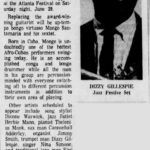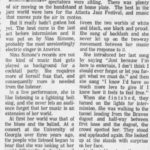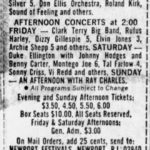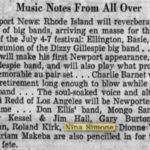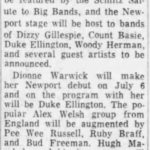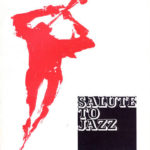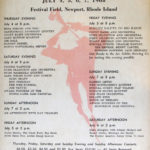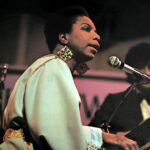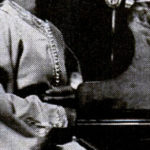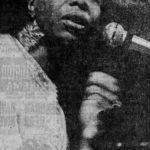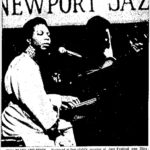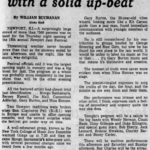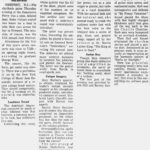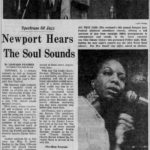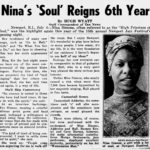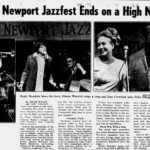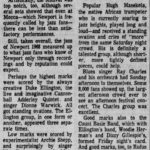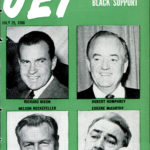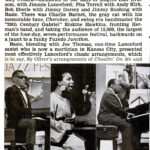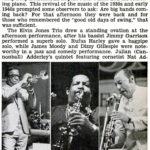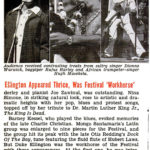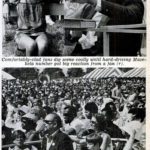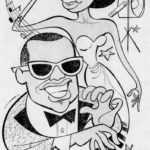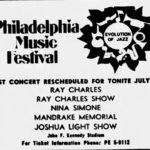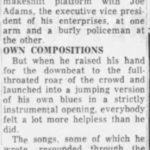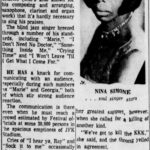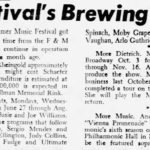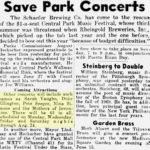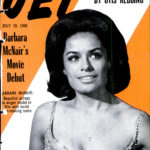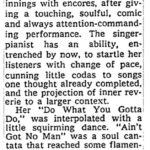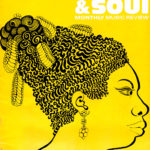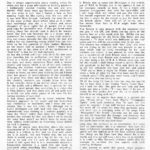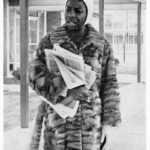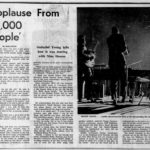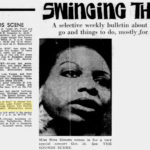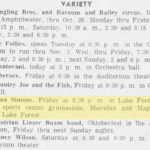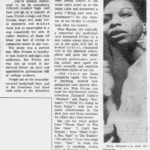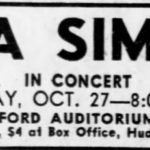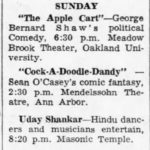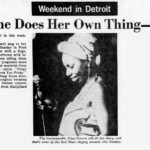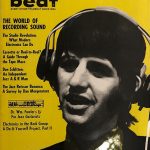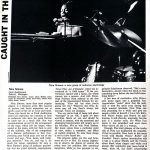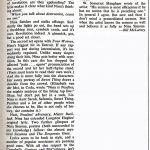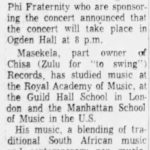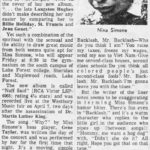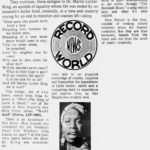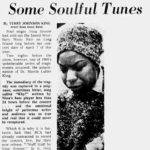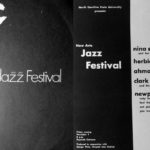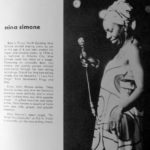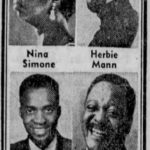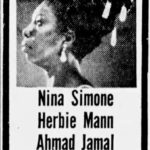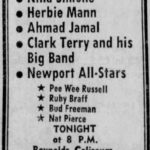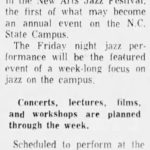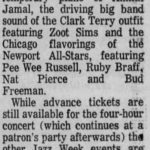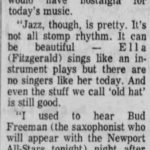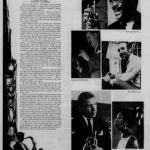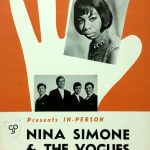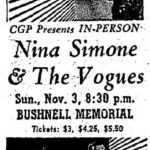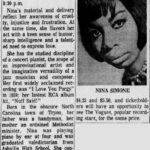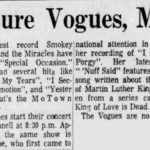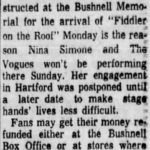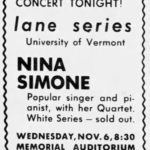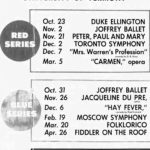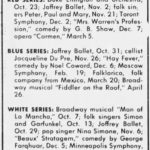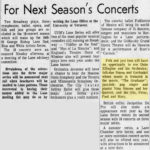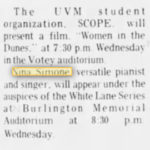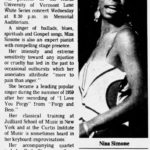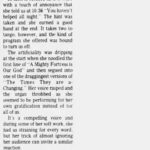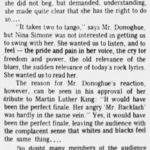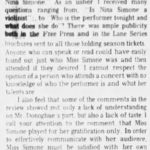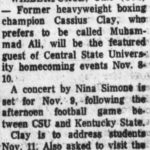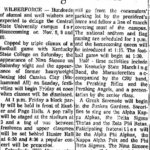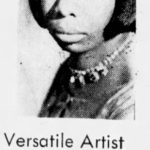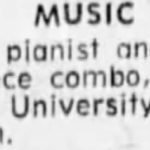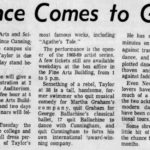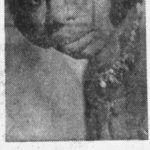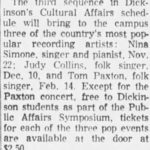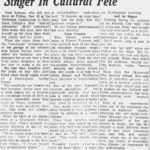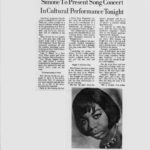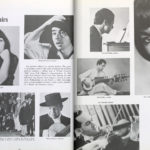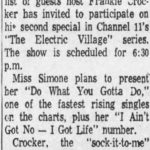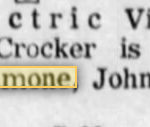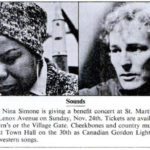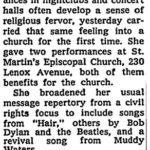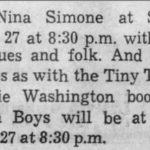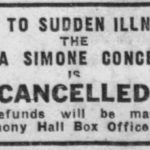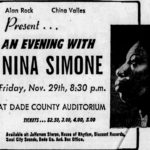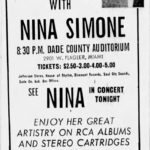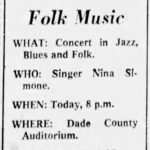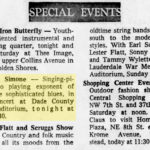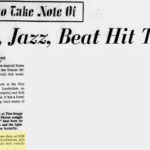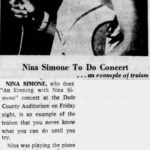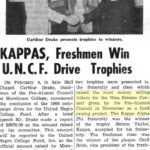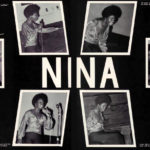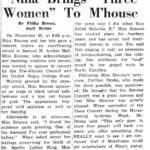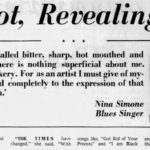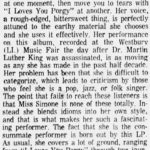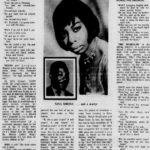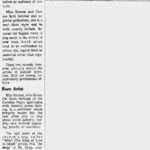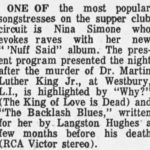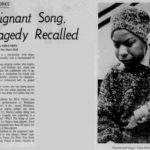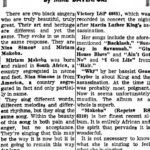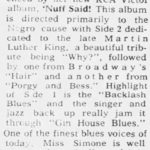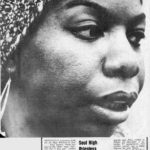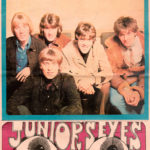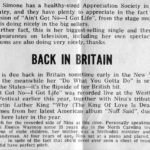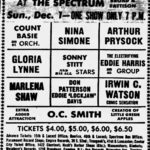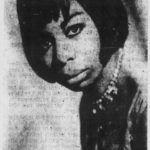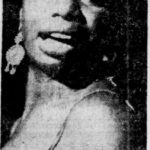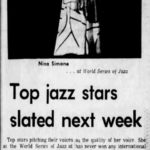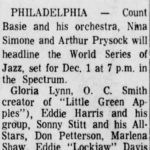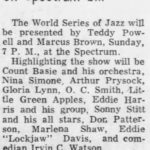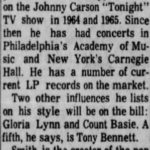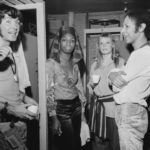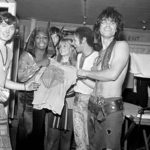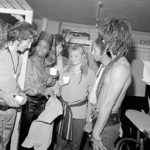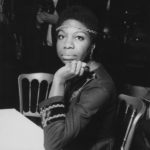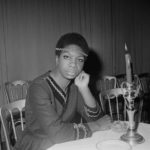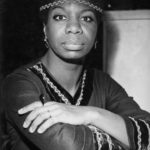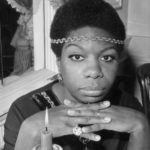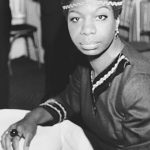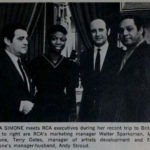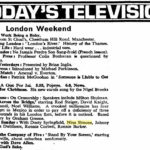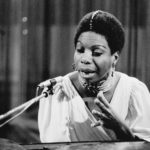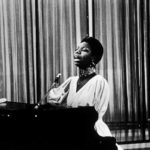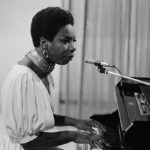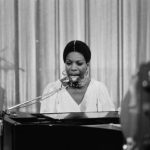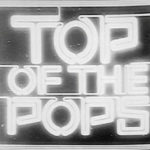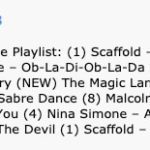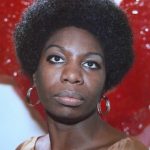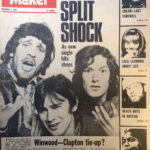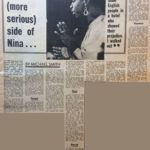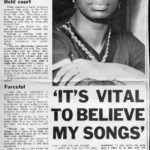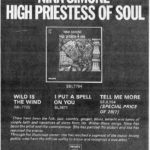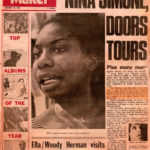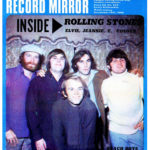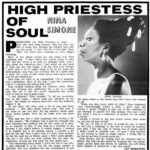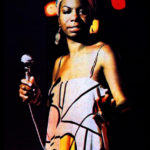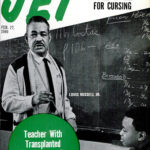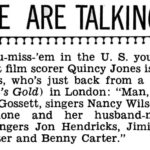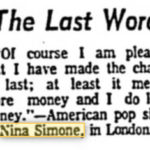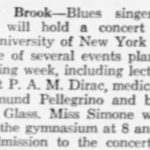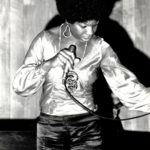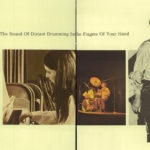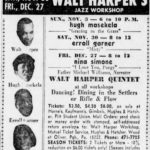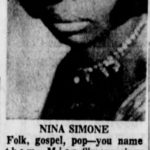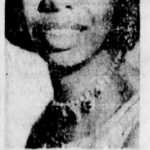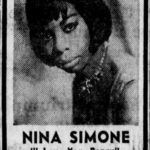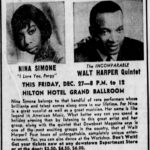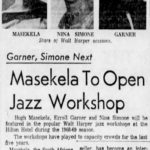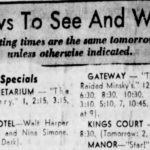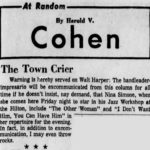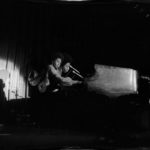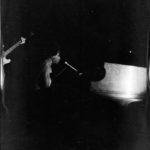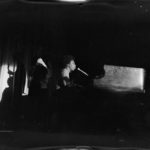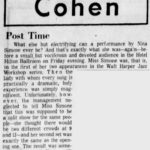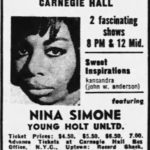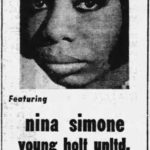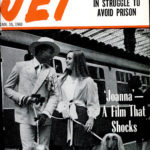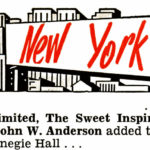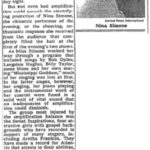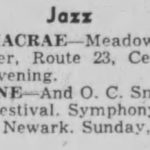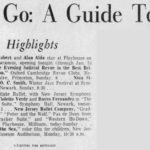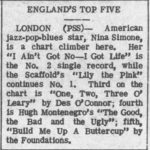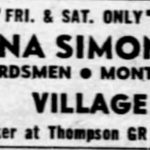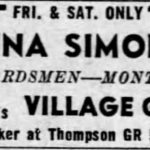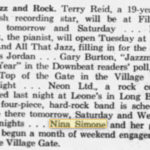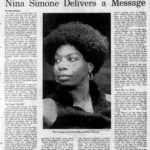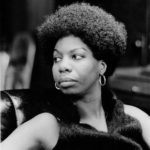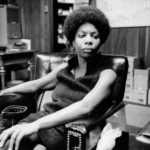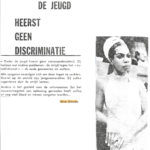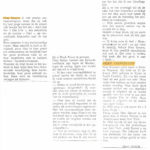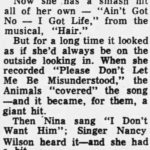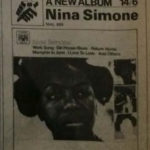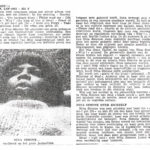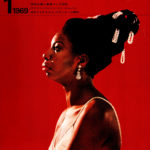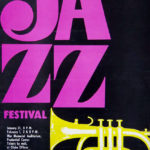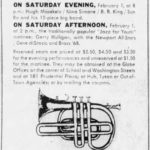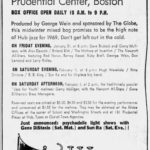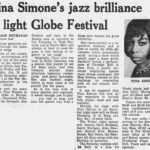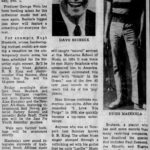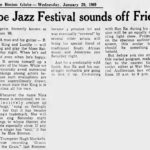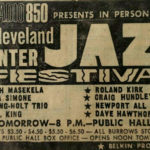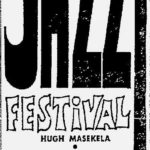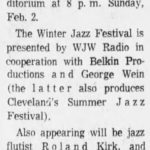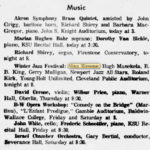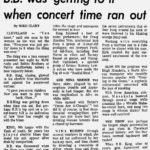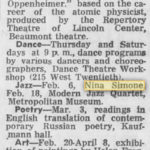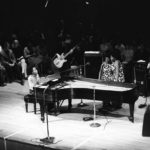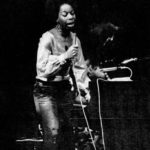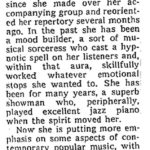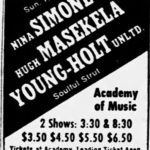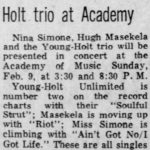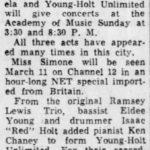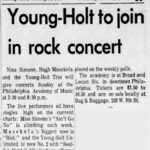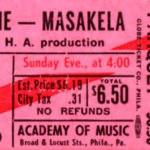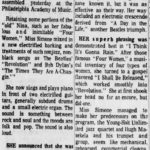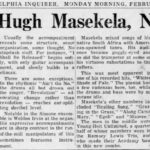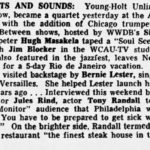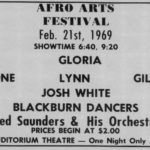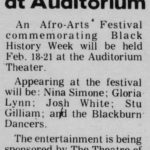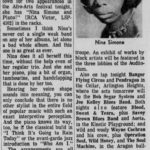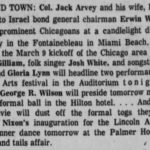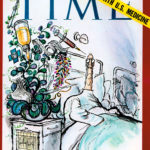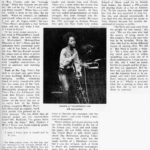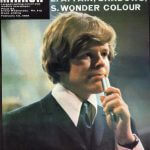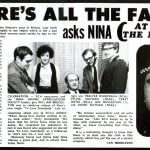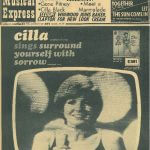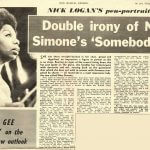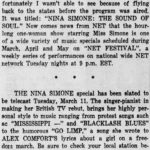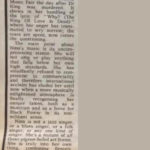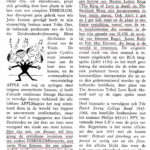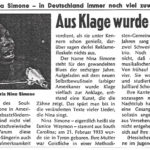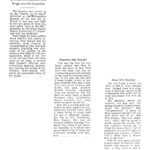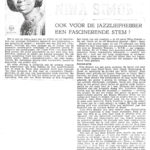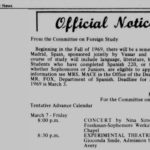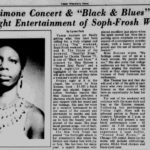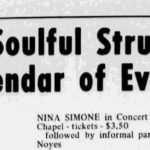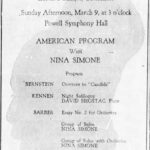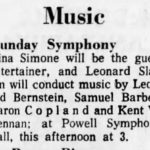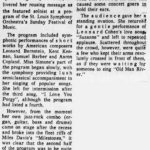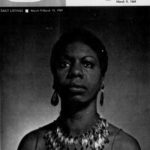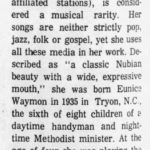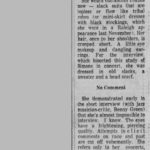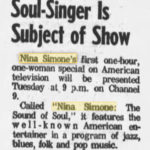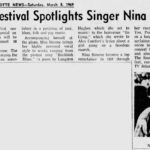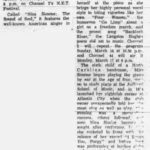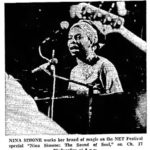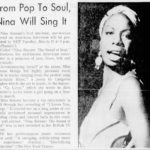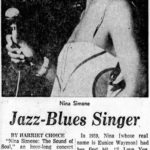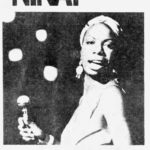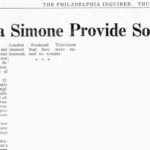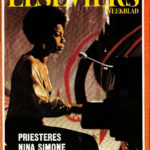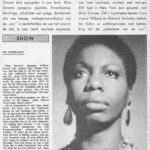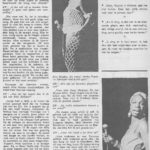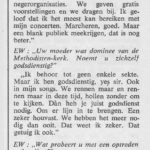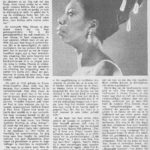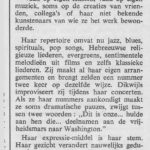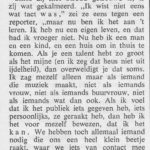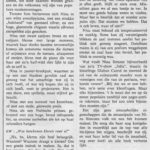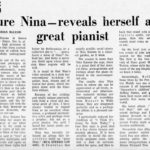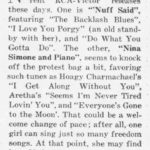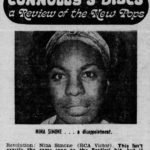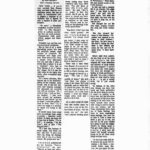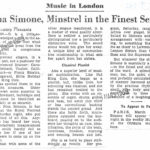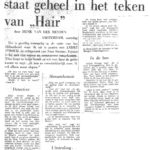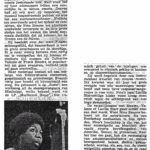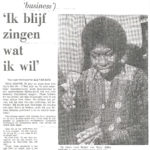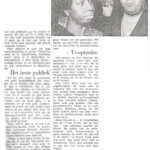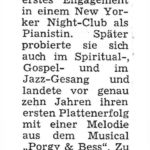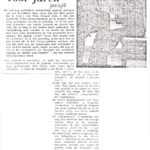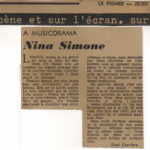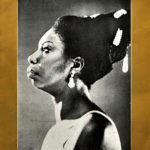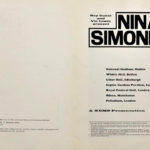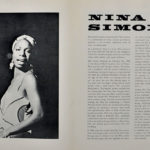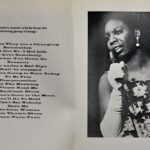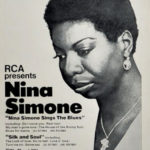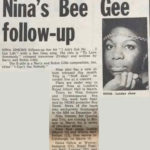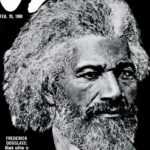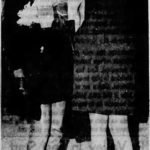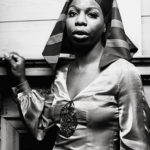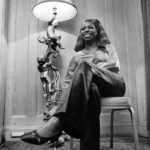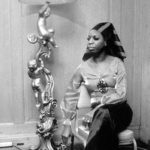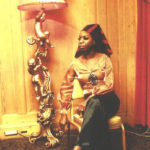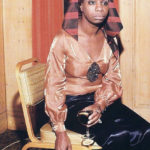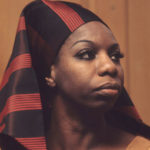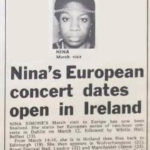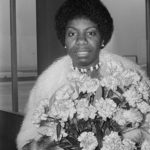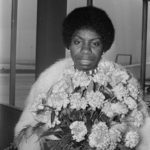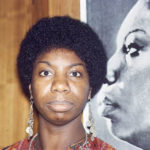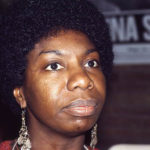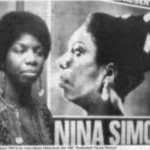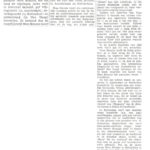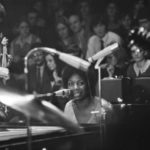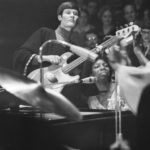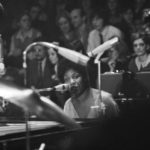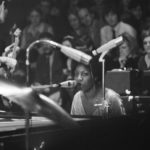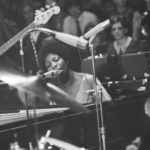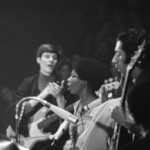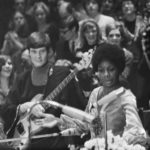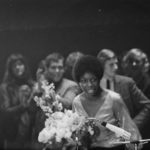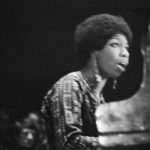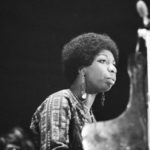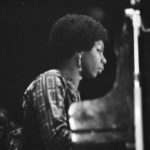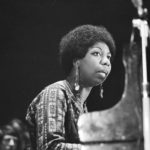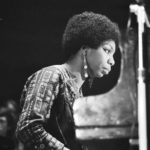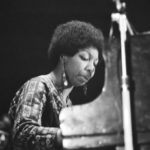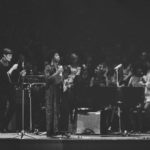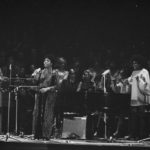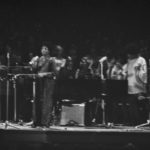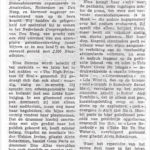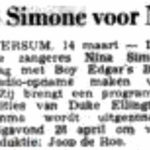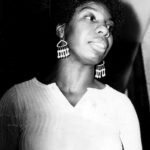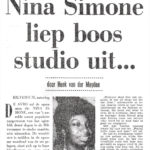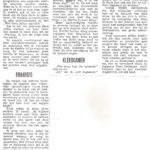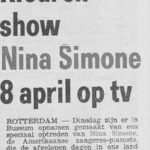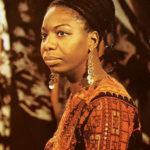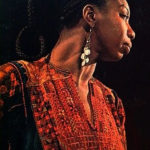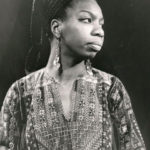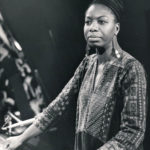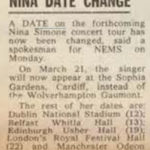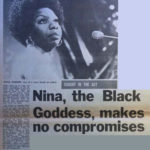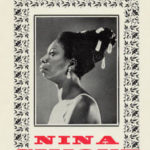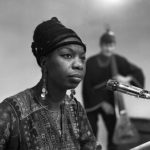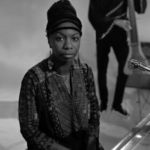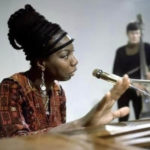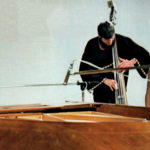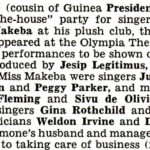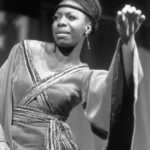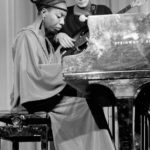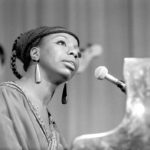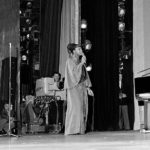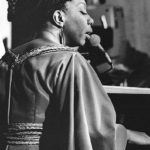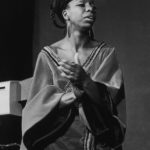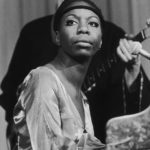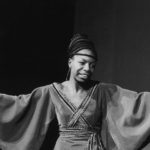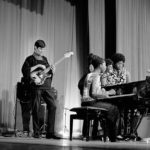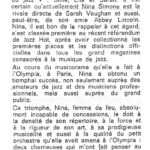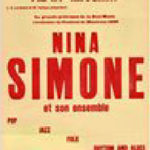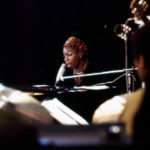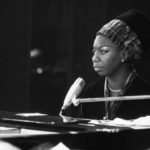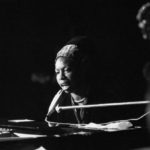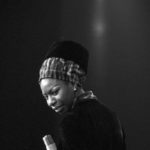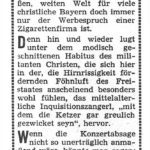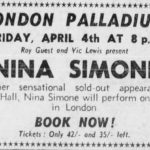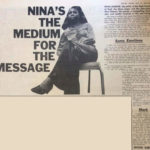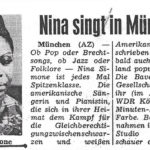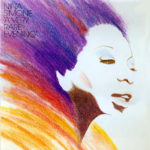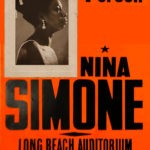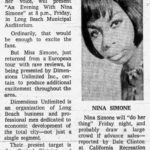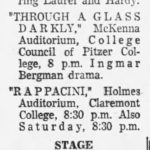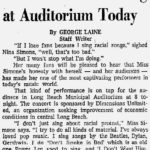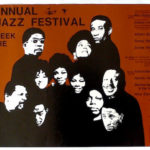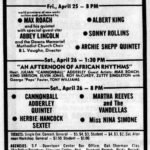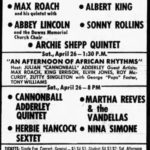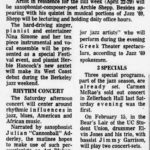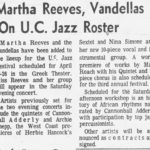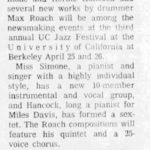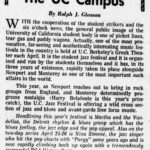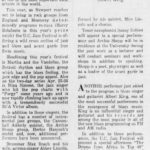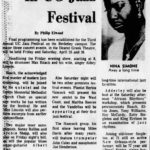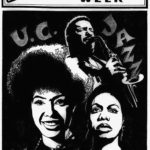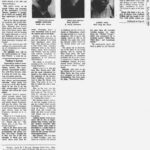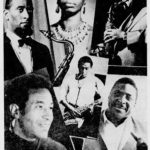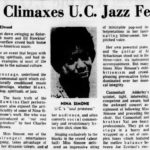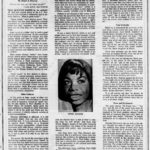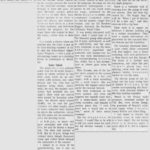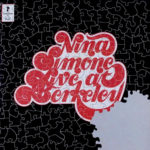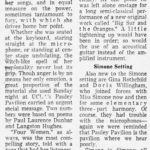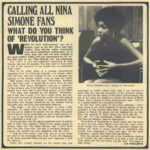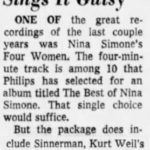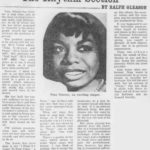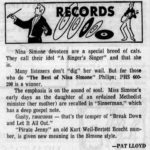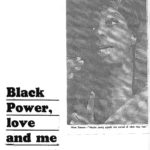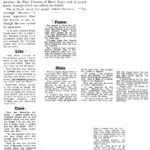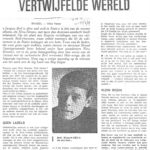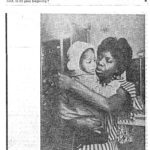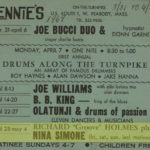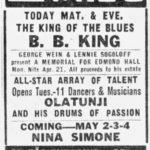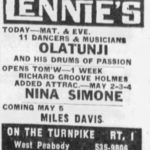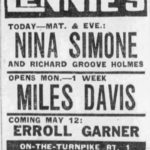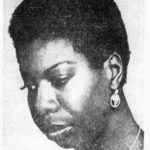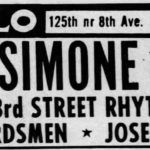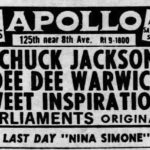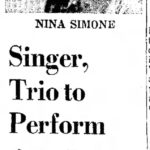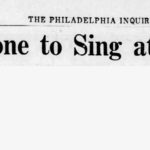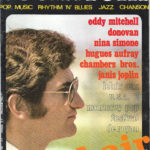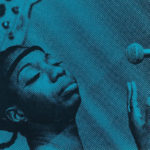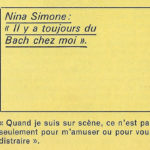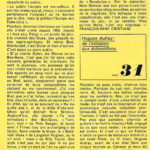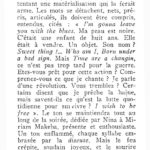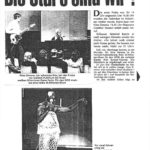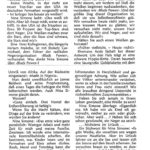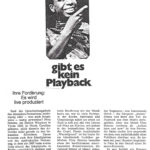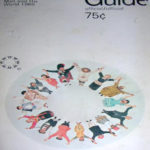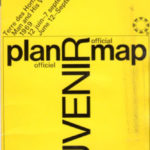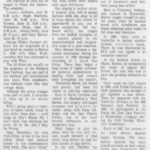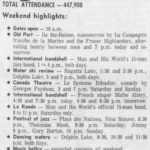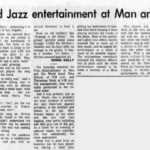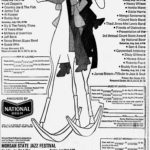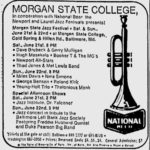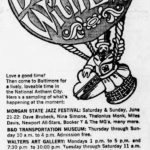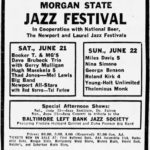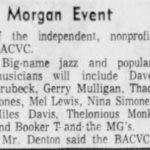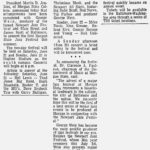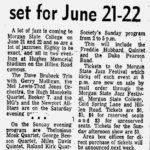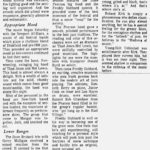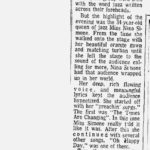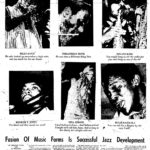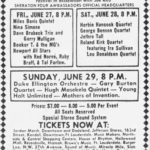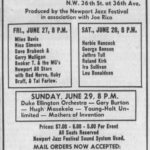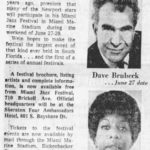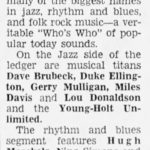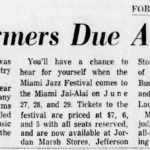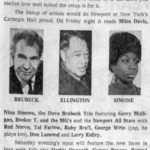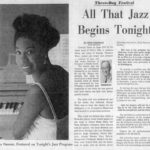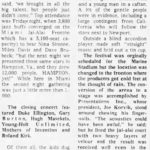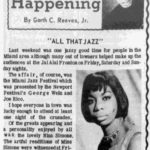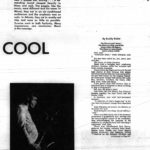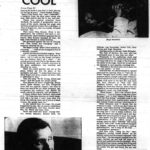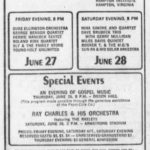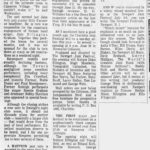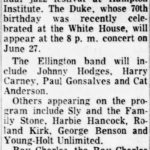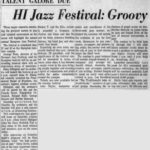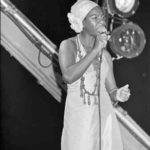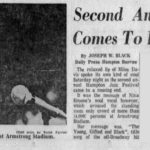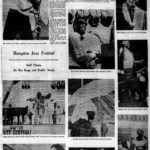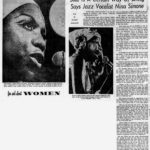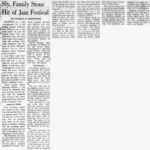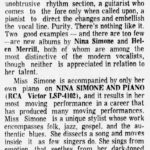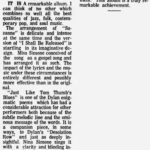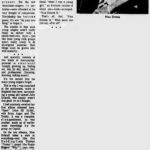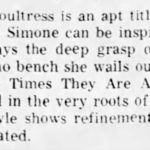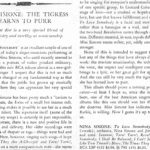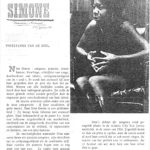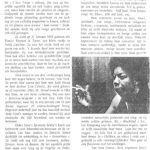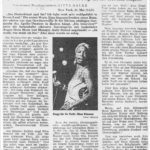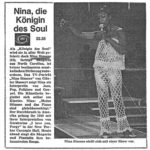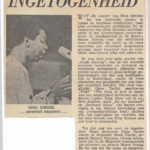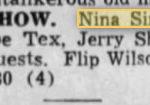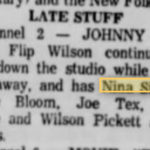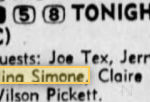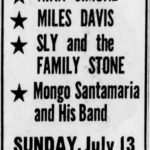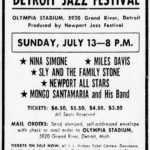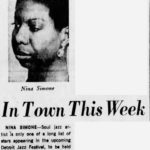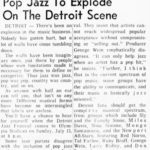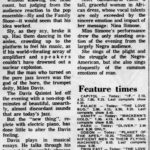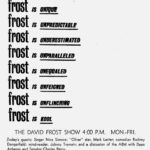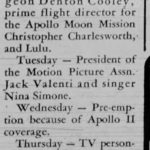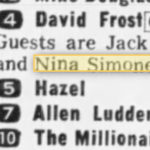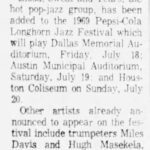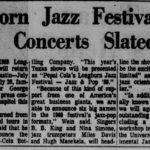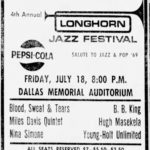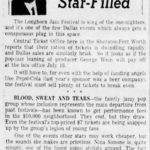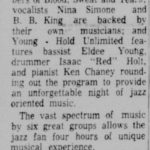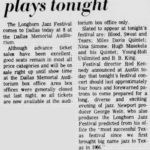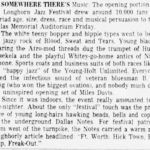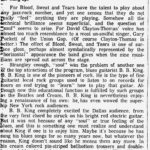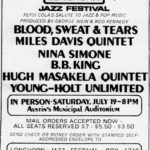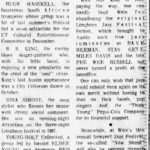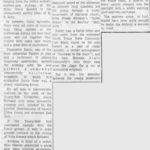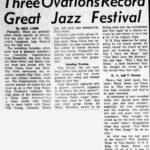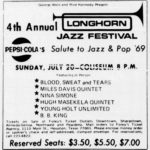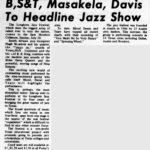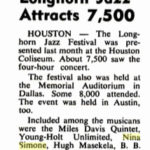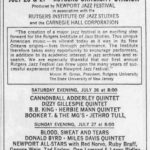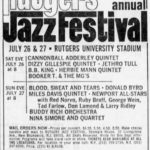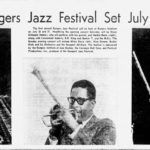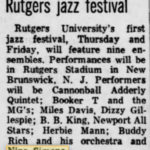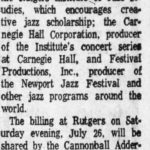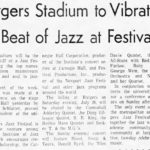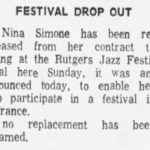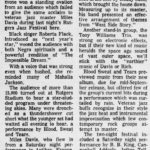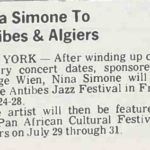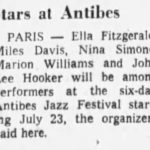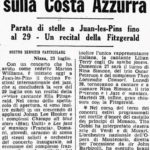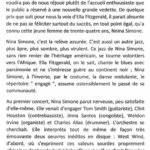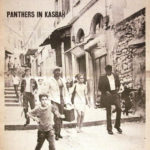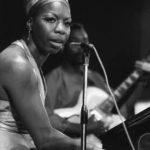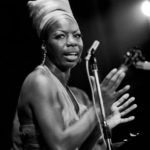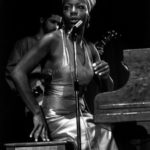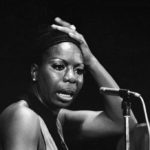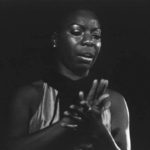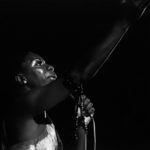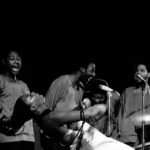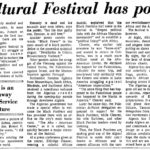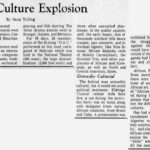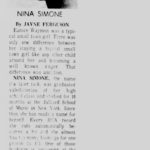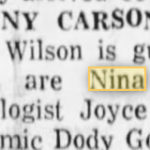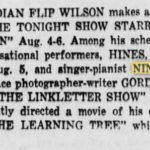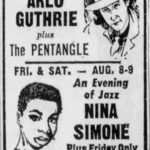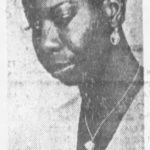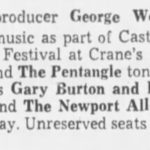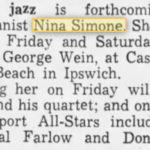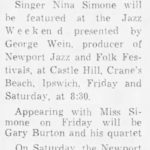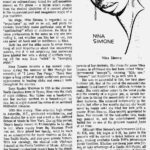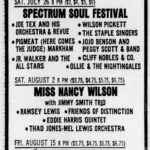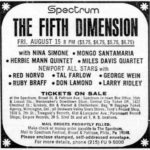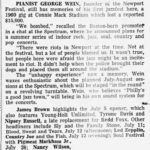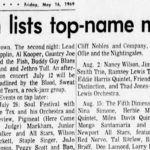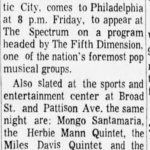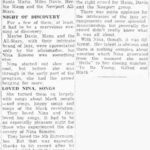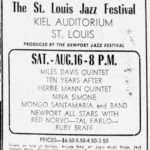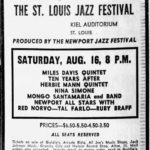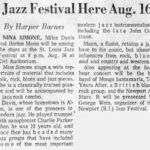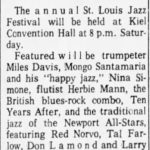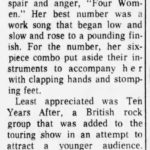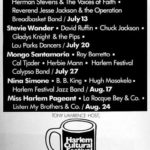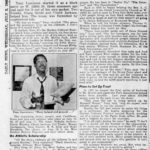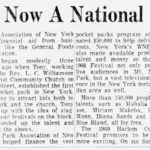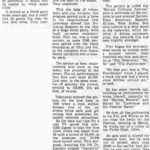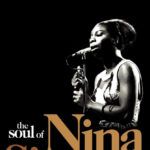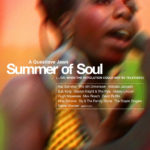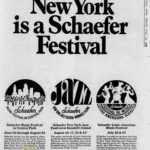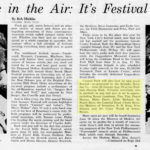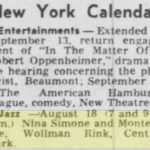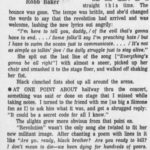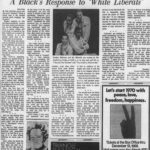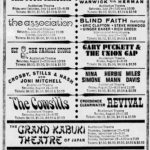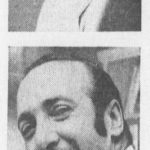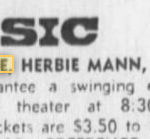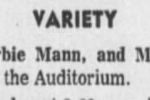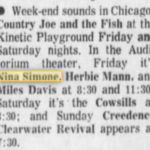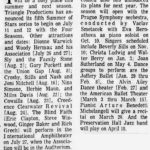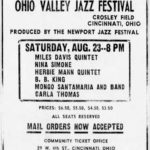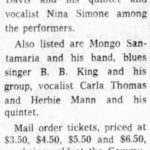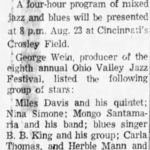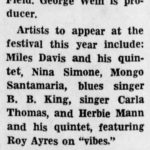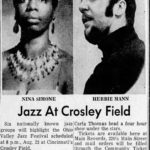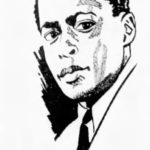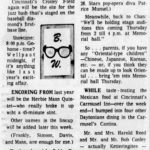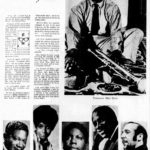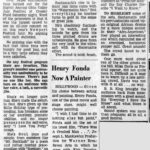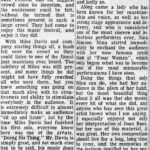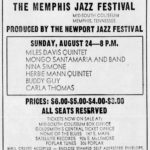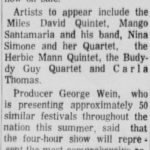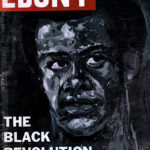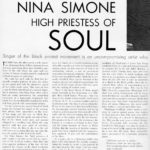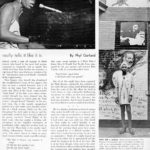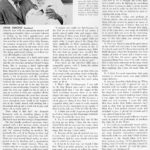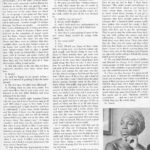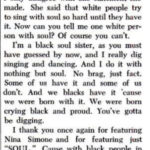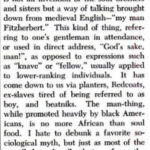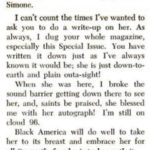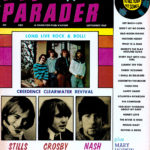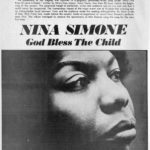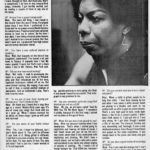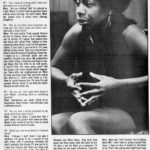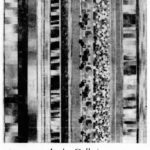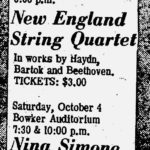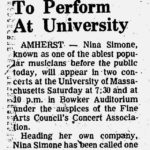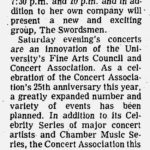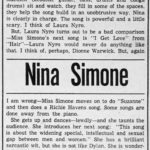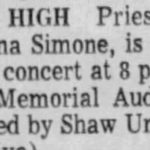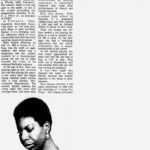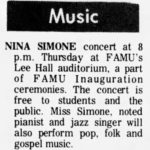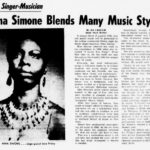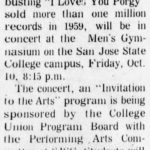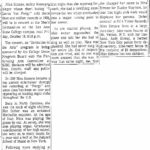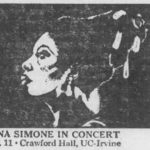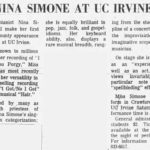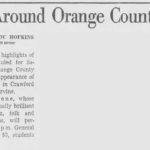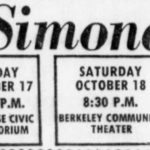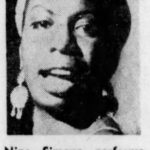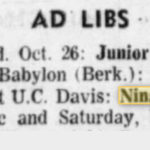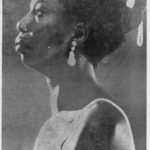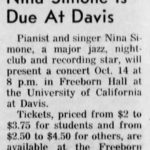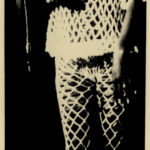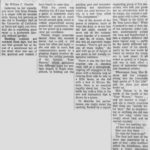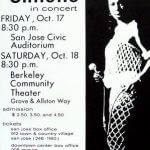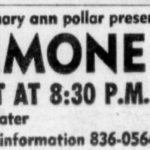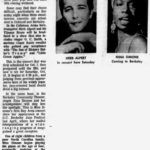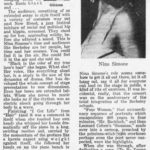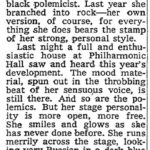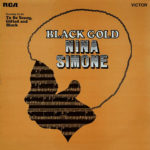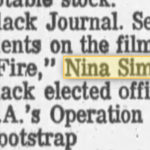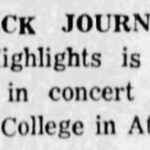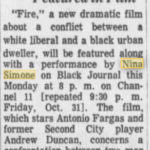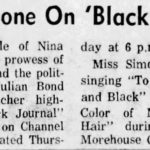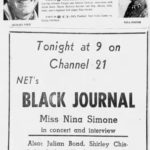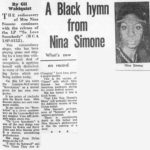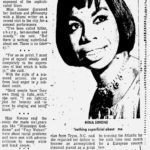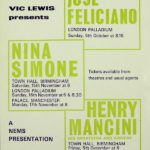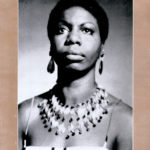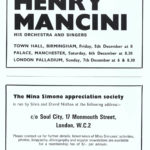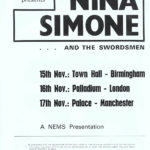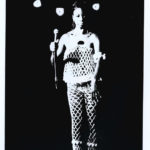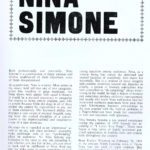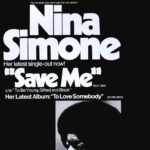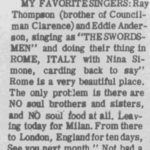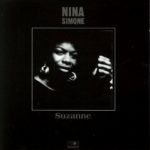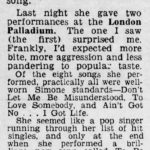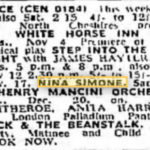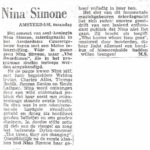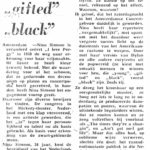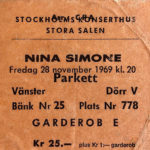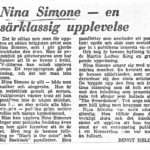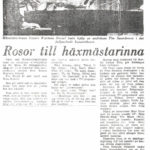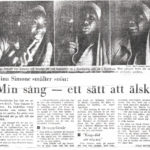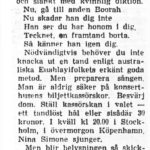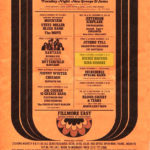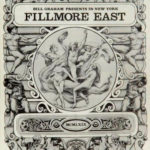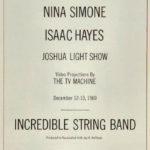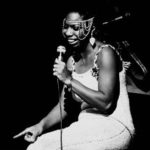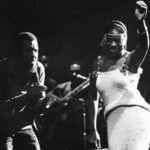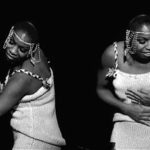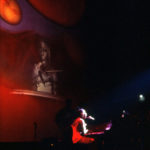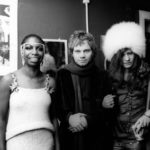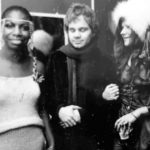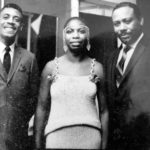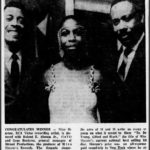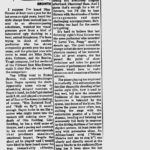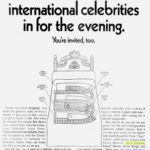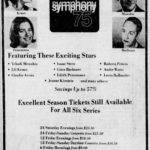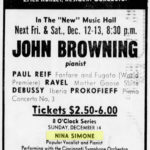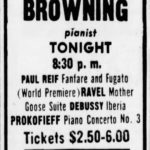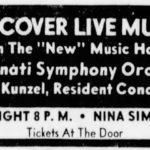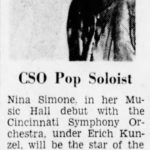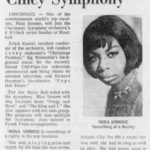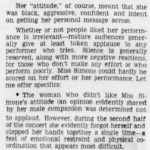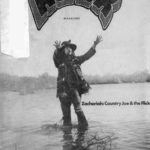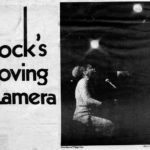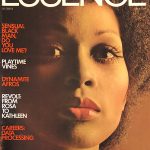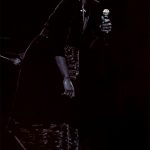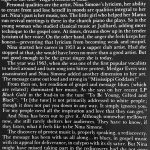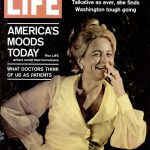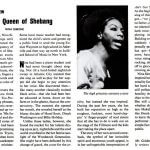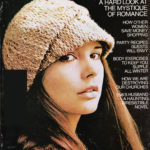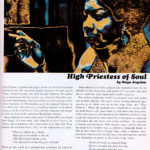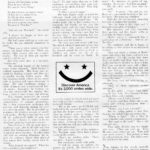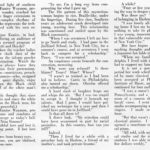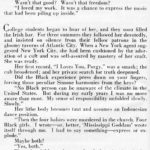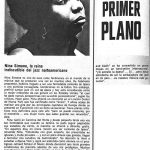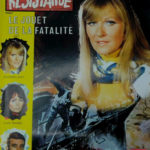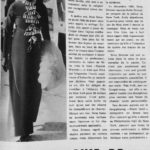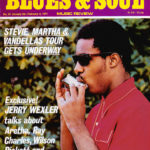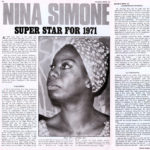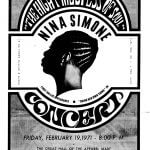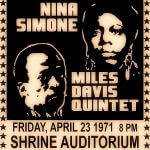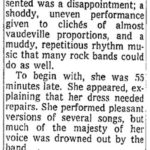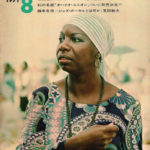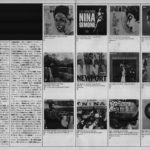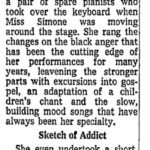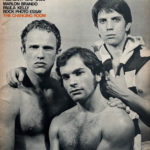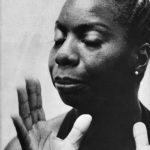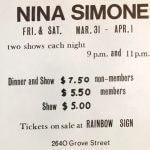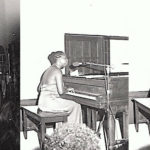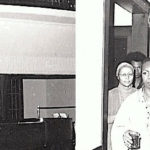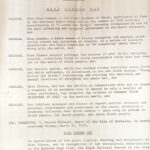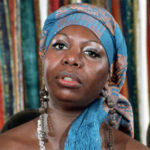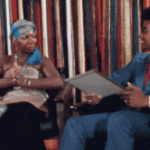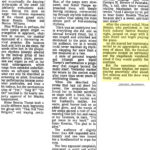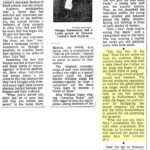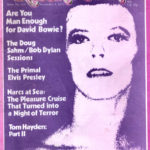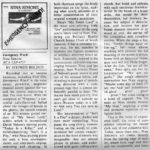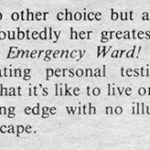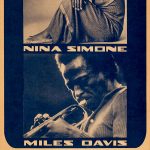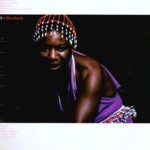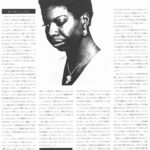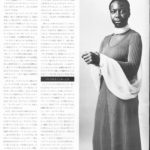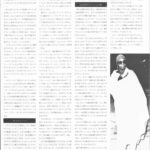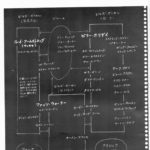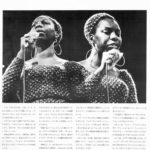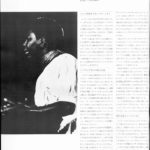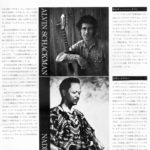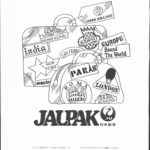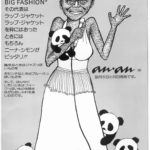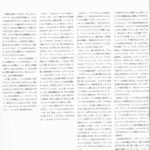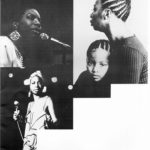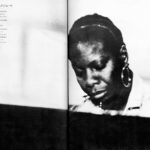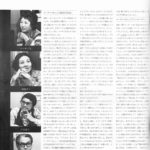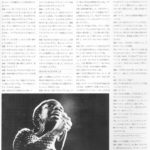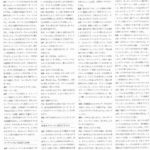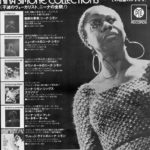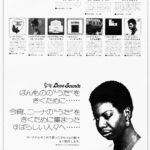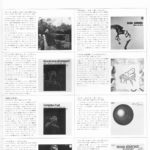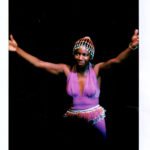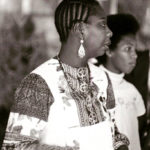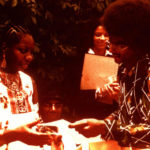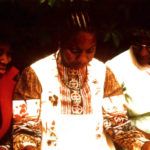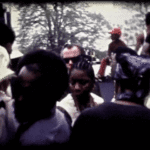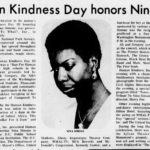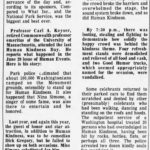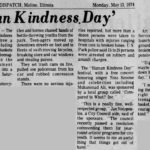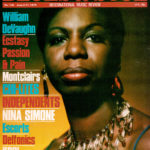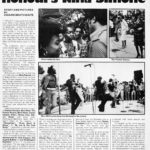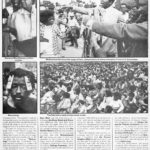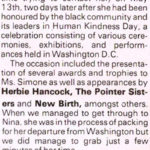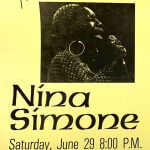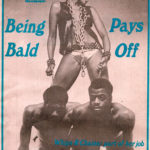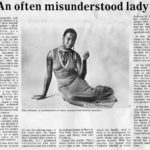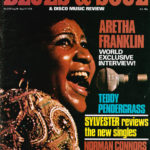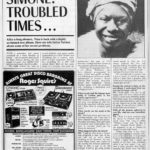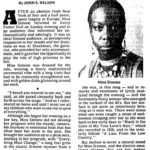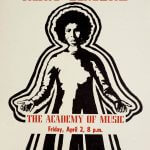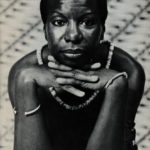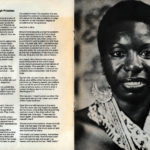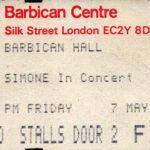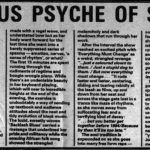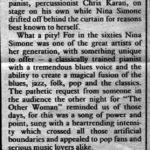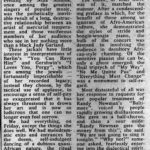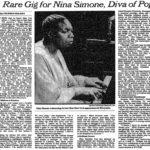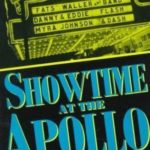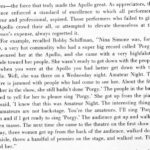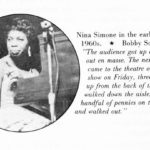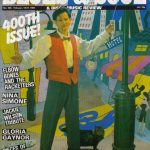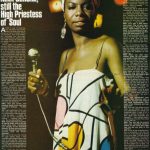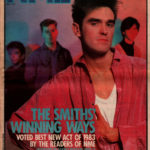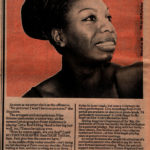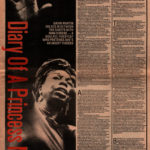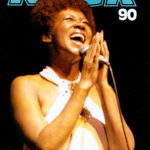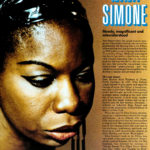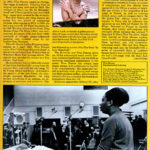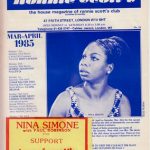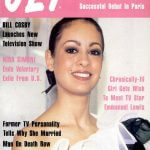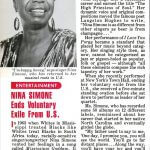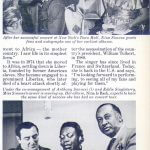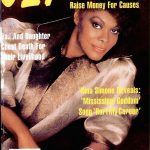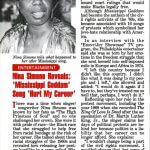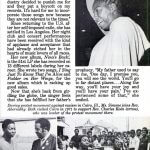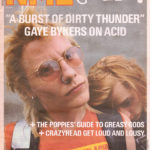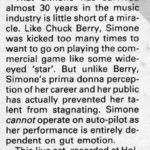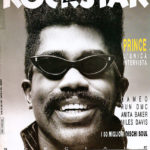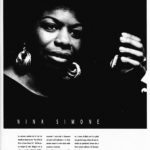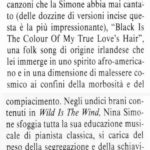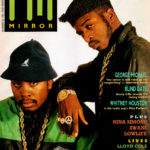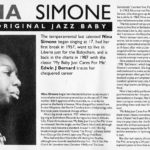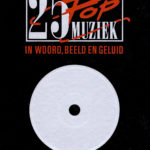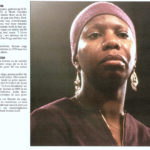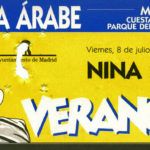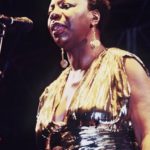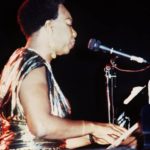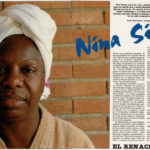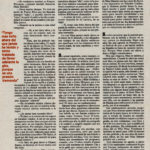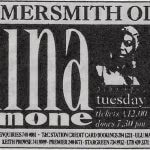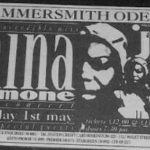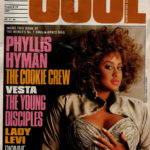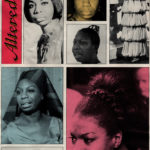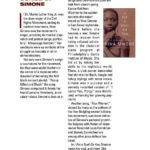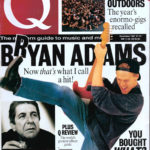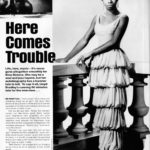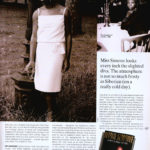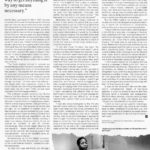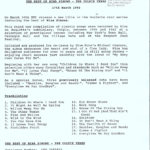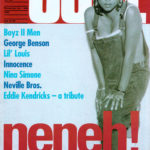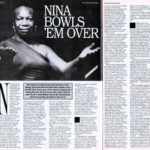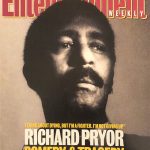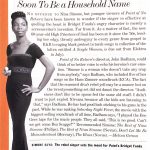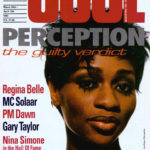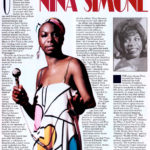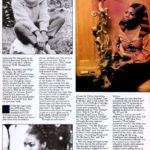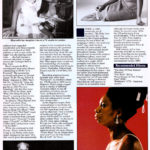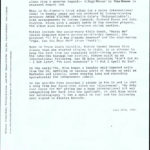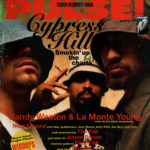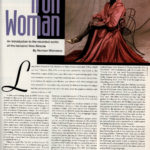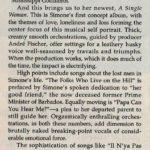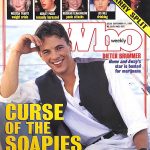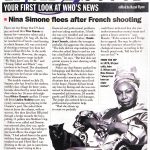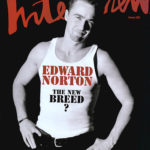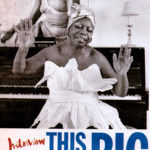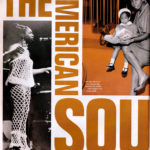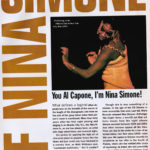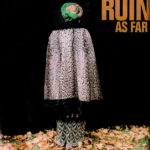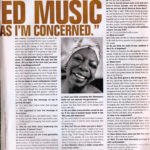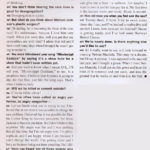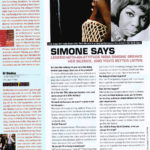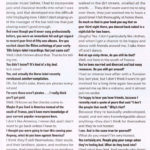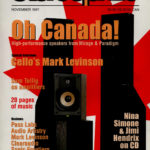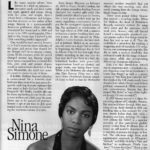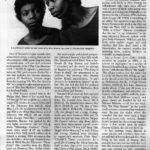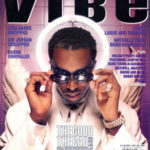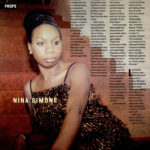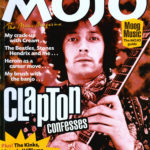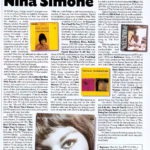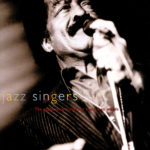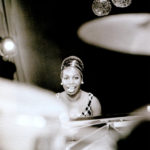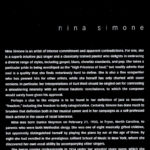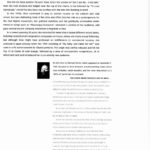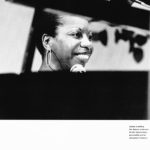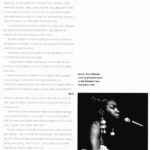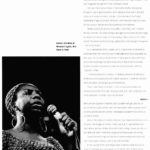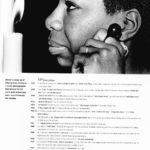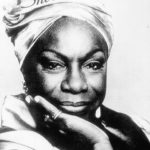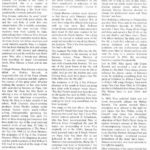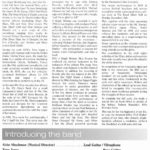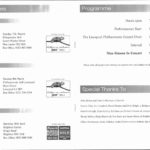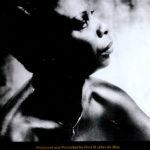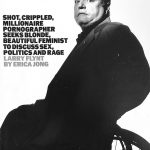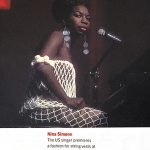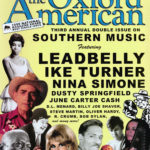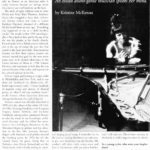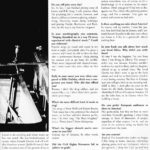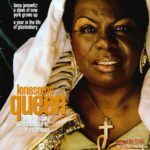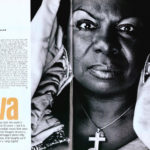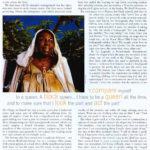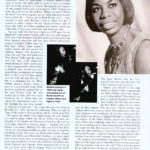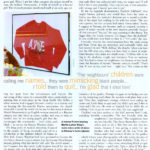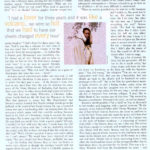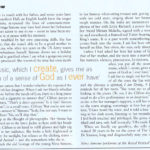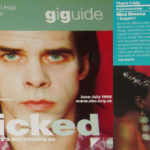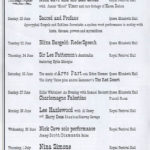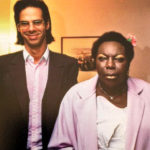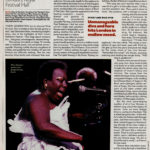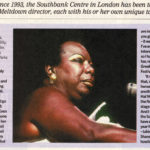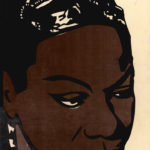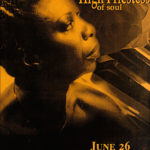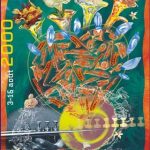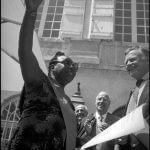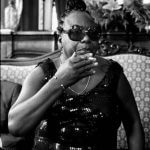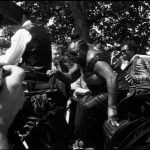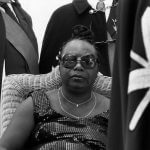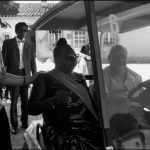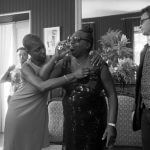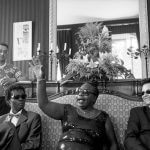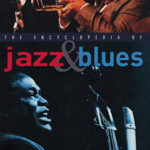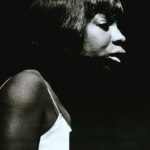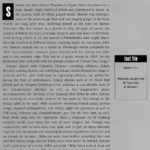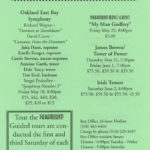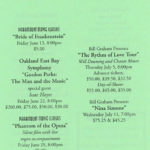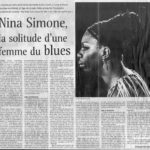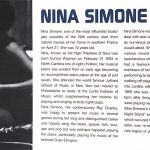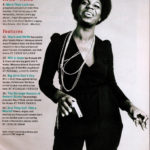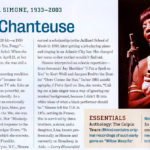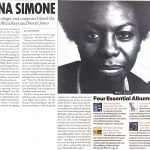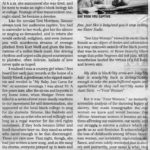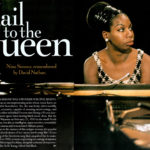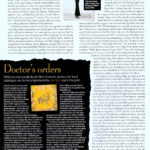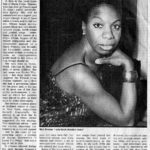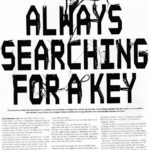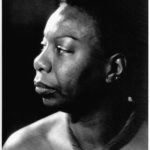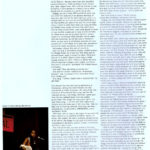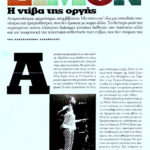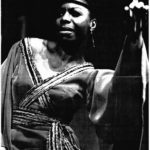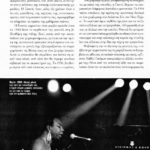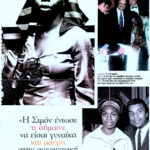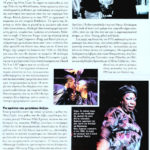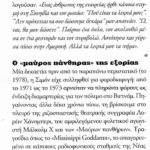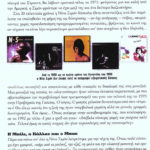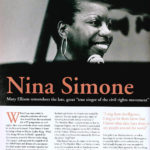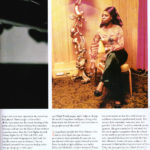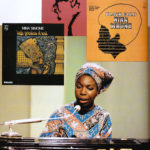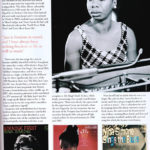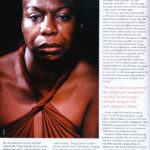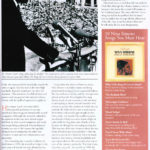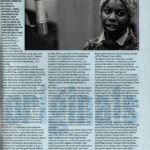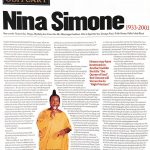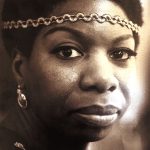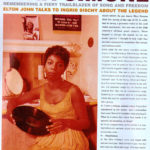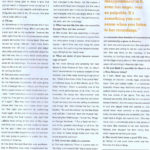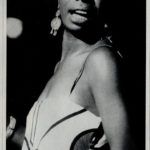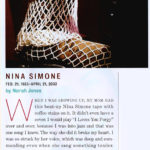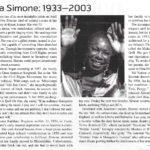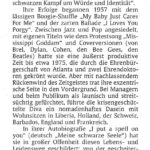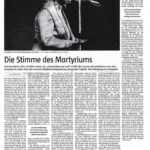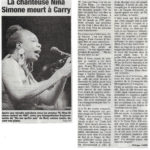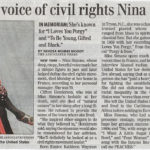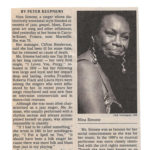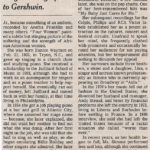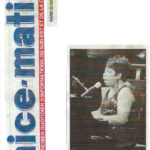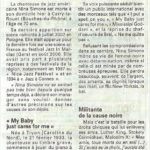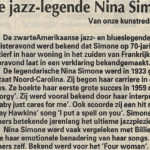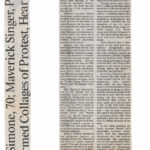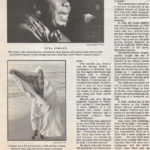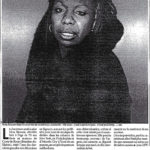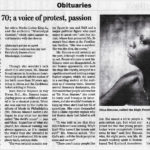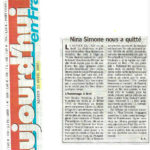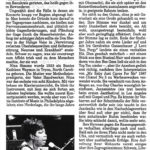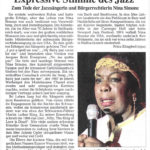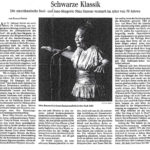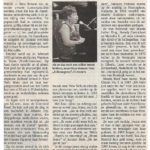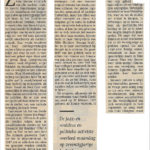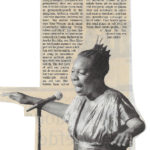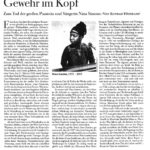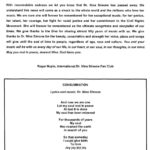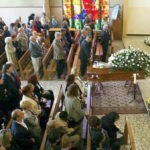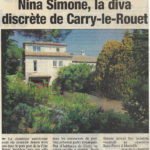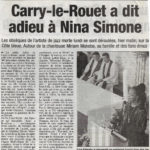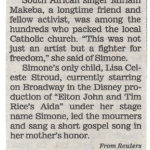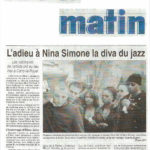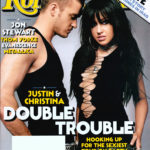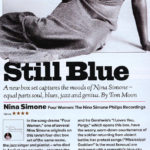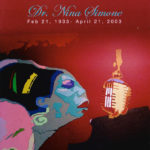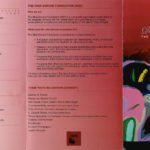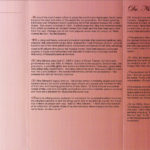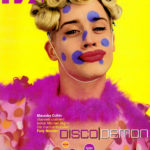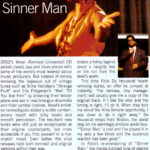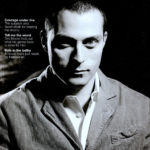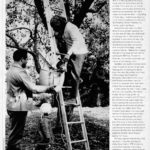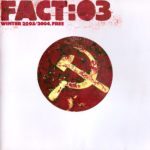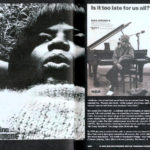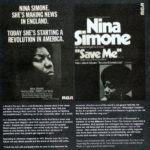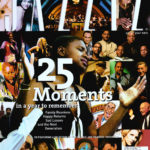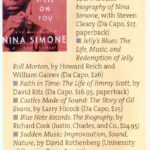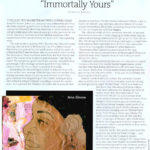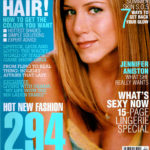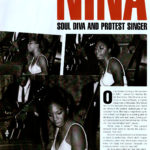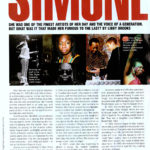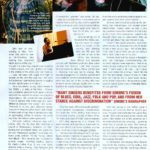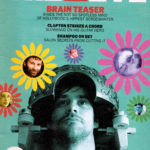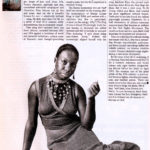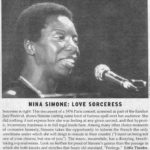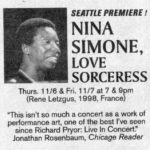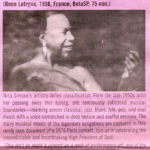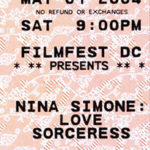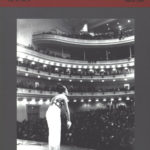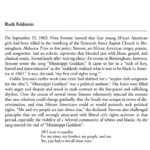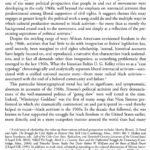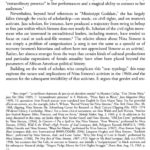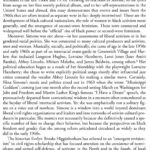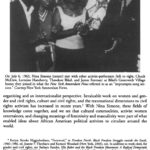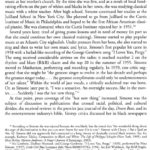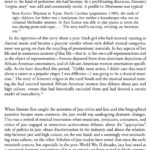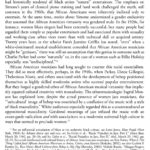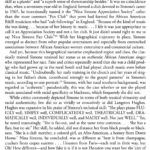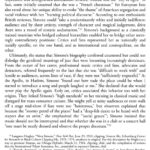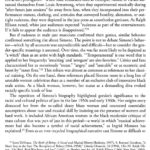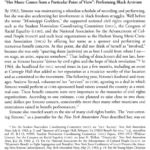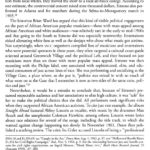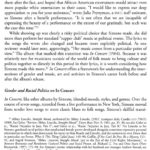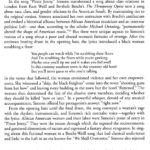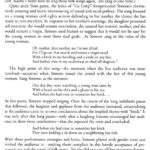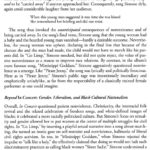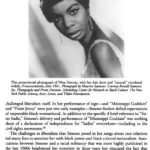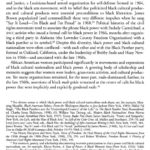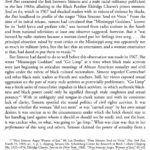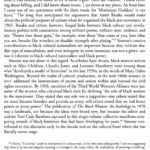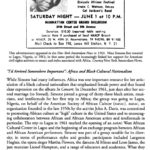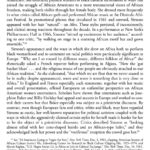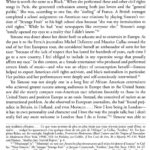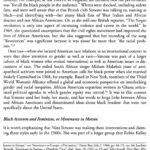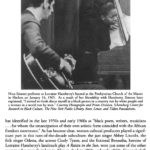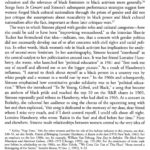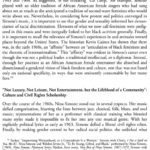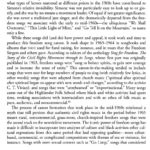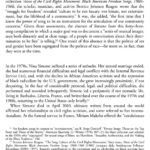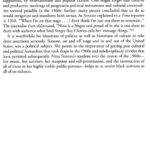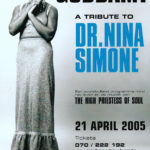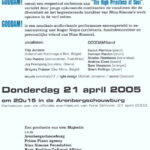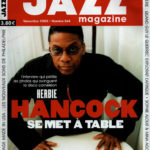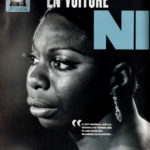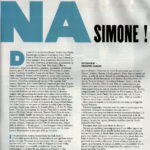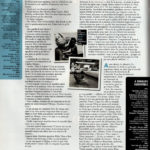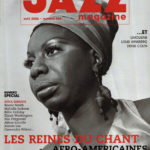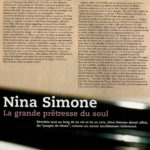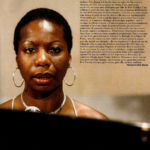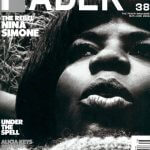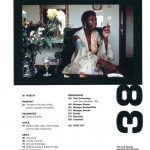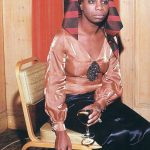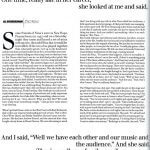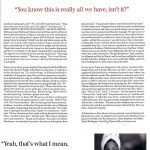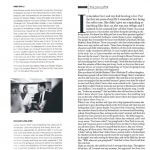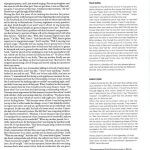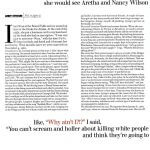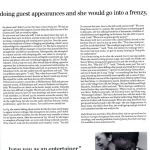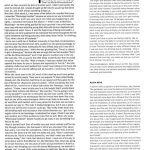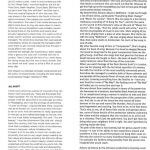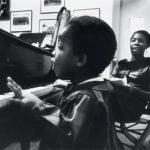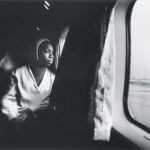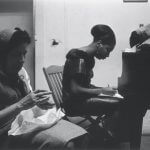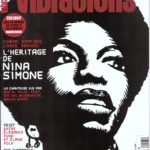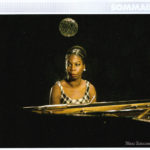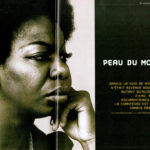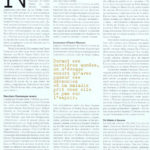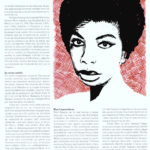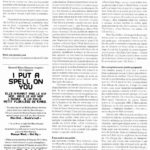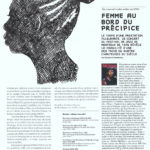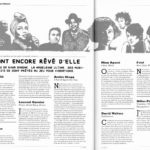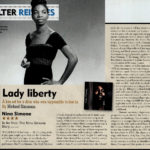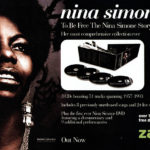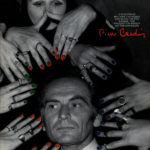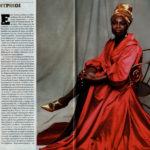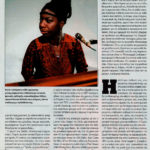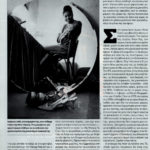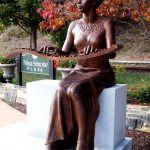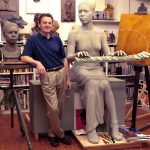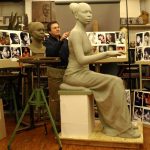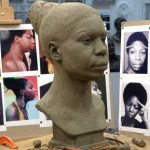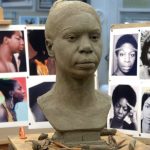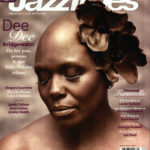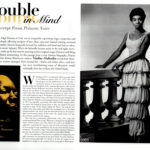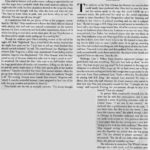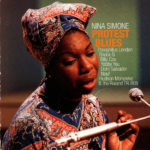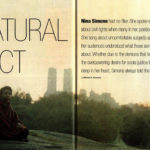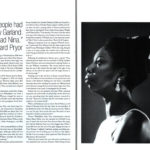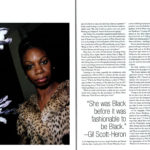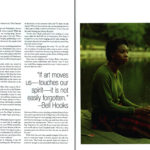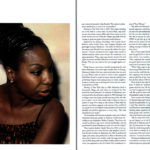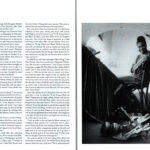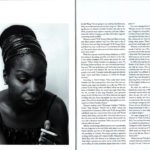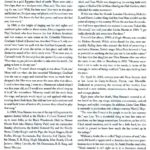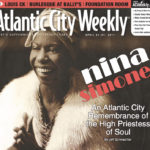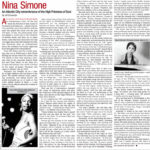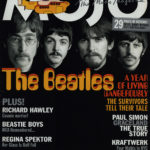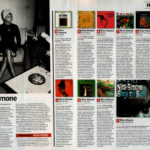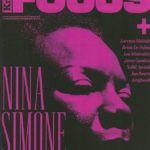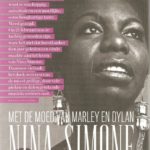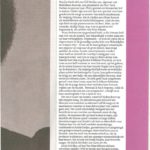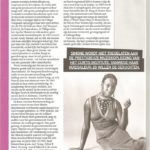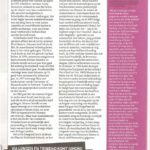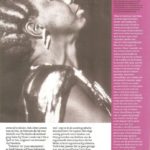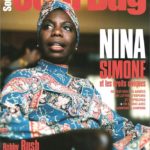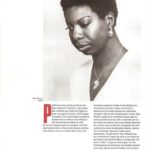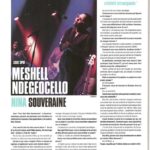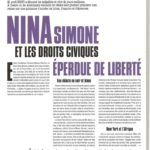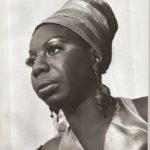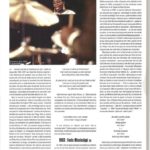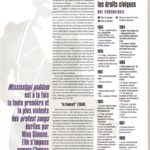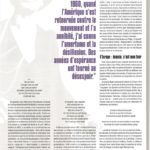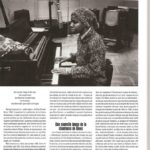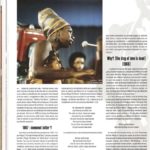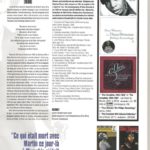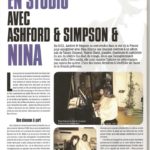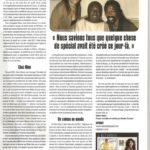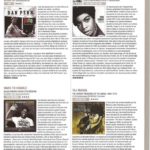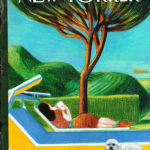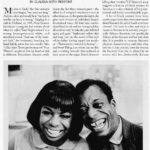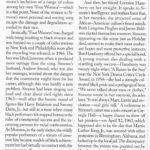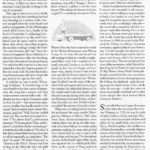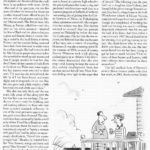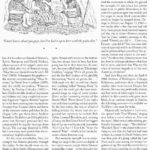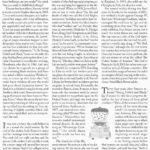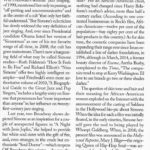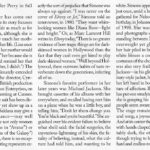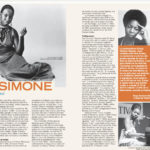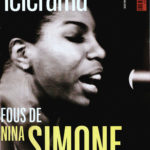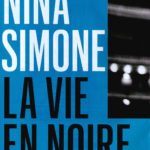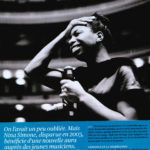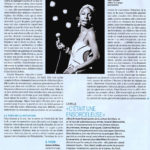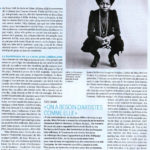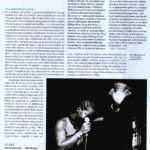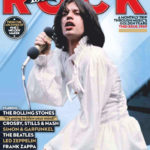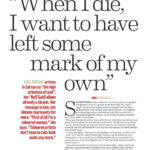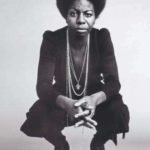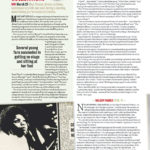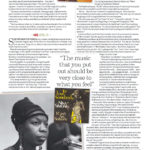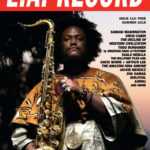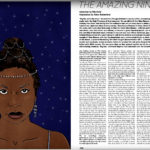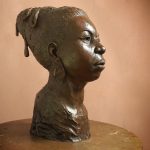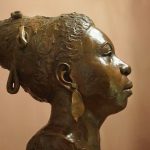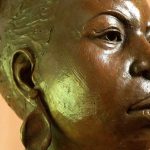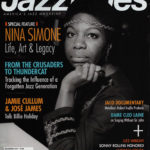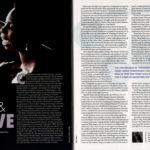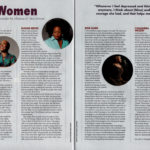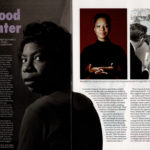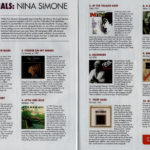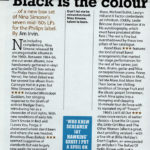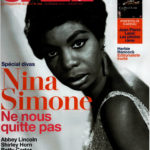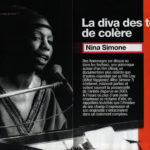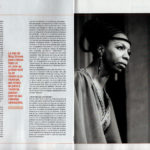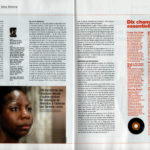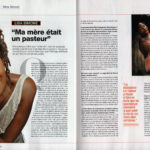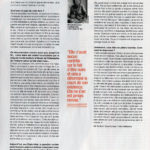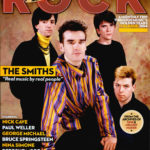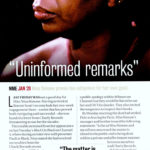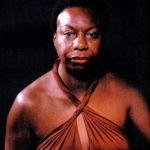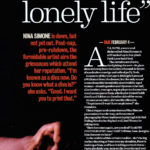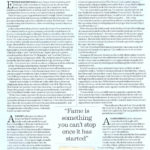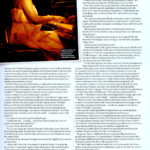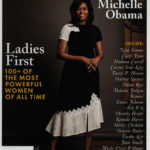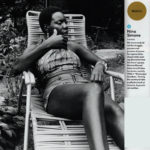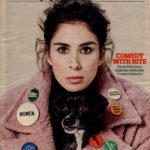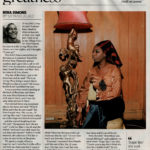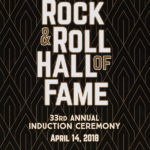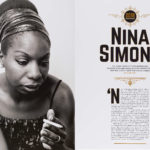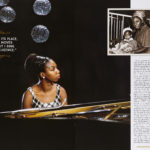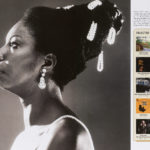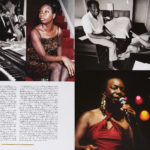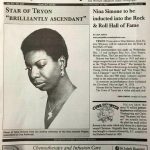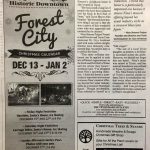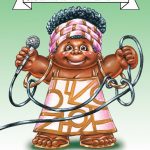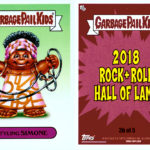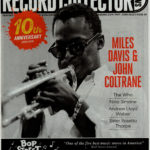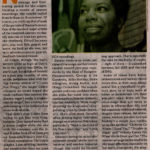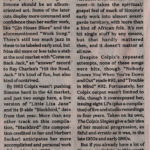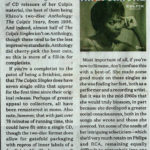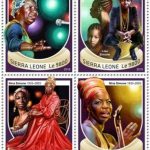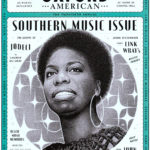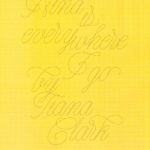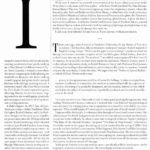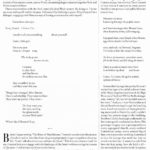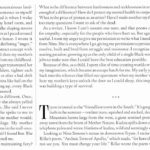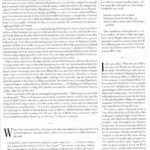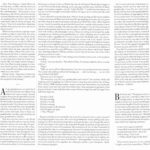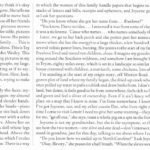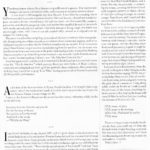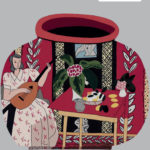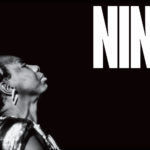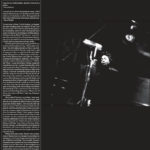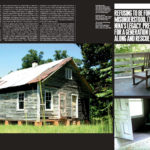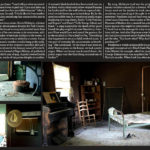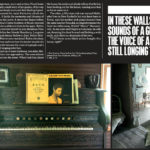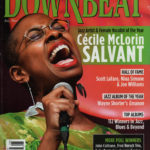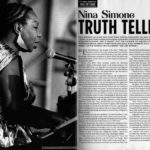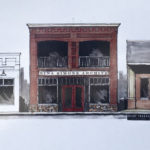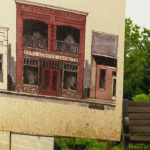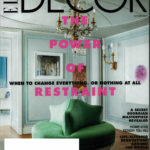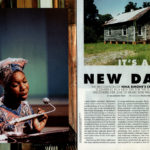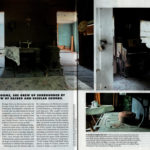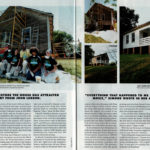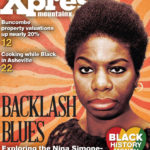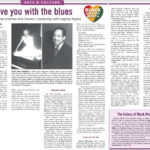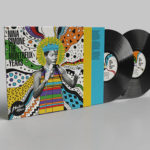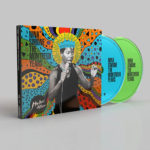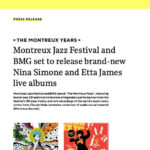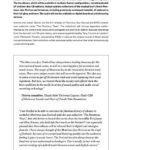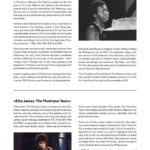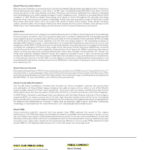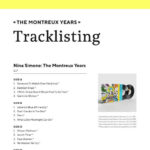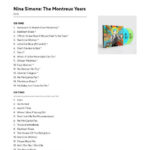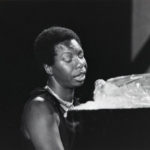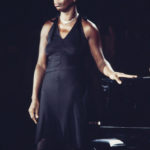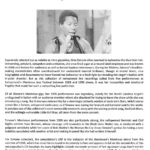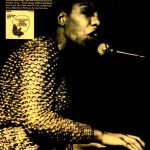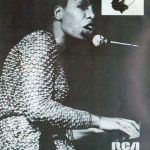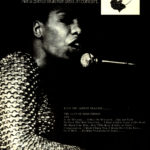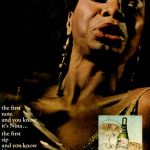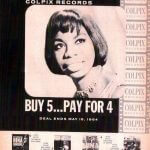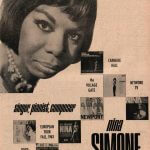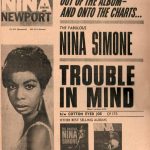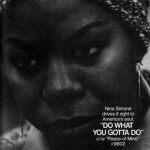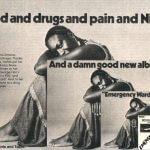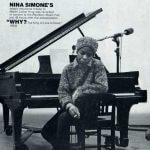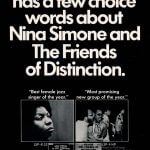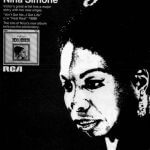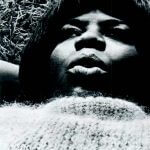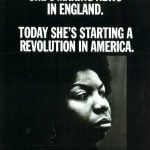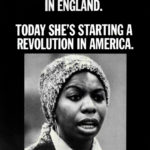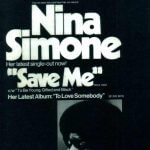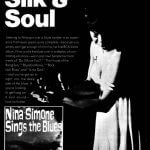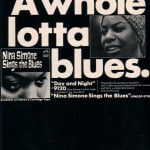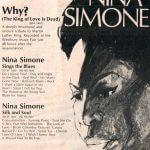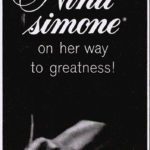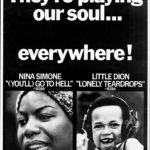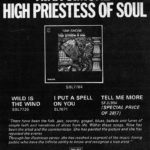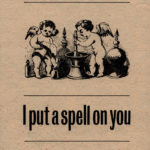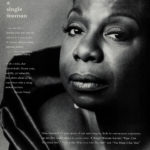At age five, Eunice became the official pianist of the Methodist Church of Tryon and began to attend a school for black children, the Tryon Colored School.
- Eunice and two of her sisters formed the Waymon Sisters Group. They performed in church and at outside functions.
- Mrs. Miller, the employer of Eunice’s mother, pays for Eunice’s first year of piano lessons with Mrs. Muriel Mazzanovich (“Miss Mazzy”).
Waymon Sisters:
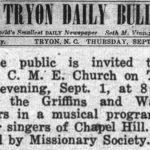
Muriel Mazzanovich:
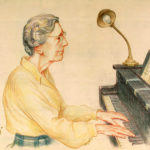
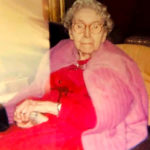
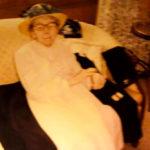
Mazzanovich studio:

click each to enlarge
Eunice – ages 12, 14, 16, and 17:
In 1945, at the age of 12 and with assistance from an education fund setup in her honor, Eunice enrolled in Allen High School for Girls (a private boarding school for Black girls), located in Asheville, NC, where she excelled and remained until graduation.
Eunice’s first recital, Saint Luke C.M.E. Church, age 10 – Tryon Daily Bulletin – 4/24/43:
Recital at Garrison Chapel Baptist Church, age 10 – Tryon Daily Bulletin – 5/15/43:
Recital at Saint Luke C.M.E. Church’s Autumn Bazar, age 13 – Tryon Daily Bulletin – 11/8/46:
Recital at Saint Luke C.M.E. Church, age 14 – Tryon Daily Bulletin – 8/19/47:
Fundraising recital in the Mazzanovich Studio, age 16 – 3/28/49:
(The above 3/28/49 program occurred on Easter Sunday, and the handbill was lettered by Garland Goodwin in the number of 50 original copies with Eunice’s last name misspelled. The recital was held in the Mazzanovich studio to raise money for Eunice’s ongoing private schooling.)
Glee Club of Allen High School Wins Honors, age 16 – Asheville Citizen-Times – 4/3/49:
Recital at Lanier Library in Tryon, age 16 – Tryon Daily Bulletin – 7/31/49:
Recital at Allen High School in Asheville, NC – Asheville Citizen-Times – 5/14/50:
- After her graduation, Eunice spent the summer of 1950 at the Juilliard School as a student of Carl Friedberg, preparing for an audition at the Curtis Institute of Music in Philadelphia.
- In August, Eunice’s family relocates from Tryon, NC to Philadelphia in order to be closer to Eunice and help support her while she prepares for the entrance audition at the Curtis Institute of Music.
- On April 7th, 1951, Eunice auditions at the Curtis Institute of Music for entrance, an achievement for which Eunice has been preparing and training since she was a young girl, but she is rejected. Only 3 out of 72 applicants to the piano department that year were accepted.
- For the rest of her life, Eunice suspected (and was told by individuals she believed had ‘inside’ knowledge) that her application had been denied because of racial prejudice, a charge the staff at Curtis have denied.)
- In April of 2003, upon recommendation from the Philadelphia chapter of the National Congress for Black Women, the Curtis Institute awarded Nina Simone with an honorary degree, which declared: “Honoris causa – in recognition of her contribution to the art of music.” Nina was notified of this award just days prior to her death.
- After being denied by the Curtis Institute, Eunice took private piano lessons with Vladimir Sokoloff, a professor at Curtis, although she could never re-apply to Curtis due to the fact that at the time they did not accept students over 21 years old.
- During this time Eunice also worked as a photographer’s assistant and as an accompanist at Arlene Smith‘s vocal studio.
- Eunice also supplemented her income during this time by giving private piano lessons from her family home in Philadelphia, the majority of her private students were from wealthy families.
The earliest known recordings of Nina performing took place in Philadelphia throughout 1954 & 1955.
Although these recordings, taken at rehearsals or live performances, were never intended for commercial release, Nina’s future husband/manager, Andrew Stroud, had strings added to eight tracks (arranged by Monk Higgins) and released them on a commercial album in 1970.
An additional track from the same time period (sans the added strings) was released by Stroud in 2008.
Atlantic City Press – 6/1/55:
Midtown Bar and Grill in Atlantic City was the venue of Eunice’s first public appearance and performance under the name “Nina Simone.”
Eunice created her moniker by combining the nickname ‘Nina’ from a childhood boyfriend named Chico and ‘Simone’ from French actress Simone Signoret, whom she had seen in the 1952 film Casque d’Or.
Eunice’s initial reasons for performing under the moniker “Nina Simone” were 1) she didn’t want her strict parents to discover the types of music she was playing and the venues in which she was performing, fearing that they’d disapprove of both and 2) she didn’t want the “snooty” kids she used to accompany to know that she had become a night club performer, thus Nina Simone was born.
Despite training for years to become a classical pianist, when she began playing in the club to support herself she was told that she’d also be expected to sing when she performed. Although she never intended to be a singer she needed to keep the job and so she did what was necessary: she sang.
The rest is now history.
Nina Simone was featured at the Midtown Bar through September.
Atlantic City Press – 7/2, 7/9, and 9/9/55:
While in Atlantic City during 1955 & 1956, Nina recorded a demo to showcase her talents which was never meant for commercial release.
Also, unbeknownst to her, she was recorded whilst performing live at an Atlantic City venue.
Tracks from the demo tape and the surreptitious recording were released on bootleg albums in 1964 & 1965.
From Nina’s autobiography:
I went ahead with the club dates, which were just the same as ever except for the fact that one night, without my knowing it, somebody recorded one of my sets. That night I sang “I Loves You, Porgy,” “Since My Love Has Gone,” “Black is the Color of My True Love’s Hair,” “Lovin’ Woman,” and “Baubles, Bangles and Beads,” and the recording appeared years later, first as a pirate album called ‘Starring Nina Simone.’ I had to take the record label to court in 1965 to stop them selling it. So the first album I ever made was a pirate that I never got paid for and knew nothing about.”
click each to enlarge
In the initial pressing of the album, “Mood Indigo” was listed on the album cover first but due to the popularity of Nina’s rendition of the Gershwin tune, “I Loves You, Porgy” was listed first on subsequent pressings:
Photos for the album cover were taken in Central Park NYC by Chuck Stewart:
Billboard – 12/58:
Billboard:
Cash Box:
Jet Magazine – 8/6/59:
Pittsburgh Courier:
Pittsburgh Sun-Telegraph:
Wilkes Barre Times Leader:
Disc Magazine:
Nina photographed on stage and backstage by Herb Snitzer:
Nina and Redd Foxx photographed backstage by G. Marshall Wilson:
NINA LOVES PORGY
The late composer George Gershwin, dead for 22 years, contributed powerfully to the success of singer-pianist Nina Simone when he wrote his celebrated folk opera, Porgy and Bess. For it was her startling-original recorded rendition of the Gershwin song, I Loves You Porgy, which rocketed the singer-pianist into the star class and transformed her from a little-known performer into the most discussed new jazz singer of 1959.
No female singer since the electric emergence of Sarah Vaughn 13 years ago has provoked such a bewildering variety of reactions and opinions as has this wiry, moody girl from Tryon, North Carolina. By creating acute controversy over her merits as a musician, she has injected a stimulating and refreshing new force into the troubled, strife-torn and often murky waters of American jazz. When she sings she either disturbs or delights her hearers. Seemingly indifferent to the furore she has created, Nina is riding the crest of her first success happily unleashed by that one indispensable must: a hit record.
Miss Simone is a singularly arresting figure who insists on going her own way, oblivious to criticisms and unsolicited advice. The puzzlement she has stirred up in the music world is the product of her odd style: a strange grafting of a thick, abrasive, almost masculine sound onto a sophisticated, classical music training. Her voice is a husky contralto that one writer described as a “combination of Marian Anderson and Ma Rainey.”
Nina Simone crashed through to the top from a background of church, classical, and jazz music. Her exposure to music began early in childhood and her mother, a domestic by day and a Methodist minister by night, was chiefly responsible. She played piano and sang in the choir in her mother’s church in Tryon, North Carolina. She later attended Juilliard School of Music and the Curtis Institute of Music. Five years ago she made two decisive steps: she changed her name from Eunice Waymon to Nina Simone and accepted in desperation a $90 a week singing job at the Midtown Club in Atlantic City. This led to other jobs and her first record album, Little Girl Blue, which contained the fateful, I Loves You Porgy.
1960
A memory of sadness, a tone of the delta in her voice. When “I Loves You, Porgy” plays, everyone goes silent.
A cauldron of complexes, beginning to boil, an intro to
Nina Simone — tempestuous talent
In a dimly-lit railroad apartment on Manhattan’s upper Central Park West, a lithe, nervous woman slouched in a red leather chair and picked at a tray of food in front of her. Her black sheath dress, cut low at the neckline, hugged an almost boyish figure. Her long, delicate fingers beat a silent tattoo on the tray and she talked excitedly to cover her inner tenseness; her conversation sounded like a bad recitation of Joycean prose.
This was Nina Simone — at ease.
Nina is probably the most powerful and original vocalist to hit the jazz scene since June Christy. Her voice combines the soul-shattering qualities of Marian Anderson and Ma Rainey, and as a pianist her knowledge and feeling for music are suffocatingly profound.
Her rendition of “I Loves You, Porgy” from an otherwise quiet-selling album has miraculously jumped onto the best-seller lists, and everywhere — in campus hangout, pizza joint, record shop — people are falling reverently silent as Nina’s voice flows past.
Unlike many of today’s flash-pan, promotion-made hits, who reach the top before they learn to put their makeup on, Nina, at 26, is only starting to emerge from a cocoon whose every fiber is a strand of her life and experience. Like the ugly caterpillar, Nina has shucked her fuzzy lair and emerged a beautiful butterfly, resplendent with color, but painfully fragile.
Nina was born Eunice Kathleen Waymon, sixth of eight children of a dedicated preacher in the little village of Tryon, NC. According to Nina, her mother was undisputed head of the clan and a religious fanatic who kept the brood closeted in church until, “God was coming out our ears.”
On the surface, Nina’s background, though grim was not unusual. There were scores of other Negro families like hers in Tryon (and elsewhere) — shamefully poor, often hungry, devoted to a few threadbare possessions and passionately convinced that God was the man with the big candy cane who would pluck his children from misery and deliver them to Heaven if they could only endure their earthly sufferings with dignity and devotion.
To Nina, the grin-and-bear-it attitude of her people was an unbearable weight which crushed every humane instinct. The poverty and privation ground her spirit to dust and she shrunk away inside herself to hide from the ugly world around her. She became shy and afraid and unconsciously turned to music as an outlet for her pent-up feelings.
Her emotional life to follow was simply an extension, with variations, of the feelings she acquired as a youngster. Even today she is still a little girl — twisted, unhappy, plagued by an army of ghosts that four times have driven her to the bring of self-destruction.
Nina’s own words best sum up her dilemma:
“I’m scared, scared of so many things, but mostly scared of poverty. All my life I’ve felt the terrible pressure of having to survive. Now I’ve got to get rich…very, very rich so I can buy my freedom from fear and know I’ll always have enough to make it.”
From all appearances, Nina Simone will make it in rapid style, now. Her career is like a pot of gumbo, starting to seethe at the edges, ready to boil over. It is no long shot prediction, the fame of Nina Simone. Anyone who has seen the look of comprehension on otherwise blank faces of teenaged rock n’ rollers when she sings, knows the sound of greatness.
There is a universal something in great talent; a Picasso speaks to everyone through his work, as does a Brando, or a Hemingway. The stamp of success, of total acceptance, of greatness again, if you will, is undeniably upon them. Nina Simone bears this stamp.
So obvious is the hallmark, in fact, that Frank Holzfeind, impresario of Chicago’s premier jazz joint, “The Blue Note,” booked Nina solely on the strength of one record. “The first time I’ve ever done anything like that,” commented Holzfeind, obviously pleased with his radical actions.
Nina’s musical career started at age four. Poor as they were, the Waymons had a piano, and Nina, whose gift was evident even at that age, was encouraged, often forced, she recalled, to spend hours practicing.
As Nina remembers it: “Mama kept me in church so much that I learned all the religious music by heart. Mama loved to hear me play those songs but when I started to mess around with boogie-woogie she’d get furious. She got so bad that I had to slip off to school and use the piano there.”
At the glorious age of seven Nina gave her first concert — a all religious program — at a little theater in the Negro section of town. It was the turning point in her life.
Seated in the audience were two white women from uptown — Mrs. Lawrence Mazzanovich, a music teacher, and Mrs. George Miller, a matron for whom Nina’s mother occasionally worked as a maid. Both recognized Nina’s talent and after the concert, arrangements were made for Mrs. Mazzanovich to give Nina piano lessons paid for by Mrs. Miller for a period of two years.
Recalled Nina: “The pressure was on. Mama and Mrs. Mazzanovich pushed and pushed. They wouldn’t let me away from that piano for a minute. Every time I’d want to get out and play with my friends they’d keep saying ‘Nina, you’re going to be great. You’re going to be better than them. Keep practicing.’ Sometimes I thought I’d go crazy locked up with that piano but I just kept playing and getting better.”
One the other hand, Nina was immensely proud of her achievements.
“I was the first colored girl in Tryon ever to be sponsored by a white person. They really thought I was something and it made me feel great.”
Nina performed well during her two years as Mrs. Miller’s protege. So well, in fact, that when the grant expired, Mrs. Mazzanovich offered to continue teaching her without charge. In addition, Mrs. M. Started a Eunice Waymon fund in Tryon in order to collect money for Nina to go on to a school of higher musical education.
For the next three years Nina studied hard, gave numerous recitals to build her fund, attended church with Mama and the family and maintained a straight-A average in school.
But her emotions were beginning to act up under the “special kid” treatment she was getting from everybody.
“Sometimes I’d start crying for no reason at all. At other times I’d want to give the whole damn thing up and just be like everyone else.”
In 1945 Nina was packed off to a girl’s boarding school in Asheville. She continued her musical education for the next three years with Russian-born Clemens Sandreski, who also spotted in Nina the germ of a great artist.
When Nina graduated first in her class she faced a great disappointment. She was forced by her mother to turn down a scholarship to college in order to continue her musical studies.
“That almost broke my heart,” she said. “I was so proud of being smart. Going to college was something I’d never dreamed of. It was something I’d earned all by myself.”
About her music, Nina said: “I hated it. It wasn’t mine. I was beaten with it by Mama and all my music teachers. Music, music, music, music, music — that’s all I heard from them. I wanted to cut my fingers off so I would never have to play that again.”
Nina recalled that music ate through the fiber of her life like a cancer eroding everything in its path, leaving no room for love, fresh air, or happiness.
Broken-hearted, angry, and frustrated, Nina left Asheville under the urgings of her mother and went to New York to study at Juilliard.
By this time she was completely the instrument of her mother’s driving ambition. In a brief moment of insight, she acknowledged it and realizing she had gone too far to turn back, made up her mind to use her gift to batter a hole in the skylight of her life through which she would someday crawl to freedom.
From that moment on Nina Simone became a red-hot pressure cooker whose spout was music.
When she played, she smashed the keys, and her arms grew taut and trembled from the strain. Her moods became more mercurial than ever, sliding back and forth between a sulkiness bordering on the moribund and frenetic, fleeting ecstasies of happiness.
Her musicianship, to which she now devoted herself completely, took giant steps forward. She played everything: the classics, jazz, spirituals. In her music could be found the scale of her twisted emotions. And those who listened got the message.
When the money ran out, Nina left Juilliard and returned to live with her family who had moved to Philadelphia. She gave piano lessons and later implemented her meager income as an accompanist in a vocal studio. Both jobs grossed her $45 a week.
Through her association with young inspiring singers at the school she slipped into the world of show business. She met an agent. He flipped. That summer, when school was out, she got her first professional booking at a bar in Atlantic City.
Two things happened then. She changed her name and she became aware of her power as a singer.
Recalled Nina: “The club owner said he wanted a singer. I didn’t know if I was a singer but I wanted the job at $90 a week so I told him I was and he hired me. Then my agent said ‘Baby, you’ve got to change your name. Nobody’ll buy Eunice Waymon.’ So I thought and thought, and I guess how I came up with Nina. I had a Spanish boyfriend at the time and he’d always call me Nina, which means little girl in Spanish. When he called me by that name it always gave me a warm feeling inside. So I took it. I don’t know where the hell I got the Simone from, but anyway my agent liked it.”
By summer’s end, Nina had built up a small but devoted fan club. As much as with her quality, listeners had fallen in love with her repertoire, which ranged unsystematically from a 45-minute Warsaw Concerto to a gutty spiritual with every other type of music sandwiched in between.
The great beauty of it was that Nina had no notion that her repertoire was particularly unorthodox.
“I’d never even been in a nightclub before,” she said, “and didn’t have the slightest idea I was doing anything different.”
From then on it was go-go-go up-up-up for Nina Simone. Something over seven months ago she made her first record. It was a hit through the popularity of one number, “I Loves You, Porgy,” and a second followed. She’s playing the best clubs now and making a pile of money. She lives in a luxurious New York apartment, a far cry from the squalor in Tryon, with her husband Don Ross, and a blonde woman secretary-companion who guides her life with firmness and determination.
She’s in psychoanalysis now and is determined to side-step the emotional snake pit that consumed such great jazz artists as Billie Holiday and Lester Young.
Nina is still an emotional pretzel — a little girl struggling for survival, love, and recognition. She detests the life she leads, the one-night stands, the grey hotel rooms. Yet she knows of no better way to satisfy her compulsion for big money.
Nina wrote a song recently entitled “I needs to be beed with,” which sums up her life as well as anything. Right now she’s brimming with a steely determination to find the peace of mind she so desperately needs.
“When that happens,” she said, “my music will change, too. It’ll be sweeter, warmer. It’ll talk of rosebuds and Sunday afternoons and love and kindness and gentleness — all the things I want for myself, and which I’m going to get, or die trying.”
NINA simone
Tense, taut, sensitive, religious, intelligent.
Rare.
A singer of rich versatility, ranging from the strength of the gospel “Children Go Where I Send You” to the secular poignancy of “I Loves You, Porgy.”
A classical pianist of special promise (“Now I would like to spend three years just studying Bach”).
A jazz pianist of strength and style (“She sounds like a galloping Dave Brubeck,” said one critic).
Born Eunice Waymon in Tryon, North Carolina (population 1,985), the sixth of eight children, her father was a handyman, her mother a housekeeper who was an ordained Methodist minister.
At four Eunice was able to play piano; at seven shew as playing piano and organ and singing with the choir in her mother’s church. With two of her sister, the Waymon Sisters performed in church and at outside functions. At one of these concerts a woman in the audience went backstage, was amazed that Eunice had never had a piano lesson and arranged for a local teacher, Mrs. Lawrence Mazzanovich, to instruct her.
Mrs. M. Was so impressed by young Eunice that when the benefactress stopped her payments after two years, Mrs. Mazzanovich continued them without charge, then established an Eunice Waymon Fund, collections for which were made after each performance in and around Tryon. The fund eventually enabled Eunice to finish school in Asheville, with still enough money left for a year of study at Juilliard.
After that year Eunice joined her family, who had moved to Philadelphia, and began giving piano lessons as well as vocal coaching at the Arlene Smith studio, using that money to continue her own lessons.
As she taught young vocalists, she developed her own vocal style. Then, in 1954, she found herself without a job. She had been called Nina when she was a child. Simone sounded good. Nina Simone (named changed so that parents of students would not know her) became a night club pianist in Atlantic City.
Back in Philadelphia, she attracted a clique, mostly the art students; she could play as she wanted. Suddenly, with Porgy, she hit the big time. Then she could no longer play what she wanted.
Ralph Berton on New York’s WNCN: “Frankly I don’t like what you do; it’s stagecraft, commercial.”
Nina the Rare: “I don’t know how this will go down with listeners. Perhaps, if it is understood, it won’t hurt. You are right to a certain extent. For years I have worked only on my music. I very nearly starved to death. It had a profound effect on me. I don’t want that to happen again. Sure there’s staging and commercialism now. When I don’t have to worry about food, about money and rent, then people will hear the real Nina Simone. I can promise you that.”
Rare? Bethlehem, now Colpix, might show you why. The story itself is exciting, revealing, an American one: the rareness that Nina Never Knew but Eunice had the many different kinds of fortune to know.
LITTLE GIRL BLUE
Nina Simone, the bluesy gal who whispered “I Loves You Porgy” is still sighing sadly.
Nina Simone has burst upon the musical scene with a new sound, a breathless style and some fancy piano playing. In less than a year she has amazed a legion of fans who know her as the girl who rediscovered Gershwin’s Porgy, but in her own manner.
Nina admits that she makes no effort to phrase her singing or her playing in any special way. She has no set notion of technique. She just goes to the piano, plays the best she knows how and sings softly. But all the experts agree that this tall dark brown girl from Tryon, North Carolina has just about set the music world on its ears, with a sound that is new and ‘way, way out.’ In the words of the second best-seller album she recorded for Colpix, Miss Simone is The Amazing Nina Simone.
The song Nina is best known for is I Loves You Porgy with she made as a single and which has come to be known as her theme song. In this song Nina pours her heart out for the man she wants but who she knows is no good for her. In the haunting blues melody, almost heartbreaking in its rendition, Nina sends out feelers that find a ready understanding in her audience.
“That’s because I am singing about myself,” says Nina, “and I think my audience realizes this too. This song is for real and I am singing about my husband. We have broken up five times but can’t keep away from each other.”
By the time you read this Nina will have another Porgy in the record stores. This is not the Gershwin Porgy again, but a version of the song by Dorothy Fields and Jimmy McHugh from “Bye, Bye Blackbirds” in 1928. The song, which starts “I’ve got my Porgy now,” is very close to the Gershwin’s song. Its mood fits the style of Miss Simone, sad and mournful but utterly compelling. Everybody who has heard Nina do it leaves with the song running through their minds.
It’s a safe bet that for a while, anything of a sad nature which Nina does will capture her public, because Little Girl Blue (the title of her first album) is what she is. Hers is an unhappiness that seeks to find expression — expression for the numerous things that lie locked up in her heart.
How did Nina start? She was born Eunice Waymon, the sixth of eight children in the obscure town of Tryon, North Carolina. Her father was a handyman and her mother worked as a housekeeper during the day. At night she donned the robes of an ordained minister to conduct services for Methodist churches. Here Nina developed her interest in music.
While everyone in the Waymon family was musically inclined, Nina had the earliest start. At the age of four she was picking out songs on the family piano. By the time she was seven she was so good she played for the choirs in her mother’s church services. Thus Nina had deep roots, in both blues and spiritual music. This comes out now in her playing and her interpretation of most songs.
When she was about seven, she and two sisters formed the “Waymon Sisters” group and performed not only in church but at outside functions. After one of these performances at the Tryon Theatre, a woman in the audience went backstage to congratulate her on her playing. When she learned that Nina had never had a lesson in her life, she arranged for Nina to begin classical piano lessons with a local teacher, Mrs. Lawrence Mazzanovich.
This woman was to become an important factor in Nina’s life, for when her benefactress ceased paying her tuition two years laser, Mrs. Mazzanovich, realizing the youngster’s great talent, continued to teach her free. Moreover, she organized small concerts for Nina at civic and social affairs and with the money thus raised started a “Eunice Waymon Fund” which enabled Nina to go to high school in Asheville and to study for a year at the Juilliard School of Music in New York under Carl Friedberg.
By this time Nina’s parents had moved to Philadelphia, and when her money ran out a Juilliard, she rejoined her family in Philadelphia and went to work as an accompanist for vocal students at the Arlene Smith studio. She also gave private piano lessons. With the money she earned she studied privately with a teacher from the Curtis Institute.
Most of the students at the Smith studio were studying popular music, and since it was Nina’s job to help them interpret the songs properly, she soon found that she herself was developing a pop style. Although her formal training had always been in the classical idiom, Nina developed a strong interest in jazz, as well as for improvising. She would improvise on classical music, spirituals and popular tunes. She was also influenced by listening for hours to Nat Cole, Billie Holiday, Kitty White, Louis Armstrong and others.
In the summer of 1954, Nina found herself without a job as all the students had gone on vacation and the studio had closed down. She accepted a job at the Midtown Club in Atlantic City to play piano and sing for $90 a week — a brand new departure for her. Despite her fears, Nina made out so well that she developed an enthusiastic following. She did not return to the studio for long. Nina decided that performing, at least until she could do the composing that she wanted to, was the best bet.
For the next two years Nina worked in the small clubs in and around Philadelphia. In the summer of 1957, she performed with her own trio at the New Hope Playhouse Inn. During that engagement, he made a demonstration record which led to her recording contract with Bethlehem Records and her first album, Little Girl Blue. It was there Nina met Bertha Case, a noted literary agent, who later was to negotiate her current contract with Colpix Records.
Nina came by her name in an unusual way. When she played at the Midtown, she did not want the Smith studio to know she was playing a club. She remembered a boyfriend used to call her ‘Ninia’, so she used the name. People didn’t bother to say ‘Ninia’. They just called her ‘Nina’. Where the Simone came from she doesn’t know: only that it sounded well with Nina.
Now 27, the slim girl with the large, expressive black eyes has the bookings pouring in. Between stints she tries to rest and practice on the 15th floor of an apartment building overlooking Central park in New York, where she lives with her husband, a Philadelphia born drummer named Don Ross, who is now painting in oil, and her secretary, Faye Anderson, who is simply captivated by Nina’s talent.
Since Nina has depth in three spheres of music — classics, blues, and spirituals — Don thinks this is the thing that gives her such an unusual sound. Says he: “She has a tremendous reservoir of training and this training combined with modern material gives, in effect, a particularly majestic feeling in a framework of modern jazz.”
If it can ever be explained, this is the best explanation so far of Nina’s elusive style, which can be felt, but seems to escape any description.
Sometime soon, Nina and Ross plan to go to Europe, “perhaps for good.” There they expect to find some peace and repose to do the things which they want to do most. She wants to compose in the classics as well as in jazz and he wants to paint.
“Let’s face it,” she says, “I’ doing what I do now for money, and I hope the money I make can help me achieve the things I really want. Right now I am not happy.”
An intense and sensitive person, Nina has more than the average feeling for her work, and a broader knowledge of the world than is found with many performers. She suffers easily and is filled with an overpowering compassion and tenderness for everything. As her husband says, “France may very well be the catalyst that makes us find ourselves and realize our goals in life.”
In France, Nina and Don hope to get down to serious study and hard work. Also, they hope to find a better perspective on their marital troubles. In other words, they are looking to their stay abroad with “great expectations,” they say.
Until they leave, however, Nina Simone will be giving pleasure to thousands of fans all over the country who may not know what her goals are, but dig the most what she is doing now.
1961
Nina at The Village Gate photographed by © Susanne Schapowalow:
George Shearing, Nina Simone, Duke Ellington, and Buddy Rich at Madison Square Garden (by Michael Ochs):
1962
1963
One convention places the singer somewhere between the actor and the musician, both of whose disciplines the vocalist draws on to shape his or her art. It has been my experience that most popular singers who have some knowledge of their craft — and “jazz singers,” if there be such creatures, fall into this category — tend to concentrate on one at the expense of the other, with the result that the expressive potential to be gained from the fusion of two arts is seldom achieved. In fact, it would seem that the exaggeration of one of the two elements makes for a product that is, more often than not, dilute and mannered.
Miss Simone, however, has fused both disciplines into one of the most affecting and finely wrought of current vocal styles. She is one of today’s consummate popular singers (I leave the discussion of her merits as a “jazz singer” to others; I’d rather just listen to the singer, thank you), with an approach that is both musically arresting and emotionally gratifying.
She speaks directly from the heart. And that is her great success, for her whole approach is aimed at evoking an immediate emotional response in her listeners. More often than not she succeeds, as she demonstrated at her Sutherland engagement. She had the crowd with her all the way on the uptempo pieces; yet her quiet, more intimate numbers brought an attentive, rapt silence over the audience. Everyone was listening; everyone was sharing.
From the start, her musicianship has been flawless (she initially began her career as a pianist and only later she started singing). As an instrumentalist she has technique and power to spare, yet rarely engages in virtuoso display. Rather, her accompaniments and improvisations are already guided by artistic sensibility, impeccable taste, and an awareness of the total musical entity. Her usually spare accompaniments enhance, underline, and bring out the vocal line, and the solos advance the mood and climate of the song, leading inevitably back into the vocal line.
One of the finest illustrations of her ability to build and sustain a mood was the dulcet Schubert-like piano solo “Where Is Your Heart?”, a very moving, flowing, and economical piece that was striking in its unabashed but uncloying romanticism. At the end of her exposition of this, Miss Simone segued naturally into a vocal “If You Knew,” which continued the mood of wistful longing of the instrumental selection, demonstrating her ability to penetrate to the emotional essence of her material. It was an ardent, luminous performance, for so perfectly did the two selections flow into one another that they might be considered one.
She brought to life Oscar Brown Jr.’s “Rags and Old Iron” and his setting of “Work Song”; I found her projections of these two pieces much more convincing and far less coy than the composer’s often embarrassingly over-cute and self-conscious renditions. Miss Simone avoided this pitfall by understating them. An Israeli folk song was the only up-tempo offering of the set and generated quite a bit of heat. A medley of her best-selling recordings was perhaps the least effective of her selections, for it was pitched a bit too low for comfortable singing on all the numbers, and truncated versions teased rather than satisfied.
Perhaps it was a result of the sound system, but I found the quintet’s ensemble playing a bit muddy and cluttered much of the time. Other than that, I carried away no real impression of the group per se.
Vibraharpist Lytle’s trio is an attractive, unpretentious group that is almost entirely built around his playing. For the most part, organist Harris stays in the background, providing an unobtrusive harmonic carpet for the vibist to dance upon.
Unfortunately, he dances a bit too long and not always lightly. Lytle’s style has a couple of weak spots, I feel. He has a tendency to overdecorate, to try to play too many notes, which imparts a cold, mechanical quality to his playing at times (and this was especially noticeable on the languid balled “Willow, Weep For Me” and on “I’ll Remember April”, the ending of which was pointlessly stretched out ad infinitum). On “The Way You Look Tonight”, taken at a plodding tempo, Lytle played fleetly but again too automatically. After a while it became tedious.
Drummer Hinnant acts merely as timekeeper; in a group this small, it would seem he could participate more intimately.
1964
1965
click each to enlarge
Lorraine Hansberry, friend and mentor of Nina Simone, died on January 12, 1965. Ms. Hansberry was a playwright and writer. She was the first African-American female author to have a play performed on Broadway. Her best known work, the play A Raisin in the Sun, highlights the lives of Black Americans living under racial segregation in Chicago. Following her death, Nina took one of Ms. Hansberry’s unfinished works and turned it into her song, To Be Young, Gifted, and Black.
Nina performs at Lorraine Hansberry’s funeral:
Nina Simone
She’s got a right to sing the blues – by Rolf Ehrenhardt
Blues singing is the cruelest of the arts. A man or a woman can be wealthy and/or contented and write a great novel, paint a masterpiece, pen a symphony for the ages. But blues singing is born in a swampland of misery and despair, nurtured on trouble and watered with tears. There is no record of anyone listed in the Social Register singing “I Loves You, Porgy” and making it sound like anything but an invitation to the waltz or an overture to a let’s-trade-wives session at Palm Beach.
Blues singing—good blues singing—comes from the gut and goes to the gut. Listen to Bessie Smith doing “Empty Bed Blues,” and it’s enough to tear your heart out. The oldest record I own is a 78 on the Perfect table. Cliff Edwards (maybe you remember him as Ukulele Ike) sings “It Had To Be You.” The record is worn, scratchy, and wobbles on the turntable. But enough of the song comes over to make me want to climb walls. I’m glad it’s an old record and scratchy. If it was new, and I could hear it clearly, I’d probably be injecting Sen-Sen directly into my veins.
That’s what blues singing does to me — to me and a lot of people like me who find something in this music we can’t find anywhere else. We know that the education of any good blues singer has to include disappointments without counting and grief without end. That’s too bad, but that’s the way it’s got to be. When you see a good bullfight — a duel that touches a primitive part of you that’s probably never been touched before — the bull dies. When you hear a good blues singer, a much being dies — a little.
I like most of Bessie Smith and all of Billie Holiday. I can listen to some of Ella Fitzgerald and most of those sad, wispy turns Helen Morgan recorded. I can remember being so drunk I was sober and listening to Tommy Lyman (whatever happened to him?) singing “I’ll Be Seeing You” and thinking that life couldn’t hold much more for me than that. Oh sure, some of Sinatra goes down easy. Some of Judy Garland. But up to about five years ago I had almost given hope that a good new blues singer would ever come along.
Then I heard Nina Simone sing “I Loves You, Porgy.”
Understand that good blues singing isn’t just a matter of voice training and phrasing. It’s the quality of the voice that counts — and the amount and kind of living the owner of the voice has known. It seemed to me Nina Simone’s voice had a quality that reminded me of a young Billie Holiday. Not Billie after the whiskey and heroin and the cops and the outrages had done things to her that should never be done to any human—but Billie in one of her quiet, more reflective blue moods, singing something like “Good morning, Heartache” and putting into it all the say yearning, the meanness of life, and the hope for something better that you’d expect from someone who’s been everywhere and done everything but is still young enough to dream that tomorrow will be different.
I listened to Simone singing “I Loves You, Porgy” and thought she might, she just might prove to be the greatest of them all. It was obvious she knew music, and I wasn’t surprised to learn she was an accomplished pianist. She was young at the time —about 21— and all her faults were young faults. With luck she’d grow out of them. With luck she’d live through all the insults to human dignity and the sly corrosion of the spirit any colored performer must suffer in America today—I don’t care how much money they make.
A little background music, professor…
Nina Simone was born Eunice Waymon in Tryon, NC. She was one of eight children, and the family was poor. Picture a poor colored family of eight children in Tryon, NC (population: 1,985), and you’ll begin to dig how blues are born.
Nina’s father was a handyman and her mother was a housekeeper during the day and conducted services at the local church in the evenings. By the time she was eleven, Nina was playing piano and organ in her mother’s church, and singing in the choir. Later, she and two of her sisters formed a singing group and performed in church and at outside functions.
With the help of a benefactor, Nina was able to take classical lessons, and, eventually, study for a year at Juilliard in New York. Meanwhile her family moved to Philadelphia, and Nina joined them there, making money by giving piano lessons and accompanying voice students. She found she had a flair for improvising, both in her singing and on the piano. In the summer of 1954 she took a job as a singer in a small club in Atlantic City. She changed her name then, from Eunice Waymon to Nina Simone, to keep her new career from her piano students and from her parents.
Engagements in clubs around Philadelphia led to an appearance with her own trio at the New Hope Playhouse Inn, Bucks County, PA. She made “I Loves You, Porgy” and saw it hit the best-seller charts. Her first album was “Little Girl Blue.” After that came New York’s Village Gate, Town Hall, Carnegie Hall, top clubs in Chicago, Detroit, Washington, jazz festivals at Philadelphia and Newport. She’s been on TV shows and in nightclubs and has played concerts across the country. She’s got a flock of albums with her name on them and, for a blues singer, everything appears to be coming up roses. That’s the way it appears.
She’s a big woman, not petite, and she’s handsome rather than beautiful. But it’’s not the kind of face you’ll forget in a hurry, and time seems to be refining it, cutting it down to its essential bone structure. The eyes are big and luminous. There is something at once ungainly and touching about her figure. She has a stage presence. She has a kind of withdrawn dignity. She’s a lot of woman and a lot of singer.
All the foregoing — form the time we said “A little background music, professor” — is fact, more or less. What follow is opinion.
There are a lot of things that can do a young singer in. She can become infatuated with her own importance until the day when one of the short, fat, cigar-chewing men who control music in this country proves to her that she was no importance at all. Or the young singer can get hung up — on one or more of many things: dope, booze, love for the wrong man. Or the young singer can succumb to the temptations of the world of nightclubs and one-night stands and concerts in strange cities and hotel living and a lot of fast money and a lot of offers from men to help her career. And some of the really can.
The young singer can resist all these things, or withstand them, and still not fulfill her potential. She can wear out her voice with too many hours in smoke-filled cellar clubs. She can listen to false friends and waste her time with a hundred worthless “causes” or a hundred phony charities. Or she can make mistakes in the selection of the songs she sings and the direction in which her career is going.
It is this last pitfall I hope most urgently that Nina Simone can avoid. The most recent album of hers I’ve heard (“Nina Simone in Concert” on the Philips label) includes several things that were better left unsung — at least by this potentially great blues singer. “Pirate Jenny” is from “The Three-Penny Opera” and belongs to another country, another age. “Old Jim Crow” has a message all right, but not for the people who listen to Nina Simone. “Mississippi Goddam” is an embarrassingly breezy tune for the subject it treats.
What I’m trying to say is that here is a voice and a talent made for blues singing. It is too personal for songs of protest and too good for folk songs. It is, in my opinion, not even a voice for the concert hall. It belongs in small clubs. It is an intimate voice, and it should be used in the small hours and not for big parades.
That’s why I hate to hear Nina Simone sing anything but the good blues numbers — the old and the new. When I think of what she might do with some of the Billie Holiday things, an icy hand goes around my heart. When I think of how she could update some o the early Bessie Smith, I’m ready to roll over and play dead.
Because I think this woman has the vocal equipment to be one of the greatest, and it hurts me to hear her do all those nice, folksy things and those songs of protest. What the hell good is a song of protest? There hasn’t been a good one done since Billie Holiday did “Strange Fruit,” and do you suppose even that changed anyone’s mind or made a saint out of a sinner?
When I say Nina Simone “has got the right to sing the blues,” I don’t mean her life has been one long series of miseries and misfortunes — although I doubt if she’s a stranger to sadness. What I mean is that she has the right, the privilege, to sing some of the greatest songs this country has produced. She has the voice for it. She has the musical training for it. And it will be nothing less than a tragedy if she spends her vocal wealth on brassy folk songs and tunes that turn green before they’re worn a month.
I asked a musician friend of mine — a somewhat enigmatic drummer whose opinions I respect — what he thought of Nina Simone. He stared overhead a long moment. Finally, “She’s got the show,” he said, “but, has she got the go?”
He meant — or I think he meant — what I’ve been trying to say: she’s got the right to sing the blues. It’s the cruelest of the arts, but in this mean, imperfect world an artist should do what he does best. The blues grow out of the suffering and the degradation and the shattered dreams of the singer.
But they make the listener more human.
And in this day and age, anyone who can make people feel more human has an obligation to do it. God knows we need it.
1966
1967
Nina arrived in Holland on 8/17 and then performed in Hilversum in Studio2 alongside Boy Edgar’s Big Band for an AVRO television broadcast (which was broadcasted on 8/21). This was directed by Bob Rooyens. During this appearance, Nina performed the songs, “Tell Me More and More and Then Some,” “Day and Night,” “See Line Woman,” “Blue Skies,” “Do I Move You?,” and “Backlash Blues.”
Nina and Boy Edgar also performed in concert with Boy Edgar’s Big Band at Kurhaus, Scheveningen on 8/19 but no further details are available at this time regarding that appearance.
(Info provided by the Roger Nupie Archives.)
1968
THE REAL NINA SIMONE
by Michael Zwerin
I heard Nina Simone for the first time in person in October at the Village Gate. Impressed, I readily agreed to the suggestion of an interview by a press representative of the company for which she records. We met at noon in her manager’s carpeted and well-appointed Fifth Avenue office. In addition to being bugged, as always in midtown Manhattan during the working day, I had a dandy hangover. But my spirits were soaring compared to Miss Simone’s.
MZ: You are going to Las Vegas next week. I understand there is a reason you never worked there before.
NS: Same reason I haven’t worked a lot of places, I guess.
MZ: Has it changed out there?
NS: I don’t know what you mean.
MZ: I understand it’s a segregated town.
NS: Lots of towns are segregated where I’ve worked. I don’t know if that has anything to do with it or not.
There was a long pause here, ended by her manager, who is also her husband. “What kind of thing are you doing? We’re not interested in the race issue,” he said. I explained what I do and who invited me. I asked what they were interested in.
NS: What do you mean ‘what I’m interested in?’ You’re the writer.
I almost got up to leave. I wasn’t in any mood to cope with this kind of thing. I have always hated formal interviews anyway. Why had I come? I’ll never learn, I thought.
NS: It makes no difference to me. I’m not the one who wanted the interview.
MZ: (Losing his cool fast) Well, you told me what you are not interested in. I’m asking you what is it you would like to talk to me about.
NS: That’s up to you…Can I bum one of your cigarettes?
I gave her one. We lit up. There was another long pause. We were both resisting.
NS: You must have a line of questioning that you’ve already planned…Oh, don’t you?
More silence. I sank further into my chair. I asked her what pop groups or singer she likes to listen to. Not much of a question, but better than nothing.
NS: Which ones in particular, you mean? I don’t know. Well, in general, I like what’s happening in pop music. It’s taking on some standards—I’m glad to say—that it should have had years ago. I believe the time will come when the whole definition of pop music will change. It will get to the point where a song will not be a good song until it has a high level of creativity in writing and performance. In other words, in order to be popular, songs will have to meet these high standards.
There were a few interruptions here. The phone, a secretary walking through, etc. Miss Simone told me she had given a concert tour in Europe recently. We agreed about what a good city Amsterdam is. We both relaxed a little. I became aware of her stunning, natural beauty and the intelligence in her eyes.
NS: And because of the better quality in pop music, I find that the gap between my audience and what I am trying to say is closing. I still have the old audience I had before, but it’s growing now. However, it is difficult to retain your standards with the pressure of trying to make money, which always has its rules…It’s hard to walk the tightrope of doing what you think is your best and making money at it. The pressure of show business is on all the time and show business is a fickle business. Whatever is popular now—that’s all that counts. I have to constantly re-identify myself to myself, reactivate my own standards, my own convictions about what I’m doing and why.
MZ: That’s why the Beatles are so amazing. They don’t have to grow or change, but they seem to have a need to…
NS: The Beatles are lucky, very lucky. But what has happened to them has nothing to do with them, in a sense. They came along at the right time. Attention was focused on them. They’ve had the chance to grow in almost any direction they wanted. Very lucky. They are not exceptionally talented. Uh uh. They may be. But they are just starting to create. They have just discovered that they have talent, friend. Fate was good enough to give them time to think about their talent, to develop it as they please, without fighting everybody around them.
MZ: I was listening to some old Joao Gilberto records the other night, and I thought about how bossa nova came into the spotlight around the same time as rock. It was eclipsed. I think it could have been much bigger had the timing been different.
NS: Could be. I have been using what might be called a rock beat for years and years. It doesn’t matter to me what is going on today because my music encompasses every kind of mood that exists in human beings. That’s my stick. I know 700 songs—just like that. So out of them, there is bound to be almost any kind of “style” you could imagine. You know Bobbie Gentry’s “Ode To Billie Joe”? I do a tune, “When I Was A Young Girl,” I’ve been doing it for years—same type of thing.
MZ: You talked about walking the tightrope between compromise and integrity. What if you didn’t have this limitation?
NS: Exactly what the Beatles have done. Except I would have done it before now. There are all kinds of things that can be done. You can change rhythms, you can change chords, you can change whole concepts. But it will only work, on a record or in a performance, if you can make the people buy it. If there were no restrictions, the first thing I would have done—six years ago—don’t print this please…That’s what I would have liked to have done. Would still like to do.
I’m sorry not to be able to tell you exactly what she would have done. I don’t think, however, she would mind my saying that, in general, it has to do with extended works.
MZ: Jazz has been moving more and more in that direction…What jazz musicians do you like?
NS: As far as piano players are concerned, Oscar Peterson is my very favorite. I also like McCoy Tyner. I think that the big jazz stars, both now and in the past…how shall I say it? These guys are as great as Bach, Beethoven; all of them. People don’t know it yet. If jazz survives and is put on a pedestal as an art form, the same as classical music has been through the years, a hundred years from now the kids will know who they were, with that kind of respect. This may or may not happen. In the meantime, unfortunately, as they get older, some of them get bitter. Music is an art and art has its own rules. And one of them is that you must pay more attention to it than anything else in the world, if you are going to be true to yourself. And if you don’t do it—and you are an artist—it punishes you. It’s true! Like when I leave you…You’ll have to forgive me if I’m a little brash today. But I have a rehearsal this afternoon. That’s mostly on my mind. That music—it’s something else. It really gets you.
We talked about her group, and I told her how much I liked it, her piano playing, and the fact that her bass player was properly amplified. My pet peeve has long been the inaudibility of basses in jazz. (I noticed my hangover was gone.)
MZ: I think that is symbolic of what is wrong with jazz. There is a lack of simple planning, a…
NS: I agree with that. That’s true, love, that part is true. It’s unfortunate. It is assumed, for instance, that pianos are never tuned in jazz clubs. It’s part of the sound. Half of the broken down sound—in the old days anyway—was the broken down conditions that the music was played in. Then when the music began to change, the musicians still didn’t give a damn because the owners didn’t give a damn. When you think about things as simple as cleaning a men’s room—the musicians really have nothing to do with that—but it affects them. And when you start screaming about having a decent mic, the guy looks at you as if you are crazy. He thinks you are egotistic because you want a simple thing to do your best. That’s the way it goes. By the time the musicians do get a decent place to play in, and the conditions they have been screaming for, by that time they seem not to care anymore. So it goes.
MZ: It’s different, though—better—in Europe. Why, do you suppose?
NS: You know why. You know why…the people. We’re in trouble over here, bad trouble. And I mean a lot more than with jazz.
MZ: Have you ever thought about moving to Europe?
NS: I think of it a lot. I’m just riding with the wind. You know, I was born here and nobody really wants to move from where their roots are. Whichever way it goes, though, I’ll go. In a way, the fact that we are in trouble is a good sign. We recognize it now, at least. In order to clean up all the crap. You can’t do that until you realize that—you—are—in—the—midst—of it. We got so much crap here. Wow! It tends to be obscured though. We bury it with intellectualism, with confusion. So much talk going on that it is hard to think clearly. And we hide, avoid the unpleasant things going on. I saw something yesterday. I was going to church on 54th and Lexington. There were some kids in the street playing football right on Lexington Ave. I’ll tell you what hit me. What amazed me was the order of things—the fact that we wear clothes, that an office has to look a certain way, the whole bit. It’s amazing how accustomed we have become to a certain order. And you become more aware of that order when you see something change it. Everybody turns around and stares. But why, really? Rules, orders. We have ordered things so long in a certain way, we are numb. Nobody dares question it. This is what is wrong, symbolically, with my country.
We has been at it for over an hour by this time. It was time to wind things up. “Where is the rehearsal?” I asked.
NS: At my home.
MZ: Where’s that?
NS: In Westchester, Mt. Vernon.
MZ: You came all the way in from there to see me? Thanks. Wow. I’d better let you get back to music. No more public relations today.
NS: It’s alright. I have to do it all the time. It’s funny about music…music is like…music is one of the ways by which you can know everything which is going on in the world. You can feel…through music…Whew…you can feel the vibrations of everybody in the world at any given moment. Through music you can become sad, joyful, loving, you can learn. You can learn mathematics, touch, pacing…Oh my God! Ooh…Wow…You can see colors through music. Anything! Anything human can be felt through music, which means that there is no limit to the creating that can be done with music. You can take the same phrase from any song and cut it up so many different ways—it’s infinite. It’s like God…you know?
Afterwards, despite the shoving, fumes, and noise of Fifth Avenue in the afternoon, I felt that interviewing people wasn’t so bad after all.
Nina’s performance at the Westbury Music Fair on April 7th occurred three days after the assassination of Martin Luther King Jr.
Nina’s performance included a song she penned in MLK’s honor, “Why? (The King of Love Is Dead)”. This became known as the ‘MLK Suite’ and was included on her album ‘Nuff Said.
On stage, Nina Simone is regarded as an “experience” by both press reviewers and audiences in general. People of all age groups seem to be arrested by Nina’s spellbinding performances, and even the more seasoned critics are impressed with the unusually wide diversity of her talent.
Most artists fall into one of two categories, either fine vocalists or great musicians, but Nina is a rarity. She shows both talents with equal brilliance. Her keyboard ability, for example, displays a rare extent of musical breadth, ranging from the studied discipline of concert pianist to the improvisational and imaginative scope of a jazz musician.
The circumstances under which Nina emerged as a pianist-singer are perhaps as amazing as the dual achievement itself. Her career as a pianist began at the age of four when she simply stepped up to the piano and started playing by ear! Soon afterward, she was taking classical piano lessons, and she continued on to advance study, later eventuating at the Juilliard School of Music in New York.
Nina’s debut as a vocalist happened by accident, through a mix-up in booking arrangements. She was hired at an Atlantic City night club in the summer of 1954 supposedly to play piano, but on her first night she was told that the job required singing too. Desperate enough for the money, she made a stab at doing some songs even though she had never sung in her entire life! The audience reaction turned out to be so enthusiastic that she was encouraged to pursue a second facet of her talent.
Born Eunice Waymon on February 21, 1935 in the obscure North Carolina town of Tryon. Nina was the sixth of eight children. Her father was a handyman, and her mother worked as a housekeeper during the day, and, at night, wore the robes of an ordained Methodist minister.
Her early life was one of constant hardship, and Nina struggled to secure her academic and musical education, but now she is enjoying the results of her hard work personally as well as professionally.
Nina lives in a large three-story, nine-room house in Mr. Vernon, NY with her husband, Andy Stroud, and their daughter Lisa Celeste who came along September 12, 1962. Married to Nina in December of 1961 after a whirlwind courtship, Mr. Stroud was then a Detective Sergeant on the New Your City police force.
After their marriage, Andy resigned to take over as Nina’s personal manager although at the time he was just set for a promotion to Lieutenant.
Among Nina’s favorite hobbies is a passion for interior decorating, and the product of her textbook learning plus her own imaginative hand is evident in the Stroud home. She also manages to find time for swimming, scuba diving, bicycling, reading and studying interpretive dancing.
Nina’s enormous capacity and need for expression have found a rewarding outlet in her role as a mother. She has already made plans to take little Lisa with her on all out-of-town engagements. The idea of being separated from her daughter for a career, or for anything, never did set well with Nina.
Lisa seems to be a chip off the old block as far as music is concerned. She was banging on the piano at eight months of age and now, at two, shows a remarkable sense of harmonics and timing for a child her age. Nina is impressed with so early an indication of musical talent and wouldn’t be surprised if someday her on-stage appearances were billed as a duo instead of a single.
It was in 1959 that Nina skyrocketed to disc fame with her big hit recording of I Loves You Porgy. And it was the same year that Nina added song-writing to her career as a pianist and singer. During her first recording session, two scheduled songs were suddenly scrapped and to fill the need Nina wrote to more right on the spot. Since then, she was written and recorded many more of her own songs.
Now that Nina is an established songwriter herself, she has become an ardent fan of amiable and fabulously successful Benny Benjamin whose catalogue of hits could fill a small encyclopedia. To mention only a few: Wheel of Fortune, Rumors Are Flying, I Don’t Want To Set The World On Fire Till Then, You’re All I Want For Christmas and Cross Over The Bridge. A Benjamin tune is invariably included in a Nina Simone album, and Nina recorded six of his songs in her Broadway-Blues-Ballads LP.
No Nina Simone performance is quite the same as any one preceding it. Her depth of expression and her seemingly unlimited resources for interpretation give each performance an added air of originality and refreshment. When Nina dons the familiar bandanna and apron-fronted gown for Pirate Jenny, her audiences are suddenly aware of the real meaning and significance behind these fearful lyrics from The Threepenny Opera.
Nina’s concert reviews are filled with rave notices which in turn are filled with the most extreme adjectives acclaiming her technical skill and superb showmanship. Music experts and average laymen alike all agree that she has so much talent…and with so much talent to spare.
NINA SIMONE – IMPRESSIONS OF A GREAT ARTIST
by Dave Godin
One is always apprehensive about meeting artists for whom one has a great admiration or burning passion – I deliberately avoided meeting the one and only Howlin’ Wolf many years ago because my admiration for this artist is such that I feared a face to face meeting might be like staring into the sun, and so it was with Nina Simone.
Certainly she must be one of the most written about artists since as it is common knowledge that she is a militant and active champion of equal rights for all people she is very good copy for journalists who, if they get bored about writing about her records (and it should be remembered that first and foremost she is a singer, and a spokesman for humanity running a very close second), they can always provoke her into losing her cool and making her say something which they can then write up for the appetites of their readers. However, on her recent visit to London I knew I would have to meet her at last since one of my co-directors at “Soul City” is also her fan club secretary.
At last she arrived and I can only think for one word that describes her to perfection and that is “cool.” There is a feline grace and beauty about her in all she does, and every movement flows with a natural rhythm and beauty which is all of her own creation.
Wearing the shortest mini-dress outside of a nudist colony, her hair natural and short, and the latest fashion in shoes, we were soon chatting like old friends since her power of communication in her recordings is so great that when one does meet her, it is really like meeting someone you already know since she is her records – there is no artifice about her, no act for the public and a different one in private, for she is such a total person that everything is a unity – she is Nina Simone, and that alone tells all and spills over to enrich not only every aspect of her own life but various sections of ours too!
It has always puzzled me to know whether Miss Simone’s approach to music and her humanities was intellectual or emotional, and I drew the conclusion that it was the latter, for although she is highly intelligent and well read (she was, it must be remembered, once training as a concert pianist), it is what she “feels” rather than what she “thinks” that decides her attitude for her, and since I am in exactly the same boat myself we didn’t have to waste any time talking technicalities or theorizing about beliefs we held in common.
She was of course very disturbed about the recent assassination of Dr. Martin Luther King, and her latest release is a tribute to him and his aims with which she is in accord. She said frankly that she did not think it would prove to be a big hit for her, but it had to be said, and I’m sure all readers who have heard it will agree that it is a remarkable document. Remarkable however is a word that one tends to over-word when describing Miss Simone’s recordings.
She is so versatile and so consummate an artist that everything is performed to a perfection that meets her own exacting demands – when she is satisfied then the record can be released and she is confident that she has produced an item worthy of her name.
Her last record “To Love Somebody” was not released in Britain due to some odd blind-spot in the artistic eye of RCA in Britain, but in my opinion is one of her strongest records to date. It has a heavy and complex arrangement that suits her splendidly, and I still hope RCA will relent and put the title out. She herself expressed her sorrow at this move since she felt it might be the record to put her back into the British charts. Time will tell of course, and a few letters from fans to RCA might make them reconsider.
Miss Simone is very pleased with the reception that she gets in the UK, and thinks she has some of the loyalist fans an artist could wish for. Whilst she was here she appeared on the Simone Dee Show, and also recorded a TV show which was dedicated to her vital talent and this will be transmitted later in the year.
Miss Simone was delighted with “Soul City” and what we are trying to do, and she was pleased to se a shop which sold so many recordings by her soul brothers and sisters. I was pleased to learn that she was a co-admirer of Ruth Brown since as I explained to her, it was Ruth Brown who launched me personally into being a fan of R&B fifteen years ago, and for this reason I shall always retain a special affection and gratitude to her for it. Nina said she’d be sure to tell her whenever she next met her, and added “Well you’ve been a negro for fifteen years – so you know a little of what it’s like – I’ve been one for nine hundred years” – The paradox went home, and I knew exactly what she was trying to say.
Of all the songs I’d love to hear her sing the one I’d like to hear most is her singing “Going Down Slow” and I told her this. She gave me one look and then broke out into a smile – “If I sang that I’d be out of action for five weeks – it’d tear me up so much that there’d be no living with me.”
She went on to explain how once in a concert she sang “Pirate Jenny” from Kurt Weill’s “Threepenny Opera” with such intensity that “it took her five years to recover.” I can well believe it – she terrifies the pants off me when she sings that particular song, and since she is arranging more of his songs from “Mahagonny” for future use – one can be sure that she has far from lost the strength and intensity that she used in numbers like “Mississippi Goddam”, and the sparks have in no way died down.
Long may she continue as an entertainer, but more than an entertainer, she is a reminder that even the most enlightened conscience can get sluggish and forgetful, and she reminds us in the most salutary manner that things are far from how they should be in the world, and that we still have a long way to go together. It is credit to Miss Simone’s immense talent that she manages to combine the two aspects with such stunning brilliance.
1969
Caught In The Act: Nina Simone
Ford Auditorium – Detroit, Michigan
by Bill McLarney
Nina Simone, more than most popular singers, is a dramatic artist. Her nuances of gesture and facial expression are as much a part of her art as voice and words. Those who heard her at Ford Auditorium could not experience her intensity as fully as audience who have the good fortune to catch her in a small club. Nor was communication served by the arrangement of the stage, which left the singer, when seated at the piano, with her back to part of the audience. One of the components of a Simone performance is that you overpowering gaze which picks you out of the crowd and says “You damn well better pay attention.” You do, and dig it. So much for minor complaints. So sure is Miss Simone’s grasp of audience psychology that she could probably communicate while handcuffed, gagged, and blindfolded.
The concert was an important occasion for Detroit’s Simone fans, who are far too used to hearing her as part of an overstuffed package with five or six groups allotted 20 minutes each to rush through their thing. This audience was ready, and they were Nina’s from the opening bars of “Times They Are A’Changin’,” which is introduced as “a 1969 hymn.” If the performance opened with a hymn, the whole concert was a sermon. And with “Times,” High Priestess Nina adhered to the first part of the time-honed formula for sermonizing: “First tell ’em what you’re gonna tell ’em.” Whatever else Nina Simone may tell ’em, there’s always this message. Times are changing.
You say you’re tired of being told “messages” in art. OK, I agree it’s been overdone. Much art can and should be viewed as abstract, with the emotional and ideological interpretation left largely up to the beholder. Not so with Nina Simone. Her music comes from a particular point of view, makes a comment, and offers an explicit program. To miss these things is not to have heard her.
The priestess ladles out fire and brimstone on Go To Hell. It’s almost frightening to observe the degree of control she exerts over he audience. Her emotional statements, while no less personal or sincere than those of other musical artists of her stature, are calculated to achieve a precise effect on the listener. You may think you’re too hip to succumb to such an approach, but Nina can mess up your mind. No matter what you want to feel or think, she has her way. She could be a demagogue, but not one to fear. For, as guitarist Schackman observed, “She’s never destructive–except when she needs to tear something down before she can build something better.”
A few bars ruminative of After Hours-style piano segue into a gospelish feel. Appreciative “yeahs” show that the audience is with the artist even during this slight musical interlude. Now Nina can stop preaching for a while and give the people a little of herself. “I Love My Baby,” with Nina’s breaks and Brown on tambourine, is still churchy, musically, but the lyric is a secular story. “Do What You Gotta” is less sanctified and even more Nina–above all she is a woman.
Enough. The brief glimpse of the tender side of Nina has heightened the empathy, if that be possible. Now back to this mean world with Muddy Waters’ “Rollin’ and Tumblin’.” Nina’s spoken introduction tells it like it is about Muddy and the Cream; about black blues singers and white rock groups. Her comments may seem harsh to some. After all, she didn’t acknowledge Bob Dylan’s authorship of her opening number. But her speech isn’t about Bob Dylan or Cream or Muddy Waters, of whom so many Cream fans have never heard. It’s about the repeated and scarcely acknowledged borrowing of black artists’ creations by white musicians; about the economic and social implications of this reality. Compared to the Claptons and the Bloomfields, BB King is still scuffling.
The tune offers a taste of jazz with a good brush solo by Brown and an Afro-style rhythmic exchange with Irvine and Schackman one tambourines and Perla on maracas. Nina, up now, dancing sinuously, contributes to the music with a device known as a libra-slap. There are those who put Miss Simone’s dancing as “entertainment,” whatever that may be. Some of those people do praise Monk’s onstage antics. If it’s hip for the High Priest to dance, why not for the High Priestess?
Back to the sermon now, with the piano-organ sound and the congregation clapping rhythmically. Nina wonders how it feels “To Be Free,” the closes the first set with the Beatles’ “Revolution.” Announcement of the title brings scattered applause. What kind of revolution are they applauding? The lyric makes it clear what kind Nina’s thinking about:
“When you talk about destruction, count me out.”
Nina finishes and stalks offstage. Suddenly the lights go out, the band sets up a throbbing roar, cymbals cash, and it’s over. Revolution indeed. A gimmick, yes, but a good set closer.
The second set opens with “Four Women,” Nina’s biggest hit in Detroit. If any rapport was lost during intermission, it’s immediately regained. Unlike many singers doing their hits, Nina gets better with repetition. In this case she has dropped the affected “pain…agane” pronunciation of the record and later her half-rhyme stand. (Poets must learn to read their own work.” And she is more fully into the characters. Her saucy portray of Sweet Thing draws a chuckle from the crowd. (Elizabeth van Der Mei, in Coda, wrote “Nina is Peaches, the mighty mistress of the biting rap line.” Okay, but don’t put her in a sack, Liz. Nina is Aunt Sarah, Safronia, Sweet Thing, Peaches, and a lot of other people when she chooses to be. She is not only of history, she contains it.)
Next, Peaches’ adversary, “Mister Backlash.” Nina has extended Langston Hughes’ original lyric. Two further glimpses of Nina Simone, poetess (both unrecorded to my knowledge) follow: the almost mystical “Suzanna” and “The Desperate Ones.”
Lyrics seem to be back in style, and a number of popular musicians are penning good ones. With all due respect to the Campbells, Gentrys, and McCartneys, isn’t Nina Simone due some recognition in this field? (Also her husband, Andy Stroud, who is her collaborator.)
“Ain’t got no money. Ain’t got no clothes. Ain’t got no…”
A long recitation. Sounds like the blues (in a mood). But wait. What has Nina got? Like Walt Whitman “of physiology from top to toe” she sings:
“I got my hair. I got my head. I got my…”
And in partial answer to an earlier question:
“I got my freedom down in my heart. I got life.”
The sermon is complete. Surely the audience gets the point. The fight for freedom begins with the self.
For the closer, Nina announces “I’m going to have to leave you sad.”
Everyone knows it, but one number of the congregation shouts it: “It be’s that way some time.”
“But next time I’ll leave you glad,” she adds.
And so into “The King of Love.” Martin, of course. Sad, yes, but beautiful–and pertinent.
If little has been said of the sidemen, that is to be construed as high praise. Their role is, as organist Irvine puts it, “subliminal.” If they should goof, they would be noticed. Nina guards against that chance by always hiring good musicians and by maintaining one of the most rigorous schedules in the business. That way she can be sure her sermon gets across.
W. Somerset Maugham wrote of the artist: “His sermon is most efficacious if he has no notion that he is preaching one.” In general I agree. But now and then I don’t mind a premeditated sermon. Not when the artist knows the sermon as well and believes it as fully as Nina Simone.
Nina Simone Delivers A Message
By Bob Micklin
If you’ve ever watched Nina Simone sing, you know what the word charisma means. She has an ability to communicate with, to inspire a response in an audience that is shared by only a handful of other performers. “So sure,” a Downbeat magazine reviewer wrote, “is Miss Simone’s grasp of audience psychology that she could probably communicate while handcuffed, gagged, and blindfolded.” Probably true, and that control is not at all accidental.
She is, first of all, a striking-looking woman who uses her naturally intense, regal manner to overpower her audiences with stage presence. Then there is her voice, a unique vocal instrument that can lash like a whip or smooth like a lullaby. It is not a “pleasant” voice, just a Nina Simone is not a “pleasant” singer. But it is just the right voice for her highly dramatic, often evangelical singing style.
On a recent afternoon, Miss Simone sat in the Manhattan offices of her husband, Andy Stroud, who is also her personal and business manager, and discussed her powerful way with an audience. “Oh, I for on that, I work on that,” she laughed. “I plan each show around the audience. I try to plan a concert. About an hour before I go out on stage. I watch the people. I listen to them. Then I try to relate my songs to a particular mood I’m trying to develop.”
In recent years, those songs have increasingly been songs of protest — especially racial protest. In them, she sings not of hate but of justice (“Go To Hell”), of freedom (“To Be Free”), and of pain (“The King of Love”). Rather than alienate a possible segment of her audiences, she feels her protest work has increased her stature as an artist.
‘My People Need Me’
“If I lose fans because of racial songs, well that’s too bad,” she said. “I won’t stop what I’m doing. My feelings come out of me as a black woman. My people need me. You know. I do a lot of college concerts, and I don’t think I’ve ever had anyone walk out on me in places like Georgia or Louisiana. But in New York, I’v had people get up and leave. That’s funny, isn’t it?”
College audiences are her favorites. “They’re wonderful,” she said. “They’re so fresh and enthusiastic, and they’re willing to hear you out before they form any opinions about you. I don’t like nightclubs, and I seldom work them. Also, from a business standpoint, they’re not as profitable. I love the Village Gate (where she winds up a four-weekend stand tonight and tomorrow night) because it’s like home to me. That’s where I got my start in New York.”
She gets, she said, a different feeling from black audiences than from white ones. “I’m just more at home with black audiences,” she said, “they’re my people. If they feel moved, they’ll get up and dance or answer me back. The colored kids don’t seem as inhibited as the white kids. They’re used to carrying on and grooving if the music moves them. But it has happened a few times in Europe, especially in London.”
“You know, I don’t just sing about racial protest,” she said. “I try to do all kinds of material. I’ve always loved pop music. I sings songs by Dylan, the Beatles, Gershwin. I do ‘Don’t Smoke In Bed,’ which is an old one that Peggy Lee used to sing, and ‘I Don’t Want Him, You Can Have Him,’ from an old musical called ‘Red, Hot, and Blue.’ I love jazz, and melody. And when I want to relax, I listen to classical music.”
There was a time when Nina Simone dreamed of being a classical pianist. Born in 1933 in North Carolina, she never thought of herself as a singer. “We had a little quartet at home,” she said, “and there was always a piano in the house. We’d sing spirituals, and my whole family played the piano. We were very poor and we had no record player, but I took piano lessons. I loved the boogie-woogie piano style and I played a lot of that.”
At 18, she came to New York and studied piano for more than a year at the Juilliard School of Music. “But the money ran out,” she said, “and I started teaching piano in Philadelphia.” While there, she also studied music at the Curtis Institute. In 1953, she took a summer job in an Atlantic City night spot. “I was hired to play piano,” she said with a ironic smile, “but after the first night, the boss told me I’d have to sing too, or I’d lose the job.”
She changed her act the next night, singing virtually any song she could remember. She also changed her name to Nina Simone (“My mother was opposed to me being in show business,” she says, “so let’s leave it at that”), taking the Nina from a boyfriend’s pet name for her and the Simone from “I don’t know where.”
Since the mid-1950s, she has been recognized as one of the most affecting and original performers in the music business, and the depth of her experience in music has given her an assurance that only top-flight artists can understand. Her opinions, for example, of other performers may surprise those who think of her as being protest-oriented.
“My favorite singer?” she said. “Frank Sinatra. He can do no wrong. He’s part of my youth. I grew up with him. Oh, I think James Brown is very good too, but Sinatra. He’s in touch with the universe. You know, I never even heard (the late) Billie Holiday until 1953. She’s my favorite female singer. But there are two other singers who are just wonderful. Betty Carter and Anita O’Day. It’s a shame you don’t hear from them anymore.”
Black Blues vs. White
What, she was asked, did she think of all the white rock singers who have adopted the vocal inflections and delivery of black rhythm and blues singers? “I haven’t ever heard any white singers who have the strength and feeling of black performers,” she said. “In a way, I admire them for what they’re trying to do…to get a certain truth, but it just sounds wrong.”
“In defense of the white kids, though, you know that years ago black performers did the same thing in reverse. It wasn’t so popular to be black then. But the inflections and nuances of the blues have nothing to do with the notes. The black masses have always been trying to survive oppression, and misery, and the blues expressions have come out of those feelings. You have to have experienced those feelings. You can’t like,, or fake it. Like if some cat holds up a gun to you, you can tell by his eyes whether he’s going to pull the trigger. There’s no faking about it. This girl Janis Joplin (the white rock singer), for instance. I sure hope she doesn’t kill herself trying to do all those black things with her voice.”
“A lot of white kids do it because the music they’re singing — the blues — just sounds better sung that way. But you know, it’s not just the white kids who are in trouble. I’ve seen colored kids who can’t sing or dance worth a damn.” Nina Simone laughed. “We have the same broad spectrum in our race as you do in yours,” she said.
NET Festival ‘Sound of Soul’ television broadcast in the US, recorded during Nina’s 1968 European tour.
Parts of this were later released on Jazz Icons DVD.
click each to enlarge
Hartford Courant:
Raleigh News & Observer:
Chico Enterprise-Record:
Charlotte News:
North Adams Transcript:
Troy Times Record:
Tampa Bay Times:
Chicago Tribune:
Burlington Free Press:
Philadelphia Inquirer:
click each to enlarge
Elseviers Weekblad (from the Roger Nupie Archives):
Vancouver Province:
Hackensack Record:
London Evening Standard:
Rochester Democrat & Chronicle:
(All articles below provided by the Roger Nupie Archives.)
International Herald Tribune:
De Telegraaf :
De Volkskrant:
Het Vrije Volk:
Abendzeitung:
Netherlands – 3/17/69:
Le Figaro:
click each to enlarge
While in the Netherlands, Nina was scheduled to appear in Hilversum on the television program Avro directed by Theo Ordeman (for broadcast on 4/8), but she cut the performance short and it was initially reported that not enough footage was recorded for an entire broadcast (De Telegraaf – from the Roger Nupie Archives):
Another article provided by Sylvie states that the planned 4/8/69 broadcast of the footage filmed on 3/18/69 (but filmed in Bussum) was still going forward:
…so at this time it is unclear if Nina did record an entire show, where the recording took place, and if the recording was broadcast on television. This will be updated in the future should the correct/clarifying information be obtained.
Footage of Nina’s performance and behind-the-scenes interviews were included on the DVD Great Performances: College Concerts and Interviews. Some footage was also included in a broadcast on Black Journal which aired in October of 1969.
click each to enlarge
The first Pan-African Cultural Festival took place in Algiers in July 1969, seven years after Algeria’s independence. The Pan-African gathering was a genuine meeting of African cultures, united in their denunciations of colonialism and fights for freedom.
Nina performed alongside Miriam Makeba, Archie Shepp, Marion Williams, and others.
click each to enlarge
The Harlem Cultural Festival (also known as Black Woodstock) was a series of music concerts held in Harlem’s Mount Morris Park (now named Marcus Garvey Park) during the summer of 1969 to celebrate African American music and culture and to promote the continued politics of Black pride.
In 2005, a portion of Nina’s performance was released on the DVD disc in the DualDisc Soul of Nina Simone:
In 2021, parts of Nina’s performance were also included Questlove’s documentary for Hulu, Summer of Soul:
Nina Simone: High Priestess of Soul
by Phyl Garland
To her fans, she often seems a wily sorceress, disarming them of their common human defenses and luring them into forbidden portions of the self where the pain and raw ecstasy of intense emotion must be confronted without recourse to subterfuge.
She casts her spell with the fluid but frequently complex patterns of notes she etches on her piano and with the distinctive sound of her richly reedy voice. This voice of hers is not the finely honed tool of a trained singer, but it possesses something those other voices lack – an earthy naturalness, the compelling coarseness of a homemade instrument that might have been whittled by hand in the fields and then played with consummate artistry.
Yet the secret to her special brand of black magic lies beyond her sound in the message that always lurks somewhere in the lyrics of her songs and the way in which they are projected. For she speaks not only of love, but of the black man’s pain and passion whipped to a swelling rage, filling the sung phrases with her own spirit of rebellion. Always, when she does it, she is so for real and comes on so strong that she can make the unready squirm in the heat of the truth.
For Nina Simone, the “high priestess of soul,” music is not only an art, but an expression of life in all its verities. More than any other performer of the day, she has captured the essence of the black revolution and sings of it without biting her tongue. However, her stature as a versatile musician is considerable regardless of what she happens to be singing about, for this sorceress of song is an outstanding eclectic, a sort of one-woman summation of musical confluence. Though soul is the convenient label under which she is currently classified, there can be detected in her singing, playing and original compositions, the mark of all the major streams that have gone into the making of modern music.
There is the heavy flavor of black gospel music traceable to her beginnings as a little girl, then called Eunice Waymon, who was born in the almost infinitesimally small town of Tryon, NC, to a minister-mother and her handyman mate who shared a deep religiosity. It was in her hometown that her earliest fans, the townspeople, banded together and set up a fund in order to provide this musically gifted child with the classical training that lingers in the style of the mature artist she has become. Her pianism is laced with the techniques she learned as a student at Juilliard in New York and the Curtis Institute of Music in Philadelphia. But the touches of Bachian counterpoint have been mingled with the improvisational approach of jazz and the modulations of the blues.
As a singer, she is a distinctive stylist who plays with and around the melody, manipulating the words to create a tone-portrait of dramatic intensity. She “sings” with her whole body, with her facial expressions, alternately wooing and chastising the audience with her words. And when her exaltation can no longer be contained, she jumps up from the piano and moves rhythmically about the stage in a nameless dance of joy. There is only one Nina and that one is truly something else.
The public-at-large first became aware of Nina Simone back in 1959 when her sensitive rendition of Gershwin’s I Loves You Porgy established her as a star and led professionals to compare her to the late Billie Holiday, a peerless stylist. During those days and even into the early sixties, so much emphasis was placed on her position as a supper club songstress for the elite that it came as somewhat of a shock to the black public when she reentered their sphere of consciousness as a purveyor of protest songs. This was in the late 1963 when her composition Mississippi Goddamn was widely broadcast with its beep-beep deletions of a so-called offensive word. It was more than enough to convince blacks that she was a true “soul sister” who had been with them all along. Otherwise, she never could have written a song of such bitter fury.
Mississippi Goddamn, which marks a milestone in modern protest music, was written by Nina just after four little girls were killed in the bombing of a church in Birmingham, Alabama. This was the same year in which Medgar Evers, 37-year-old field secretary for the NAACP in Mississippi, was shot to death in front of his home in the capital city of Jackson. So it was that she wrote those memorable lyrics, accentuated by a furiously galloping piano:
“Alabama’s got me so upset;
Tennessee made me lose my rest;
And everybody knows about Mississippi-Goddamn!”
Thus she became established as the singer of the black protest movement, for she had given voice to the stifled rage of her compatriots of the skin. This reputation was consolidated in 1966 when she wrote and recorded a song entitled Four Women, based on the varying life styles and attitudes of four black women as linked to their skin colorings. It, indeed, struck a note of response in black women who heard it, for never had anyone expressed so eloquently and so openly that which had been their burden for centuries: a rejection of their own blackness, reinforced by the “fair-skinned, blue-eyed blonde” standards of the larger society.
Nina Simone who, herself, has abandoned the straight-haired image of her supper club days to wear a natural hairstyle, had it all there in her song Four Women – and a lot more, too. There is the black, wooly-headed “Aunt Sarah” of the first verse whose monumental strength has been drained into the unrelenting struggle to endure pain; the “high yellow,” straight-haired “Safronia” of the second verse who is the racially mongrelized product of a right white man’s forcible seduction of a black woman, which was the case throughout the dark night of slavery and the continually troubled dawn that has followed; the pretty, tan-hued “Sweet Thing” of the third verse who has sought a fleeting self-acceptance in the transient encounters of prostitution while using her inviting body to buy survival. Then there is the unruly, loud-talking, independent “Peaches” of the final verse, who comes closest to where so many black women of today stand, regardless of age:
“My skin is brown, my manner is tough
I’ll kill the first mother I see
My life has been rough
I’m awfully bitter these days because my parents were slaves
What do they call me? My name is Peaches.”
But she did not stop there. She has consistently included protest songs, hers and others, in her recordings and performances. One more recent number is I Wish That I Knew How It Would Feel To Be Free, composed by the jazz pianist and lecturer Billy Taylor, with its resounding final lines:
“Say it clear, say it loud,
I am black and I am proud!”
But all of this might have been expected, for Nina Simone continually has reflected in her music the prevailing mood of black people, from the years of the 50s when she tried to track down an only reluctantly forthcoming acceptance by whites on their own standards and into the 60s when her utterance has been one of protest. And it must be noted that one of her latest records is entitled Revolution.
She is a slender, dark brown-skinned woman who carries herself with an ever-present, self-protective chip on her shoulder, as though telling the world, through her very stance, that it had better not mess with her. This shield of what might be called hostility is not directed exclusively at whites, for members of the working black press have sometimes pegged her as a difficult number. Yet others have lauded her for being “so nice and so cooperative.” Much of it might depend on the way in which she is approached and the mood she happens to be in at the time. She is at her best though, when met at the midtown Manhattan offices of Stroud Productions, the management and booking firm presided over by Andrew Stroud, a former police detective who has been her husband of nearly eight years. There all appointments for interviews are carefully checked, confirmed and reconfirmed by a secretary with a crisp, “white-sounding” voice, though she turns out to be black. Andy Stroud, a stocky, good-looking fortyish man with an easy-going manner and outgoing personality, takes a personal interest in setting up his wife’s appointments and speaks of his desire to build the firm’s production activities to the point where Nina Simone, its mainstay at the present, will be able to take long vacations and devote more of her time to composition and doing just what she feels like doing, particularly taking care of their six-year-old daughter, Lisa Celeste.
It is early afternoon of a brisk mid-winter day when Miss Simone arrives after a drive into the city from her suburban Mount Vernon home. She is wearing a fitted lightweight tweed maxi-coat that sweeps nearly to the floor. Beneath it is an above-the-knee-but-not-quite-mini-dress of semi-mod design, set off by beads, a bit of jewelry and the headband clasping her natural above her brow. From the moment she enters, there can be no question as to whether or not she is the star, but her manner is not overbearing. Guarded, might be the term one might use for it, and it is easy to overlook when one considers all the rebuffs and frustrations she must have encountered as a black girl from the South who had nerve enough to come North to the roughest city in the world, armed with nothing but a formidable talent and a whole lot of guys and, above all, to really make it.
“Now what is this for?” she demands brusquely with an unsmiling glance at the prospective interviewer, triggering with this affected iciness the first twinges of uncertainty.
The first timidly proffered questions, interspersed with a few nervous smiles intended to reaffirm good intentions, draw blunt “yes” and “no” answers leading to nowhere. But gradually the wall of ice begins to thaw and she comes to speak from out of her true self. There are even several broad smiles, so unexpected as to be dazzling and a spontaneous laughter that is almost musical. Then one realizes that she is no ogre, no pillar of glacial arrogance, but an artist who might have good reason to distrust those who prey upon celebrities. Similarly, she seems to understand that this is no voracious beast seated before her but simply a lover of music who greatly admires those who are masters of it. She is questioned about her use of protest material as compared to the more conventional songs of her earlier career. Has this switch been a deliberate one?
She answers:
“I suppose one might say that because, for the first six or seven years of my career, I mostly played night clubs and supper clubs. But during all those years, I had a quite a vast repertoire. So when I was in supper clubs and night clubs, I simply played the things that were applicable to those places. That was for about six or seven of the 15 years I’ve been in show business – since 1953. But now that my people decided that we’re going to take over the world (a knowingly affectionate and not at all condescending laugh), I’m going to have to do my part.”
From there on, the interview falls into a compatible groove, with G. being the author and S being Miss Simone.
G: You know, it seems to me that what you do in music is like preaching. You’re telling the truth and spreading the word, the way Baldwin has done it in writing, but you’re using music to do it.
S: That’s right. Um-hummmmm. I was told by H Rap Brown once – and I was highly complimented – that I was the singer of the black revolution because there is no other singer who sings real protest songs about the race situation that I know of. Oh, of course, a lot of guys are doing it now that it’s become a popular thing, but I mean to really mean it and to try to give inspiration to my people – I think I’m the only one. I like it! I like the idea.
G: I think you really began to get through to all of us when you did Mississippi Goddamn! So many of us felt the same way.
S: Yes, I can understand that, but I’d like to clear up one thing. I hope the day comes when I’ll be able to sing more love songs, when the need is not quite so urgent to sing protest songs. But, for now, I don’t mind.
G: Because of the sort of material you use, it seems that you might be the sort of person who believes that the artist should reflect the time in which he or she lives.
S: It has to be that way, my friend. I live that. There’s no other purpose, as far as I’m concerned, for us except to reflect the times, the situations around us and the things that we’re able to say through our art, the things that millions of people can’t say. I think that’s the function of an artist and, of course, those of us who are lucky leave a legacy so that when we’re dead, we also live on. That’s people like Billie Holiday and I hope that I will be that lucky, but meanwhile, the function, so far as I’m concerned, is to reflect the times, whatever that might be.
G: I guess that means the unfortunate state in which so many things are today, racially and otherwise, I mean.
S: Yes, but in many ways, it’s a good time to be alive. I feel more alive that I ever have and this is true for many of the black people. Let’s face it. It’s a struggle and a big fight, but I would rather be fighting for something that I know is going to make a better person out of me and to make me feel like I’m alive, more that to be like we used to be – just accepting and going along.
G: I remember seeing you perform in Chicago shortly after the assassination of Dr. King and you seemed to project an image of defiance and courage. I believe that you let your true feelings come through that night, but, at the same time, your range of materials is so great that you seem to be expressing, simultaneously, the universality of human feelings. Is this also what you attempt to do through your music?
S: Yes I am. Music is one of the great forces in the world and ever since I can remember, I’ve loved music and I’ve been interested in all kinds of music. From the beginning, I’ve been singing all kinds of music and I want to continue to do that. Of course, again, the most important thing these days is to make certain that I make some statement on the stage about how we feel as a race. That’s more important than anything. But I love all music from all lands.
G: I think I’ve read somewhere that your training in classical music was your earliest major influence.
S: Let me clear that whole thing up. When I was three years old, I played by ear, I traveled with my mother who gave revivals, so I was playing gospel and jazz and blues for about five years before I started to play classical music. I started studying music when I was eight, but before then, I was playing what was real swinging. I mean like what they have in Holy Roller churches. So I want to clear that up because some people think that first studied classical music and switched to jazz. I played for revivals and I was colored long before that!
G: I can detect gospel influence in your music in general and particularly in numbers like Take Me To The Water.
S: Yes (with an exceptionally broad smile), you know where that comes from! My Mama had us all baptized, way way before. Some of my most fantastic experiences – experiences that really shake me, not that I think of them – happened in church when we’d have these revival meetings. I’d be playiNnNnNnNnNng, boy! I’d really be playing. I loved it! Folks would be shoutin’ all over the place. Now that’s my background!
G: I can feel that in your music. Would you say that this gospel background supplied one of the key elements into your musical style?
S: Yes! (She breaks into a rhythmic chant of words repeated for effect of the sort black ministers employ while delivering their sermons.) That’s the power! That’s the power! That’s the power! And I’m grateful…I’m grateful.
G: It seems to me this fire, this intensity to be found in gospel music has been carried over, into the area they now call soul music.
S: Right!
G: It even sounds very much the same.
S: It is the same. (A shared burst of hearty laughter at mutual recognition of a black phenomenon.) It is the same, I mean really! (The last word, commonly used by blacks for emphasis, is always shot out quickly with a heavy accent on the first syllable.) The more you listen now to the radio – there are about five or six groups I can point out that came straight out of the church, I mean really, I mean the feeling. It’s the same! But they just call it soul music. (Another laugh.) It bridges that gap. You know my people…my parents have a way of looking at it – I always give them a hard time about it because I have never believed in the separation of gospel music and the blues. Gospel music and the blues have always been the same. It’s just that Mama and them were so religious that they wouldn’t allow you to play boogie-woogie in the house, but would allow you to use the same boogie-woogie beat to play a gospel tune. (She cracks up behind this.) I just don’t agree with it because our music crosses all those lines. Negro music has always crossed all those lines and I’m kind of glad of it. Now they’re just calling it soul music.
G: But this music is the way that we have expressed ourselves ever since we’ve been here.
S: Really!
G: And I’m happy to see people taking pride in it instead of pushing it into the background.
S: Oh, it is time. It’s after time. Oh-Lord!
G: Getting back to your own music, I’ve read somewhere that in your early years you listened to the late Billie Holiday and were influenced by her style.
S: That’s not exactly right, because I knew who she was, but I never heard her sing at all until 1953 when I came to New York. I was just a country girl (a light chuckle), you have to understand. I came from North Carolina and them music I knew was the gospel music and the blues music that we did in church. Mama didn’t even allow me on the other side of town where “the sinners was.” (A bigger chuckle.) And there was the classical music. But when I came North in 1953, I met someone who introduced me to most of Billie Holiday’s records, at which time I fell so in love with her that I learned Porgy, which was my first hit. So I didn’t do any studying of her when I was small. I didn’t even know the woman, but I think I was just about in my late teens when I heard her.
G: One thing that has impressed me is how so much of our music forms a continuous stream, moving from one generation to the next without losing its basic characteristics.
S: Isn’t it wonderful? Some of the same songs, the same source. And I’m so glad. (She breaks into another chant.) Oh I’m so glad! Oh, I’m so glad we haven’t changed things. We can’t help it though. (A knowing laugh.) My mother told me when I was a kid, she said, ‘I gave all my children back to God,’ she said, and what she meant was that there is a thing inside of us. We’ve had it since before…our forefathers, our ancestors from Africa. There’s a thing that we have that makes the essence of us and I don’t think it has anything to do with a choice. We’re just the way we are, as a people. Who invents slang?
G: Everybody’s saying “MAAaan’ now.
S: We came up with that. (Mutual smiles.)
G: And what about the use of words in speech to lend to a certain rhythm to a sentence?
S: RHYthm! (She sings out the word.) It’s the truth, really! It goes all the way though us.
G: And the way we move?
S: It’s the truth! Rhythm!
G: And I don’t need any anthropologist to tell me these things. I just call it black soul.
S: Really. Yes it is!
G: But what is your opinion of some of the new music being created by young white artists?
S: You mean rock?
G: Yes.
S: Well, I’ll tell you. Some of these white kids are trying very, very hard to imitate colored people and they’re doing it very well. Some of them actually have got some real fire and I don’t know what price they’re paying for it, in the sense that I don’t know how much drugs they have to take; I don’t know how far out they have to go in their heads, but some of the music that comes out of some of these rock groups has got some real fire. It’s like, they’re trying to hard to get that soul that I think some of them have got a hold of it, yes I do. Like I said, I don’t know what price the they’re paying, because of the kids I know about who really sing good hard rock, which is the equivalent, as far as I’m concerned, of Holy Roller revival music, most of them are hooked on drugs and I mean really out there, and that’s a big price to pay to sound colored. Most of it is junk, but a lot of them are good and there’s one guy I’d like to speak of who’s not like us at all and doesn’t try to sound colored. But he has his own thing, and I respect him and I really admire him and that’s Bob Dylan. The man is his own man, has his own statement to make and makes it. He’s a universal poet. He’s not trying to be white or colored. The man is just a great poet. And I admire him very much.
G: I certainly agree with that and do respect all who are developing their own things, but what about these young white soloists and groups who seem to pop up overnight and, before you know it, they are on the Ed Sullivan Show or some other television show, doing a song originated by a black artist or group that has never even been on television.
S: Oh, I resent that! I deeply resent that. It makes me very bitter and very mad and it has for years, but I like to think that, you know, our music is leading the parade now, all over the world, so it really doesn’t mean too much, as far as I’m concerned. I mean, I still resent it, but I think it’s just a matter of time before we take over television too, I mean just take it all over, I really do.
G: But meanwhile what can be done to help some of the young black groups and artists get wider exposure?
S: We have to work on that. I don’t know how because I know that, say a little group will get up a hit tune and then some white group comes along and takes the dress, the songs, the style and next thing you know they’re featured on television. Now, we have to put an end to that. I don’t know hooooow. This might sound contradictory to what I said before about us not having to worry about them, because we do have to worry about them, because if you get a hundred white groups like that and they get exposure, they have actually gotten the advantages that a hundred black groups could have gotten who created the music. I don’t know how to put an end to that, but the young black kids have got to get the advantages. They’ve got to stop the white ones from stealing our stuff, getting the money and then influencing a thousand other white kids to think these were their ideas. That’s also what they do. They sing songs and then white kids who don’t know any better think they did them. I know we’re slowly moving along , but I know that with all this fighting and going on, especially in the colleges, I think the young kids’ll get it all together.
G: Do you think that this spirit of rebellion and demand for change to be found among young people of both races might lead them to alter white attitudes in general and to influence the establishment for the better?
S: I have no idea, because, I’m going to tell you the truth. I distrust the establishment so much and so deeply that I don’t even think in terms of their giving us our rights. I don’t even THINK about that. All I think about is this, and this is the essence of me, what I want for the rest of my life. I ready it in a book, and I don’t recall which one, some black book. It’s a four line poem and it said: “Brothers, brothers everywhere…and not a one for sale.” And I think that says the whole thing.
G: Amen!
Nina Simone: God Bless The Child
by Jim Delehant
Nina Simone was born Eunice Waymon in Tryon, North Carolina, the sixth of eight children. Her mother worked as a housekeeper and her father was a handyman by day. At night and on Sundays, he wore the robes of an ordained Methodist minister.
Many years later, the name and talent that is Nina Simone sold out the famed Westbury Music Fair, the year-round theater-in-the-round at Westbury, Long Island, long before the scheduled concert date. Two nights before the show, however, one of 1968’s unbelievable series of tragic events occurred: the assassination of Dr. Martin Luther King.
The immediacy of the tragedy was captured in a poignant, sometimes bitter, song called ‘Why? (The King Of Love Is Dead)’, written by Nina’s bass player, Gene Taylor, less than 24 hours before the beginning of the concert. The emotional height of performer, writer and audience was so true and real that it could never be recaptured. The tremendous impact of the tragic event was at its peak that evening and an indescribable bond between Nina and the audience made this reading unforgettable. By sheer stroke of fate, RCA Victor had, weeks before the concert, made arrangements to record Nina Simone’s performance live. This album managed to capture the spontaneity as Miss Simone sang this song for the very first time.
HP: Do you feel close to Ray Charles?
Nina: Not any more than I do to ten or twelve others. Why do you ask?
HP: Something in your passionate involvement with songs. Who do you feel close to in the male category?
Nina: The way you put it, I’d say Ray Charles. I never thought of that. But thank you, that’s a compliment. I do love to sing Jacques Brel songs, intensely. I get terribly excited, just by reading a couple of lines in any one of his songs.
HP: Are you from a gospel background?
Nina: The same old thing. I was reared in the church from the age of three. I’ve played piano since I was three. I performed at revivals and for my people around North Carolina for several years. People around town collected money to send me to school. By the time I was eight I was taking classical piano lessons and I wanted to be a concert pianist. But that didn’t work out. I graduated from high school and my formal education ended.
HP: You have a very cultured manner of speaking.
Nina: Well, that depends on the time of day (laughter) understand? I’ve toured a lot and been to Europe. It depends how I feel. My name sounds French but that’s just a stage name. I live in Mt Vernon, New York now.
HP: Did you ever have vocal training?
Nina: Not really. I used to accompany students in a popular vocal studio in Philadelphia and that influenced me. At the time, nightclub techniques rubbed off on me. But never formal training. My singing, if you want to call it that is merely another medium of expression. Just an instrument I play. That’s how I see my voice.
HP: To me one of your most moving performances is ‘Don’t Smoke In Bed’.
Nina: Oh thank you. I heard that a long time ago in a movie. Maybe thirty years ago. It’s one of many pop songs that stuck with me as I grew up. When I choose material for an album all these songs I grew up with pour into my head.
HP: Are you aware of your highly unique style?
Nina: Yes, I am. I know I’m different, but I don’t think about it. You can’t be different if you look at it. Being gifted is different. I had that in my piano playing. I’m very thankful for that. I’m very aware of that. The style and what I fed is just me. I never worked at it. It just happened.
HP: Do you feel a lot of female singers still try to sound like Billie Holiday?
Nina: Yes. But less and less now. Many of them turned up when Billie died. I have many warm thoughts for her ideas. You couldn’t find a better influence than Billie. God, she was something else. I got ‘Porgy’ from her which I did in 1958. Billie happened to hear a tape I did of it long before it started selling and she wrote me a note saying she liked it and hoped I would be successful. That autograph is very precious to me
HP: Can you remember particular songs that knocked you out as a child?
Nina: Oh yes, an old hymn called ‘God Be With You Till We Meet Again’. I remember it vividly, because it’s the first song I picked out on piano at the age of three.
HP: When did you move from gospel to pop?
Nina: After my classical training when I was twenty-one. That’s when I started going to nightclubs and hearing all kinds of music. I had heard blues and jazz all my life but I was never aware that it was associated with nightclubs and drinking. We didn’t have a record player, but we had a radio and a piano and somebody in my family was always singing or playing or dancing. Oh, I heard a lot of boogie woogie too. That killed me, because I loved to dance. I had to play that when mama was out of the house because she didn’t allow it. Somebody would watch out the window to see if mama was coming.
HP: What made you come to New York?
Nina: Right after high school I came to a summer course in piano at the Juilliard School of Music.
HP: Did your parents want you to be a classical pianist?
Nina: When a child is gifted, people try to help that child. I had been playing by ear and when I was seven a white woman heard me playing in a theatre and went to my mother with an offer to give me piano lessons. That’s a very high goal to have, study eight hours a day to be a concert pianist. I didn’t even think about it. I just got into it. I was very young. As I got older though I wanted a life of my own. The classical training was very demanding and thorough. It was a very sheltered existence. Even though I heard blues and gospel on the radio sometimes, it was always back to the piano and study and give recitals.
HP: So you have a good technical knowledge of music?
Nina: Yes. I can read and arrange, but I can’t write. If I get an idea I put it on tape and somebody else writes it out.
HP: Now, most soulful musicians don’t have that technical knowledge. Did that knowledge change the way you might have played before?
Nina: No. There was no conscious thought of that knowledge. When I studied for all those years, it was to be a concert pianist. Now that has nothing to do with the music of my people. It’s two separate things. But, I realize the advantages I have in composing and taking blues one step farther. Theory and harmony broadened my mind in music. I know what music is made of. The Beatles are doing it with their thing. If I want to take a particular form of blues somewhere else I have the equipment to do it But I never even thought of it.
HP: Your classical training didn’t make you look down your nose at funk?
Nina: Are you kidding? Me? As colored as I am? Shoot, I couldn’t wait to get back home, and do some dancing. You don’t know. What my people have is much more relaxing. (laughter)
HP: Why do you think some musicians can really get into funky music and others can’t even play a funky chord?
Nina: It’s very simple. Funk, gospel, blues is all out of slavery times, out of depression, out of sorrow. It’s logical that people from bad times will reflect their feelings in their communication. Music is part of the communication. If you lived it, you can do it. It’s even talking be-bop words. Now you noticed that I have a cultured manner of speaking. Tomorrow, I might be in a different mood and you wouldn’t recognize my voice. My people have very subtle slang, inflections and ways of saying things that has little to do with words. If you’re from the same place, you’ll feel the jargon and know exactly what’s happening. Same with any neighborhood cat. What he sees and hears and feels and lives makes him what he is. That’s what blues is. I believe in racial memory too. I’m sure I’ve got ancient African blood in me that has something to do with what I am.
HP: Do you ever feel some other blood in you? Maybe something white or something Spanish?
Nina: Sometimes, yes, when I think of reincarnation. Many times I feel different like a different person.
HP: Do you fed a strong closeness to any music other than Negro music?
Nina: I love all music. I mean that. But, I can’t stand loud guitars that make me deaf. Music is the center of my life. I love to travel to hear different kinds of music.
HP: Would you ever do an album of classical music?
Nina: Perhaps. I don’t think I can play it anymore. I’m going to do a concert of my own music with a symphony orchestra but that’s probably the closest I’ll ever get to it. I love the classics but there are many new ideas to be made into reality. I’d rather be concerned with my own thing. There are many masters of classical piano so I’ll leave it to them.
HP: Who are your main influences on keyboard?
Nina: Oh many. Oscar Peterson, Art Tatum, Horace Silver and even John Coltrane, Dizzy Gillespie and Miles Davis. They don’t play piano but their music feels the same to me. I’m also a nut for Bach as a composer. I’d say those are my major influences. I love the sound of the harpsichord too, especially Wanda Landowski when she plays Bach.
HP: Very often your music is filled with melancholy but the feel of the music, I guess the chords, aren’t funky sad. It’s like Jacques Brel. Sad but not funky sad. Do you think you play chords that way because of your classical training?
Nina: Now wait. That’s loaded. You’re talking about ME. I don’t want to analyze myself that close. I have no idea. It would be ridiculous to try. That’s like saying what might have been if some change in plans happened. But, I’ll tell you, my friend, last night I was alone and I was thinking what would I be now if I had been born in some other place, if I had lived a different life. Who could possibly know that? What, for instance, would I be now if I were raised in a non-racist society. But I’m sure many people wonder about these things.
Footage of Nina’s performance and behind-the-scenes interviews were included on the DVD Great Performances: College Concerts and Interviews.
click each to enlarge
On March 31st & April 1st, 1972, Nina performed at Rainbow Sign in Berkeley. During her appearance on March 31st, she was honored by Mayor Warren Widener’s proclamation that 3/31/72 was officially Nina Simone Day. She was further honored by the Urban League’s effort to declare Nina’s song “To Be Young, Gifted, and Black” as a Black Anthem.
Le Monde:
Blues & Soul:
Entertainment Weekly:
Rolling Stone:
Village Voice:
Mojo:
Financial Times:
Wire:
Tovima (provided by Andreas Michaelides):
Record Collector:
Echoes:
Uncut Magazine:
Interview Magazine:
People Magazine:
Entertainment Weekly:
Articles below were provided by the Roger Nupie Archives
DownBeat:
Stuttgarter Zeitung:
Die Tageszeitung:
La Provence:
Associated Press:
New York Times:
Nice-Matin:
De Telegraaf:
Los Angeles Times:
Liberation:
Boston Globe:
Aujourd’hui en France:
Frankfurter Rundschau:
Weser-Kurier / Bremer Nachrichten:
Berliner Zeitung:
Da Standard:
De Morgen:
Die Zeit:
Obituary by Roger Nupie:
Located in Tryon NC, Zenos Frudakis’s sculpture consists of an eight foot tall, larger than life statue of Nina Simone.
Simone is seated and playing a keyboard and appears to be staring ahead, with a look of both introspection and outward determination.
The keyboard is depicted in the form of a wave, conveying grace and motion, and it appears to be floating in mid-air.
The statue rests on a seat of smooth stone atop a wide stone base.
Also included was a bronze heart containing Simone’s ashes welded to the interior of the figure’s chest.
The Nina Simone Plaza was designed specifically for the installation and includes a fountain, low wall, and obelisk of local dark blue and wheat colored stone.
Inclusion of the obelisk may be an allusion to Simone’s nickname as “The High Priestess of Soul” and her 1967 record album of the same name.
The Nina Simone Sculpture was dedicated on what would have been Nina Simone’s 77th birthday.
The dedication began with remarks from the mayor of Tryon. Crys Armbrust, the director of the Nina Simone Project, gave some brief remarks, and the Poet Laureate of North Carolina Cathy Smith Bowers recited a poem by Kwame Dawes intitled “What Do They Call You?” written in honor of Nina Simone.
Following the recital of the poem, the sculptor, Zenos Frudakis, gave some brief remarks.
Lisa Simone Kelly, Nina Simone’s daughter, gave the concluding remarks. At the end of the ceremony doves were released while music played.
click each to enlarge:
Nina Simone portrait sculpture in bronze by Paul Barton for the Nina Simone tribute Art Exhibit at the miLES Gallery New York, September 15th 2015.
click each to enlarge
click each to enlarge
more information: https://www.rockhall.com/inductees/nina-simone
Tryon Daily Bulletin – 12/15/17:
click each to enlarge
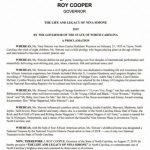
The Nina Simone Project (NSP) is proud to announce a $2 million capital fund campaign to underwrite the construction of the Nina Simone Archive
For more information visit here.
